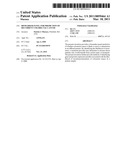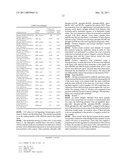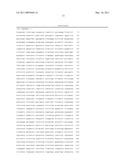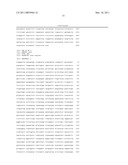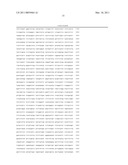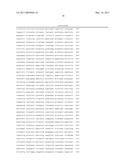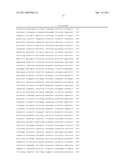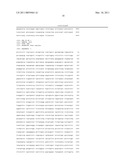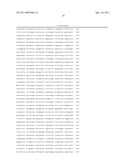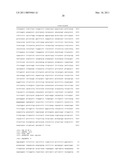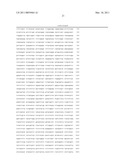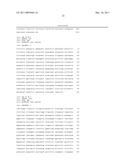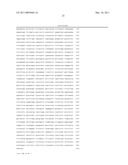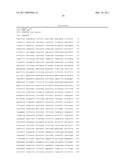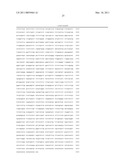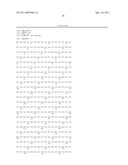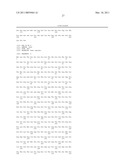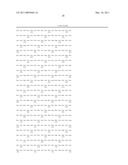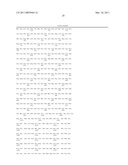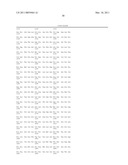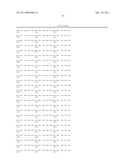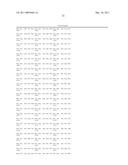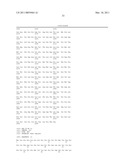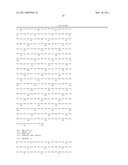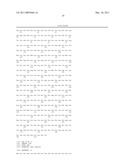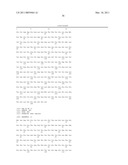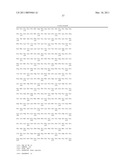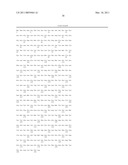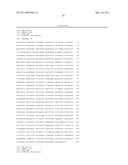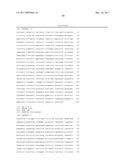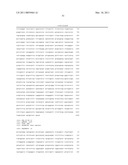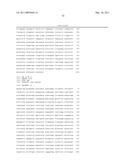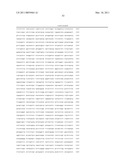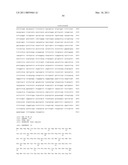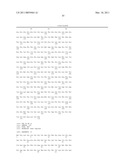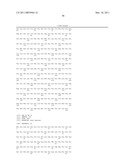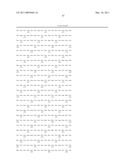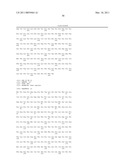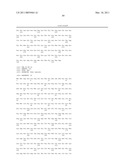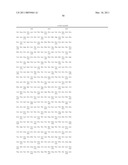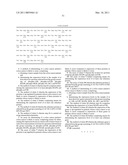Patent application title: Biomarker Panel For Prediction Of Recurrent Colorectal Cancer
Inventors:
Patrick J. Muraca (Pittsfield, MA, US)
Patrick J. Muraca (Pittsfield, MA, US)
IPC8 Class: AG01N3353FI
USPC Class:
435 71
Class name: Chemistry: molecular biology and microbiology measuring or testing process involving enzymes or micro-organisms; composition or test strip therefore; processes of forming such composition or test strip involving antigen-antibody binding, specific binding protein assay or specific ligand-receptor binding assay
Publication date: 2011-03-10
Patent application number: 20110059464
Claims:
1. A method of determining if a colon cancer patient's colon cancer is
likely to recur, comprisinga. obtaining a tumor sample from the colon
cancer patient; andb. determining the expression levels in the sample of
at least about two proteins selected from the group consisting of:
phospho-AIK, phospho-mTOR, phospho MAPK, phospho-MEK, phospho-S6; AKT,
and SSTR1.
2. The method of claim 1 wherein step (b) comprises determining the expression level of at least phospho-MAPK and phospho-mTOR.
3. The method of claim 1 wherein the expression of the proteins is up-regulated in patients whose colon cancer is not likely to recur compared to expression of these proteins in patients whose cancer is likely to recur.
4. The method of claim 1 further comprising means for determining the expression level of at least one reference protein.
5. The method of claim 4 wherein the reference protein is selected from the group consisting of: ACTB, GAPD, GUSB, RPLP0 and TRFC.
6. The method of claim 1 wherein step (b) is carried out using immunohistochemistry.
7. An assay for determining if a colon cancer patient's colon cancer is likely to recur, comprising means for determining the expression levels in a tumor cell or tumor tissue of said colon cancer patient of at least two proteins selected from the group consisting of: phospho-mTOR, phospho-pTEN, phospho-MAPK, phospho-IGFR/InR and phospho-EGFR.
8. The assay of claim 7 wherein the expression of the proteins is up-regulated in patients whose colon cancer is not likely to recur compared to expression of these proteins in patients whose cancer is likely to recur.
9. The assay of claim 7 wherein the at least two proteins comprise phospho-MAPK and phospho-mTOR.
10. The assay of claim 7 further comprising means for determining the expression level of at least one reference protein.
11. The assay of claim 10 wherein the reference protein is selected from the group consisting of: ACTB, GAPD, GUSB, RPLP0 and TRFC.
12. A method of determining if a colon cancer patient's colon cancer is likely to recur, comprising:a. obtaining a tumor sample from the colon cancer patient; andb. determining the expression levels in the sample of at least about two genes selected from the group consisting of: AIK, mTOR, MAPK, MEK, S6; AKT, and SSTR1.
13. The method of claim 12 wherein step (b) comprises determining the expression of at least MAPK and mTOR.
14. The method of claim 12 wherein the expression of the genes is up-regulated in patients whose colon cancer is not likely to recur compared to expression of these genes in patients whose cancer is likely to recur.
15. The method of claim 12 further comprising means for determining the expression level of at least one reference gene.
16. The method of claim 15 wherein the reference gene is selected from the group consisting of: ACTB, GAPD, GUSB, RPLP0 and TRFC.
17-20. (canceled)
Description:
RELATED APPLICATIONS
[0001]This application claims priority under 35 U.S.C. §119(e) to U.S. provisional Application Ser. No. 61/123,376, filed Apr. 8, 2008, the entirety of which is incorporated herein by reference.
BACKGROUND OF THE INVENTION
[0002]Treatment of recurrent colon cancer depends on the sites of recurrent disease demonstrable by physical examination and/or radiographic studies. In addition to standard radiographic procedures, radioimmunoscintography may add clinical information which may affect management. Serafini, et al., "Radioimmunoscintigraphy of recurrent, metastatic, or occult colorectal cancer with technetium 99m-labled totally human monoclonal antibody 88BV59: results of pivotal, phase III multicenter studies." Journal of Clinical Oncology, 16(5): 1777-1787 (1998). However, such approaches have not led to improvements in long-term outcome measures such as survival.
[0003]Recurrence of colon cancer often occurs at sites and in tissues other than the site of the primary tumor (referred to as metastasis). Treatments of liver metastases of colorectal cancer include resection of metastases, cryotherapy, and/or intra-arterial chemotherapy using improved implantable infusion ports and pumps. Kemen, et al., "Randomized trial of hepatic arterial floxuridine, mitomycin, and carmustine versus floxuridine alone in previously treated patients with liver metastases from colorectal cancer." Journal of Clinical Oncology, 11(2): 330-335, (1993); Pedersen et al., "Resection of liver metastases from colorectal cancer: indications and results." Diseases of the Colon and Rectum, 37(11): 1078-1082 (1994); Korpan, "Hepatic cryosurgery for liver metastases: long-term follow-up." Annals of Surgery, 225(2): 193-201 (1997); Adam R, Akpinar, et al., "Place of cryosurgery in the treatment of malignant liver tumors. Annals of Surgery, 225(1): 39-50 (1997). For those patients with hepatic metastases deemed unresectable, cryosurgical ablation has been associated with long term tumor control. Prognostic variables that predict a favorable outcome for cryotherapy are similar to those for hepatic resection and include low preoperative carcinoembryonic antigen level, absence of extrahepatic disease, negative margin, and lymph node negative primary. Seifert, et al., "Prognostic factors after cryotherapy for hepatic metastases from colorectal cancer." Annals of Surgery, 228(2): 201-208 (1998).
[0004]Locally recurrent colon cancer, such as a suture line recurrence, may be resectable, particularly if an inadequate prior operation was performed. Limited pulmonary metastases may also be considered for surgical resection, with 5-year survival possible in highly selected patients. McAfee, et al., "Colorectal lung metastases: results of surgical excision." Annals of Thoracic Surgery, 53(5): 780-786 (1992); Girard, et al., "Surgery for lung metastases from colorectal cancer: analysis of prognostic factors." Journal of Clinical Oncology, 14(7): 2047-2053 (1996).
[0005]In stage 1V and recurrent colon cancer, chemotherapy has been used for palliation, with fluorouracil (5-FU)-based treatment considered to be standard. Moertel, "Chemotherapy for colorectal cancer." New England Journal of Medicine, 330(16): 1136-1142 (1994). Combination chemotherapy has not been shown to be more effective than 5-FU alone. 5-FU has been shown to be more cytotoxic, with increased response rates but with variable effects on survival, when modulated by leucovorin, methotrexate, or other agents. Valone, et al., "Treatment of patients with advanced colorectal carcinomas with fluorouracil alone, high-dose leucovorin plus fluorouracil, or sequential methotrexate, fluorouracil, and leucovorin: a randomized trial of the Northern California Oncology Group." Journal of Clinical Oncology, 7(10): 1427-1436 (1989); Jager, et al, "Weekly high-dose leucovorin versus low-dose leucovorin combined with fluorouracil in advanced colorectal cancer: results of a randomized multicenter trial." Journal of Clinical Oncology, 14(8): 2274-2279 (1996); The Advanced Colorectal Cancer Meta-Analysis Project: Meta-analysis of randomized trials testing the biochemical modulation of fluorouracil by methotrexate in metastatic colorectal cancer. Journal of Clinical Oncology, 12(5): 960-969 (1994).
[0006]Interferon alfa appears to add toxic effects but no clinical benefit to 5-FU therapy. Kosmidis, et al., "Fluorouracil and leucovorin with or without interferon alfa-2b in advanced colorectal cancer: analysis of a prospective randomized phase III trial." Journal of Clinical Oncology, 14(10): 2682-2687 (1996); Greco, et al., "Phase III randomized study to compare interferon alfa-2a in combination with fluorouracil versus fluorouracil alone in patients with advanced colorectal cancer." Journal of Clinical Oncology, 14(10): 2674-2681 (1996). Continuous-infusion 5-FU regimens have also resulted in increased response rates in some studies, with a modest benefit in median survival. Hansen, et al. "Phase III study of bolus versus infusion fluorouracil with or without cisplatin in advanced colorectal cancer." Journal of the National Cancer Institute, 88(10): 668-674 (1996); Aranda, et al., "Randomized trial comparing monthly low-dose leucovorin and fluorouracil bolus with weekly high-dose 48-hour continuous infusion fluorouracil for advanced colorectal cancer: a Spanish Cooperative Group for Gastrointestinal Tumor Therapy (TTD) study." Annals of Oncology, 9(7): 727-731 (1998). The choice of a 5-FU-based chemotherapy regimen for an individual patient should be based on known response rates and the toxic effects profile of the chosen regimen, as well as cost and quality-of-life issues. Leichman, et al., "Phase II study of fluorouracil and its modulation in advanced colorectal cancer: a Southwest Oncology Group study." Journal of Clinical Oncology, 13(6): 1303-1311 (1995).
[0007]Irinotecan is a topoisomerase-I inhibitor with a 10% to 20% partial response rate in patients with metastatic colon cancer, in patients who have received no prior chemotherapy, and in patients progressing on 5-FU therapy. It is now considered standard therapy for patients with stage 1V disease who do not respond to or progress on 5-FU. Cunningham, et al. "A phase III multicenter randomized study of CPT-11 versus supportive care (SC) alone in patients (Pts) with 5FU-resistant metastatic colorectal cancer (MCRC)."Proceedings of the American Society of Clinical Oncology, 17: A-1, 1a (1998). Another drug, Tomudex, is a specific thymidylate synthase inhibitor which has demonstrated activity similar to that of bolus 5-FU and leucovorin. Cunningham D, "Mature results from three large controlled studies with raltitrexed (`Tomudex`)." British Journal of Cancer, 77(Suppl 2): 15-21 (1998); Cocconi, et al., "Open, randomized, multicenter trial of raltitrexed versus fluorouracil plus high-dose leucovorin in patients with advanced colorectal cancer." Journal of Clinical Oncology, 16(9): 2943-2952, (1998). Oxaliplatin plus 5-FU and leucovorin has also shown activity in 5-FU refractory patients. Von Hoff DD, "Promising new agents for treatment of patients with colorectal cancer. Seminars in Oncology, 25(5, suppl 11): 47-52 (1998); de Gramont, et al., "Oxaliplatin with high-dose leucovorin and 5-fluorouracil 48-hour continuous infusion in pretreated metastatic colorectal cancer." European Journal of Cancer, 33(2): 214-219 (1997).
[0008]Patients with advanced colon cancer who have relapsed after either adjuvant therapy or treatment for advanced disease with 5-FU and leucovorin may be considered for additional therapy. A number of approaches have been used in the treatment of such patients, including retreatment with 5-FU and treatment with irinotecan. Patients retreated with bolus or infusional 5-FU following adjuvant 5-FU therapy or discontinuation of 5-FU in responding patients with metastatic disease have response rates and response durations similar to previously untreated patients. Goldberg R M, "Is repeated treatment with a 5-fluorouracil-based regimen useful in colorectal cancer?" Seminars in Oncology, 25(5, suppl 11): 21-28 (1998). Irinotecan has been compared to either retreatment with 5-FU or best supportive care in a pair of randomized European trials of patients with colorectal cancer refractory to 5-FU. In both trials, there was a survival and quality of life advantage for patients treated with irinotecan over 5-FU or supportive care. Rougier, et al., "Randomised trial of irinotecan versus fluorouracil by continuous infusion after fluorouracil failure in patients with metastatic colorectal cancer." Lancet, 352(9138): 1407-1412 (1998); Cunningham, et al., "Randomised trial of irinotecan plus supportive care versus supportive care alone after fluorouracil failure for patients with metastatic colorectal cancer." Lancet, 352(9138): 1413-1418 (1998).
SUMMARY OF THE INVENTION
[0009]The present invention provides gene and protein expression profiles and methods for using them to identify those patients who are likely to experience a recurrence and/or metastasis of their colon cancer after treatment of the primary tumor, as well as those patients that are not likely to experience a recurrence of their cancer. The present invention allows a treatment provider to identify those patients who are most likely to experience recurrence, and to adjust treatment options for such patients accordingly.
[0010]In one aspect, the present invention comprises protein expression profiles that are indicative of the likelihood that a colon cancer patient's disease will recur/metastasize. The protein expression profiles comprise proteins that are differentially expressed in colon cancer patients whose disease is unlikely to recur after treatment of the primary tumor. The present protein expression profile (PEP) comprises at least one, and preferably a plurality, of proteins selected from the group consisting of: phospho-AIK, phospho-mTOR, phospho MAPK, phospho-MEK, phospho-S6, AKT, and SSTR1. All of these proteins are up-regulated (overexpressed) in the colon tumors of patients whose colon cancer is are not likely to recur and/or metastasize.
[0011]The present invention further comprises gene expression profiles, also referred to as "gene signatures," that are indicative of the likelihood that a patient's colon cancer will recur/metastasize after treatment of the primary tumor. The gene expression profile (GEP) comprises at least one, and preferably a plurality, of genes selected from the group consisting of genes encoding the following proteins: AIK, mTOR, MAPK, MEK, S6, AKT and SSTR1. These genes are up-regulated (over-expressed) in the tumors of those patients whose cancer is not likely to recur after treatment of the primary tumor.
[0012]The present gene and protein expression profiles further may include reference or control genes and the proteins expressed thereby. The currently preferred reference genes are ACTB, GAPD, GUSB, RPLP0 and TFRC. According to the invention, some or all of theses genes and their encoded proteins are differentially expressed (e.g., up-regulated or down-regulated) in patients whose colon cancer is not likely to recur after treatment for the primary tumor. Specifically, all of these genes and their encoded proteins are up-regulated (over-expressed) in patients at low risk of recurrence of their colon cancer after treatment of the primary tumor.
[0013]The gene and protein expression profiles of the present invention (referred to hereinafter as GPEPs) comprise a group of genes and proteins that are up-regulated in colon cancer patients whose cancers are unlikely to recur/metastasize after treatment of the primary tumor, relative to expression of the same genes in the primary colon tumors of patients whose cancers are likely to recur/metastasize. The GPEPs of the present invention thus can be used to predict the likelihood of recurrence of the cancer and/or disease-related death. The present GPEP also can be used to identify those colon cancer patients most likely to respond to standard therapy of their primary tumors, as well as those requiring adjuvant therapies.
[0014]The present invention further comprises a method of determining if a colon cancer patient's disease is of a type that is likely to recur/metastasize after treatment of the primary tumor. The method comprises obtaining a tumor sample from the patient, determining the gene and/or protein expression profile of the sample, and determining from the gene or protein expression profile whether at least about 2, preferably at least about 4, and most preferably about 7 of the genes that encode the proteins selected from the group consisting of: AIK, mTOR, MAPK, MEK, S6, AKT and SSTR1, or whether at least about 2, preferably at least about 4, and most preferably about 7 proteins selected from the group consisting of: phospho-AIK, phospho-mTOR, phospho MAPK, phospho-MEK, phospho-S6, AKT, and SSTR1, are differentially expressed in the sample. From this information, the treatment provider can ascertain whether the patient's disease is likely to recur and/or metastasize, and tailor the patient's treatment accordingly.
[0015]The present invention further comprises assays for determining the gene and/or protein expression profile in a patient's sample, and instructions for using the assay. The assay may be based on detection of nucleic acids (e.g., using nucleic acid probes specific for the nucleic acids of interest) or proteins or peptides (e.g., using antibodies specific for the proteins/peptides of interest). In a currently preferred embodiment, the assay comprises an immunohistochemistry (IHC) test in which tissue samples, preferably from the primary resected tumor, are contacted with antibodies specific for the proteins/peptides identified in the GPEP as being indicative of the likelihood of recurrence/metastasis of colon cancer in the patient after treatment of the primary tumor.
[0016]The GPEP, method and assay of the present invention can be used to accurately predict whether a colon cancer patient's disease is likely to recur and/or metastasize. This knowledge allows the patient and caregiver to make better clinical decisions, e.g., frequency of monitoring, administration of adjuvant radiation or chemotherapy, or design of an appropriate therapeutic regimen.
DETAILED DESCRIPTION
[0017]The present invention provides gene and protein expression profiles and their use for predicting the likelihood of recurrence and/or metastasis of colon cancer after treatment of the primary tumor. More specifically, the present GPEPs are indicative of whether colon cancer is likely to recur in the patient's colorectal tissue or metastasize (recur at a different site, such as the liver or lung), after treatment of the primary tumor.
[0018]Treatment of recurrent/metastatic colon cancer depends on the sites of recurrent disease. Recurrence currently is determined mainly by physical examination and/or radiographic studies; radioimmunoscintography may add additional clinical information which affects management of the disease. However, these approaches have not led to improvements in long-term outcome measures such as survival. The GPEP of the present invention provides the clinician with a prognostic tool capable of providing valuable information that can positively affect management of the disease. Oncologists can assay the primary tumor for the presence of the present GPEP, and which can identify with a high degree of accuracy those patients whose disease is likely to recur or metastasize. This information, taken together with other available clinical information, allows more effective management of the disease.
[0019]In a preferred aspect of the invention, the expression of proteins in a tumor sample from a colon cancer patient is assayed using immunohistochemistry techniques to identify the expression of proteins in the present GPEP. The protein expression profile comprises at least two, preferably a plurality, and most preferably all, of the proteins selected from the group consisting of phospho-AIK, phospho-mTOR, phospho-MAPK, phospho MEK, phospho-S6, AKT and SSTR1. According to the invention, some or all of these proteins are differentially expressed in patients who are least at risk for recurrence/metastasis of their colon cancer. Specifically, these proteins are up-regulated (over-expressed) in patients who are not likely to experience recurrence/metastasis of their disease.
[0020]In this embodiment, the method comprises (a) obtaining a biological sample (preferably primary resected tumor) of a patient afflicted with colon cancer; (b) contacting the sample with nucleic acid probes or antibodies specific for the following proteins: phospho-AIK, phospho-mTOR, phospho-MAPK, phospho MEK, phospho-S6, AKT and SSTR1; and (c) determining whether two or more of these proteins are up-regulated (over-expressed). The predictive value of the PEP for determining the likelihood of recurrence increases with the number of these proteins that are found to be up-regulated. Preferably, at least about two, more preferably at least about four, and most preferably about seven, of these proteins in the present GPEP are overexpressed. In a preferred embodiment, samples of normal (undiseased) colon margin tissue (tissue form the patient's colon surrounding the tumor site) as well as other control tissues are assayed simultaneously, using the same reagents and under the same conditions, with the primary tumor sample. Preferably, expression of at least two reference proteins also is measured at the same time and under the same conditions.
[0021]In an alternative embodiment, the present invention comprises gene expression profiles that are indicative of the likelihood of recurrence/metastasis of disease in a colon cancer patient. In this embodiment, the present method comprises (a) obtaining a biological sample (preferably primary resected tumor) of a patient afflicted with colon cancer; (b) contacting the sample with nucleic acid probes specific for the following genes: AIK, mTOR, MAPK, MEK, S6, AKT and SSTR1; and (c) determining whether two or more of these genes are up-regulated (over-expressed). The predictive value of the gene profile for determining the likelihood of recurrence increases with the number of these genes that are found to be up-regulated in accordance with the invention. Preferably, at least about two, more preferably at least about four, and most preferably about seven, of the genes in the present GPEP are differentially expressed. The biological sample preferably is a sample of the patient's primary resected tumor; normal (undiseased) marginal colon tissue from the same patient is used as a control. Preferably, expression of at least two reference genes also is measured.
[0022]In a currently preferred embodiment, the present gene and protein expression profiles further may include determining the expression levels of reference or control genes and the proteins. The currently preferred reference genes are ACTB, GAPD, GUSB, RPLP0 and TFRC. According to the invention, some or all of theses genes and their encoded proteins are differentially expressed (e.g., up-regulated or down-regulated) in patients whose colon cancer is not likely to recur after treatment for the primary tumor.
[0023]The present invention further comprises assays for determining the gene and/or protein expression profile in a patient's sample, and instructions for using the assay. The assay may be based on detection of nucleic acids (e.g., using nucleic acid probes specific for the nucleic acids of interest) or proteins or peptides (e.g., using nucleic acid probes or antibodies specific for the proteins/peptides of interest). In a currently preferred embodiment, the assays comprises an immunohistochemistry (IHC) test in which tissue samples, preferably arrayed in a tissue microarray (TMA), and are contacted with antibodies specific for the proteins/peptides identified in the GPEP as being indicative of the likelihood of recurrence/metastasis of colon cancer in patient after treatment of the primary tumor.
[0024]Table 1 identifies the genes and the (unphosphorylated) protein encoded thereby in the present GPEP. Table 1 also indicates whether expression of the gene and protein is up- or down-regulated in patients unlikely to experience recurrence or metastasis of their disease.
[0025]Table 2 identifies the five preferred reference genes and the protein encoded thereby. Table 2 also indicates whether expression of the reference gene and protein is up- or down-regulated in patients unlikely to experience recurrence or metastasis of their disease.
[0026]Tables 1 and 2 include the NCBI Accession No. of a variant of each gene and protein; other variants of these genes and proteins exist, which can be readily ascertained by reference to an appropriate database such as NCBI Entrez (available via the NIH website). Alternate names for the genes and proteins listed in Table 1 also can be determined from the NCBI site.
TABLE-US-00001 TABLE 1 Gene SEQ ID NO. Encoded Protein SEQ ID NO. Accession No. for Gene Accession No. for Protein AURKA 1 AIK 8 NM _198433.1 NP_940835.1 FRAP1 2 mTOR 9 NM_004958.2 NP_004949.1 MAPK1 3 MAPK 10 NM_002745.4 NP_002736.3 MAP2K1 4 MEK 11 NM_002755.3 4 NP_0002746.1 11 RPS6 5 S6 12 NM_001010.2 5 NP_001001.2 12 AKT 6 AKT 13 NM_005163.2 6 NP_005154.2 13 SSTR1 7 SSTR1 14 NM_001049.2 7 NP_001040.1 14
TABLE-US-00002 TABLE 2 Gene SEQ ID NO. Encoded Protein SEQ ID NO. Accession No. for Gene Accession No. for Protein ACTB 15 β-Actin 20 NM_001101.3 NP_001092.1 GAPD 16 GAPD 21 NM_002046.3 NP_002037.2 GUSB 17 GUS 22 NM_000181.2 NP_000172.1 RPLP0 18 Ribosomal protein P0 23 NM_001002.3 NP_000993.1 TFRC 19 Transferrin receptor 24 NM_003234.1 NP_003225.1
[0027]All of the genes and proteins listed in Tables 1 and 2 are up-regulated (overexpressed) in the colon tumors of patients whose colon cancer is are not likely to recur and/or metastasize.
DEFINITIONS
[0028]For convenience, the meaning of certain terms and phrases employed in the specification, examples, and appended claims are provided below. The definitions are not meant to be limiting in nature and serve to provide a clearer understanding of certain aspects of the present invention.
[0029]The term "genome" is intended to include the entire DNA complement of an organism, including the nuclear DNA component, chromosomal or extrachromosomal DNA, as well as the cytoplasmic domain (e.g., mitochondrial DNA).
[0030]The term "gene" refers to a nucleic acid sequence that comprises control and coding sequences necessary for producing a polypeptide or precursor. The polypeptide may be encoded by a full length coding sequence or by any portion of the coding sequence. The gene may be derived in whole or in part from any source known to the art, including a plant, a fungus, an animal, a bacterial genome or episome, eukaryotic, nuclear or plasmid DNA, cDNA, viral DNA, or chemically synthesized DNA. A gene may contain one or more modifications in either the coding or the untranslated regions that could affect the biological activity or the chemical structure of the expression product, the rate of expression, or the manner of expression control. Such modifications include, but are not limited to, mutations, insertions, deletions, and substitutions of one or more nucleotides. The gene may constitute an uninterrupted coding sequence or it may include one or more introns, bound by the appropriate splice junctions. The Term "gene" as used herein includes variants of the genes identified in Table 1.
[0031]The term "gene expression" refers to the process by which a nucleic acid sequence undergoes successful transcription and translation such that detectable levels of the nucleotide sequence are expressed.
[0032]The terms "gene expression profile" or "gene signature" refer to a group of genes expressed by a particular cell or tissue type wherein presence of the genes taken together or the differential expression of such genes, is indicative/predictive of a certain condition.
[0033]The term "nucleic acid" as used herein, refers to a molecule comprised of one or more nucleotides, i.e., ribonucleotides, deoxyribonucleotides, or both. The term includes monomers and polymers of ribonucleotides and deoxyribonucleotides, with the ribonucleotides and/or deoxyribonucleotides being bound together, in the case of the polymers, via 5' to 3' linkages. The ribonucleotide and deoxyribonucleotide polymers may be single or double-stranded. However, linkages may include any of the linkages known in the art including, for example, nucleic acids comprising 5' to 3' linkages. The nucleotides may be naturally occurring or may be synthetically produced analogs that are capable of forming base-pair relationships with naturally occurring base pairs. Examples of non-naturally occurring bases that are capable of forming base-pairing relationships include, but are not limited to, aza and deaza pyrimidine analogs, aza and deaza purine analogs, and other heterocyclic base analogs, wherein one or more of the carbon and nitrogen atoms of the pyrimidine rings have been substituted by heteroatoms, e.g., oxygen, sulfur, selenium, phosphorus, and the like. Furthermore, the term "nucleic acid sequences" contemplates the complementary sequence and specifically includes any nucleic acid sequence that is substantially homologous to the both the nucleic acid sequence and its complement.
[0034]The terms "array" and "microarray" refer to the type of genes or proteins represented on an array by oligonucleotides or protein-capture agents, and where the type of genes or proteins represented on the array is dependent on the intended purpose of the array (e.g., to monitor expression of human genes or proteins). The oligonucleotides or protein-capture agents on a given array may correspond to the same type, category, or group of genes or proteins. Genes or proteins may be considered to be of the same type if they share some common characteristics such as species of origin (e.g., human, mouse, rat); disease state (e.g., cancer); functions (e.g., protein kinases, tumor suppressors); or same biological process (e.g., apoptosis, signal transduction, cell cycle regulation, proliferation, differentiation). For example, one array type may be a "cancer array" in which each of the array oligonucleotides or protein-capture agents correspond to a gene or protein associated with a cancer. An "epithelial array" may be an array of oligonucleotides or protein-capture agents corresponding to unique epithelial genes or proteins. Similarly, a "cell cycle array" may be an array type in which the oligonucleotides or protein-capture agents correspond to unique genes or proteins associated with the cell cycle.
[0035]The term "cell type" refers to a cell from a given source (e.g., a tissue, organ) or a cell in a given state of differentiation, or a cell associated with a given pathology or genetic makeup.
[0036]The term "activation" as used herein refers to any alteration of a signaling pathway or biological response including, for example, increases above basal levels, restoration to basal levels from an inhibited state, and stimulation of the pathway above basal levels.
[0037]The term "differential expression" refers to both quantitative as well as qualitative differences in the temporal and tissue expression patterns of a gene or a protein in diseased tissues or cells versus normal adjacent tissue. For example, a differentially expressed gene may have its expression activated or completely inactivated in normal versus disease conditions, or may be up-regulated (over-expressed) or down-regulated (under-expressed) in a disease condition versus a normal condition. Such a qualitatively regulated gene may exhibit an expression pattern within a given tissue or cell type that is detectable in either control or disease conditions, but is not detectable in both. Stated another way, a gene or protein is differentially expressed when expression of the gene or protein occurs at a higher or lower level in the diseased tissues or cells of a patient relative to the level of its expression in the normal (disease-free) tissues or cells of the patient and/or control tissues or cells.
[0038]The term "detectable" refers to an RNA expression pattern which is detectable via the standard techniques of polymerase chain reaction (PCR), reverse transcriptase-(RT) PCR, differential display, and Northern analyses, which are well known to those of skill in the art. Similarly, protein expression patterns may be "detected" via standard techniques such as Western blots.
[0039]The term "complementary" refers to the topological compatibility or matching together of the interacting surfaces of a probe molecule and its target. The target and its probe can be described as complementary, and furthermore, the contact surface characteristics are complementary to each other. Hybridization or base pairing between nucleotides or nucleic acids, such as, for example, between the two strands of a double-stranded DNA molecule or between an oligonucleotide probe and a target are complementary.
[0040]The term "biological sample" refers to a sample obtained from an organism (e.g., a human patient) or from components (e.g., cells) of an organism. The sample may be of any biological tissue or fluid. The sample may be a "clinical sample" which is a sample derived from a patient. Such samples include, but are not limited to, sputum, blood, blood cells (e.g., white cells), amniotic fluid, plasma, semen, bone marrow, and tissue or fine needle biopsy samples, urine, peritoneal fluid, and pleural fluid, or cells therefrom. Biological samples may also include sections of tissues such as frozen sections taken for histological purposes. A biological sample may also be referred to as a "patient sample."
[0041]A "protein" means a polymer of amino acid residues linked together by peptide bonds. The term, as used herein, refers to proteins, polypeptides, and peptides of any size, structure, or function. Typically, however, a protein will be at least six amino acids long. If the protein is a short peptide, it will be at least about 10 amino acid residues long. A protein may be naturally occurring, recombinant, or synthetic, or any combination of these. A protein may also comprise a fragment of a naturally occurring protein or peptide. A protein may be a single molecule or may be a multi-molecular complex. The term protein may also apply to amino acid polymers in which one or more amino acid residues is an artificial chemical analogue of a corresponding naturally occurring amino acid.
[0042]A "fragment of a protein," as used herein, refers to a protein that is a portion of another protein. For example, fragments of proteins may comprise polypeptides obtained by digesting full-length protein isolated from cultured cells. In one embodiment, a protein fragment comprises at least about six amino acids. In another embodiment, the fragment comprises at least about ten amino acids. In yet another embodiment, the protein fragment comprises at least about sixteen amino acids.
[0043]As used herein, an "expression product" is a biomolecule, such as a protein, which is produced when a gene in an organism is expressed. An expression product may comprise post-translational modifications.
[0044]The term "metastasis" means the process by which cancer spreads from the place at which it first arose as a primary tumor to distant locations in the body. Metastasis also refers to cancers resulting from the spread of the primary tumor. For example, someone with colon cancer may show metastases in their liver or lungs.
[0045]The term "protein expression" refers to the process by which a nucleic acid sequence undergoes successful transcription and translation such that detectable levels of the amino acid sequence or protein are expressed.
[0046]The terms "protein expression profile" or "protein expression signature" refer to a group of proteins expressed by a particular cell or tissue type (e.g., neuron, coronary artery endothelium, or disease tissue), wherein presence of the proteins taken together or the differential expression of such proteins, is indicative/predictive of a certain condition.
[0047]The term "antibody" means an immunoglobulin, whether natural or partially or wholly synthetically produced. All derivatives thereof that maintain specific binding ability are also included in the term. The term also covers any protein having a binding domain that is homologous or largely homologous to an immunoglobulin binding domain. An antibody may be monoclonal or polyclonal. The antibody may be a member of any immunoglobulin class, including any of the human classes: IgG, IgM, IgA, IgD, and IgE.
[0048]The term "antibody fragment" refers to any derivative of an antibody that is less than full-length. In one aspect, the antibody fragment retains at least a significant portion of the full-length antibody's specific binding ability, specifically, as a binding partner. Examples of antibody fragments include, but are not limited to, Fab, Fab', F(ab')2, scFv, Fv, dsFv diabody, and Fd fragments. The antibody fragment may be produced by any means. For example, the antibody fragment may be enzymatically or chemically produced by fragmentation of an intact antibody or it may be recombinantly produced from a gene encoding the partial antibody sequence. Alternatively, the antibody fragment may be wholly or partially synthetically produced. The antibody fragment may comprise a single chain antibody fragment. In another embodiment, the fragment may comprise multiple chains that are linked together, for example, by disulfide linkages. The fragment may also comprise a multimolecular complex. A functional antibody fragment may typically comprise at least about 50 amino acids and more typically will comprise at least about 200 amino acids.
[0049]Determination of Gene Expression Profiles
[0050]The method used to identify and validate the present gene expression profiles indicative of whether a colon cancer patient's disease is likely to recur and/or metastasize is described below. Other methods for identifying gene and/or protein expression profiles are known; any of these alternative methods also could be used. See, e.g., Chen et al., NEJM, 356(1):11-20 (2007); Lu et al., PLOS Med., 3(12):e467 (2006); Wang et al., J. Clin. Oncol., 2299):1564 (2004); Golub et al., Science, 286:531-537 (1999).
[0051]The present method utilizes parallel testing in which, in one track, those genes are identified which are over-/under-expressed as compared to normal (non-cancerous) tissue and/or disease tissue from patients that experienced different outcomes; and, in a second track, those genes are identified comprising chromosomal insertions or deletions as compared to the same normal and disease samples. These two tracks of analysis produce two sets of data. The data are analyzed and correlated using an algorithm which identifies the genes of the gene expression profile (i.e., those genes that are differentially expressed in the cancer tissue of interest). Positive and negative controls may be employed to normalize the results, including eliminating those genes and proteins that also are differentially expressed in normal tissues from the same patients, and is disease tissue having a different outcome, and confirming that the gene expression profile is unique to the cancer of interest.
[0052]In the present instance, as an initial step, biological samples were acquired from patients afflicted with colorectal cancer. Tissue samples were obtained from patients diagnosed as having colon cancer, including samples of the primary resected tumor, metastatic lymph nodes and normal (undiseased) marginal colon tissue from each patient. Clinical information associated with each sample, including treatment with chemotherapeutic drugs, surgery, radiation or other treatment, outcome of the treatments and recurrence or metastasis of the disease, had been recorded in a database. Clinical information also includes information such as age, sex, medical history, treatment history, symptoms, family history, recurrence (yes/no), etc. Samples of normal (non-cancerous) tissue of different types (e.g., lung, brain, prostate) as well as samples of non-colon cancers (e.g., melanoma, breast cancer, ovarian cancer) were used as positive controls. Samples of normal undiseased colon tissue from a set of healthy individuals were used as positive controls, and colon tumor samples from patients whose cancer did recur/metastasize were used as negative controls.
[0053]Gene expression profiles (GEPs) then were generated from the biological samples based on total RNA according to well-established methods. Briefly, a typical method involves isolating total RNA from the biological sample, amplifying the RNA, synthesizing cDNA, labeling the cDNA with a detectable label, hybridizing the cDNA with a genomic array, such as the Affymetrix U133 GeneChip, and determining binding of the labeled cDNA with the genomic array by measuring the intensity of the signal from the detectable label bound to the array. See, e.g., the methods described in Lu, et al., Chen, et al. and Golub, et al., supra, and the references cited therein, which are incorporated herein by reference. The resulting expression data were input into a database.
[0054]MRNAs in the tissue samples can be analyzed using commercially available or customized probes or oligonucleotide arrays, such as cDNA or oligonucleotide arrays. The use of these arrays allows for the measurement of steady-state mRNA levels of thousands of genes simultaneously, thereby presenting a powerful tool for identifying effects such as the onset, arrest or modulation of uncontrolled cell proliferation. Hybridization and/or binding of the probes on the arrays to the nucleic acids of interest from the cells can be determined by detecting and/or measuring the location and intensity of the signal received from the labeled probe or used to detect a DNA/RNA sequence from the sample that hybridizes to a nucleic acid sequence at a known location on the microarray. The intensity of the signal is proportional to the quantity of cDNA or mRNA present in the sample tissue. Numerous arrays and techniques are available and useful. Methods for determining gene and/or protein expression in sample tissues are described, for example, in U.S. Pat. No. 6,271,002; U.S. Pat. No. 6,218,122; U.S. Pat. No. 6,218,114; and U.S. Pat. No. 6,004,755; and in Wang et al., J. Clin. Oncol., 22(9):1564-1671 (2004); Golub et al, (supra); and Schena et al., Science, 270:467-470 (1995); all of which are incorporated herein by reference.
[0055]The gene analysis aspect utilized in the present method investigates gene expression as well as insertion/deletion data. As a first step, RNA was isolated from the tissue samples and labeled. Parallel processes were run on the sample to develop two sets of data: (1) over-/under-expression of genes based on mRNA levels; and (2) chromosomal insertion/deletion data. These two sets of data were then correlated by means of an algorithm. Over-/under-expression of the genes in each cancer tissue sample were compared to gene expression in the normal (non-cancerous) samples and other control samples, and a subset of genes that were differentially expressed in the cancer tissue was identified. Preferably, levels of up- and down-regulation are distinguished based on fold changes of the intensity measurements of hybridized microarray probes. A difference of about 2.0 fold or greater is preferred for making such distinctions, or a p-value of less than about 0.05. That is, before a gene is said to be differentially expressed in diseased versus normal cells, the diseased cell is found to yield at least about 2 times greater or less intensity of expression than the normal cells. Generally, the greater the fold difference (or the lower the p-value), the more preferred is the gene for use as a diagnostic or prognostic tool. Genes selected for the gene signatures of the present invention have expression levels that result in the generation of a signal that is distinguishable from those of the normal or non-modulated genes by an amount that exceeds background using clinical laboratory instrumentation.
[0056]Statistical values can be used to confidently distinguish modulated from non-modulated genes and noise. Statistical tests can identify the genes most significantly differentially expressed between diverse groups of samples. The Student's t-test is an example of a robust statistical test that can be used to find significant differences between two groups. The lower the p-value, the more compelling the evidence that the gene is showing a difference between the different groups. Nevertheless, since microarrays allow measurement of more than one gene at a time, tens of thousands of statistical tests may be asked at one time. Because of this, it is unlikely to observe small p-values just by chance, and adjustments using a Sidak correction or similar step as well as a randomization/permutation experiment can be made. A p-value less than about 0.05 by the t-test is evidence that the expression level of the gene is significantly different. More compelling evidence is a p-value less then about 0.05 after the Sidak correction is factored in. For a large number of samples in each group, a p-value less than about 0.05 after the randomization/permutation test is the most compelling evidence of a significant difference.
[0057]Another parameter that can be used to select genes that generate a signal that is greater than that of the non-modulated gene or noise is the measurement of absolute signal difference. Preferably, the signal generated by the differentially expressed genes differs by at least about 20% from those of the normal or non-modulated gene (on an absolute basis). It is even more preferred that such genes produce expression patterns that are at least about 30% different than those of normal or non-modulated genes.
[0058]This differential expression analysis can be performed using commercially available arrays, for example, Affymetrix U133 GeneChip® arrays (Affymetrix, Inc.). These arrays have probe sets for the whole human genome immobilized on the chip, and can be used to determine up- and down-regulation of genes in test samples. Other substrates having affixed thereon human genomic DNA or probes capable of detecting expression products, such as those available from Affymetrix, Agilent Technologies, Inc. or Illumina, Inc. also may be used. Currently preferred gene microarrays for use in the present invention include Affymetrix U133 GeneChip® arrays and Agilent Technologies genomic cDNA microarrays. Instruments and reagents for performing gene expression analysis are commercially available. See, e.g., Affymetrix GeneChip® System. The expression data obtained from the analysis then is input into the database.
[0059]In the second arm of the present method, chromosomal insertion/deletion data for the genes of each sample as compared to samples of normal tissue was obtained. The insertion/deletion analysis was generated using an array-based comparative genomic hybridization ("CGH"). Array CGH measures copy-number variations at multiple loci simultaneously, providing an important tool for studying cancer and developmental disorders and for developing diagnostic and therapeutic targets. Microchips for performing array CGH are commercially available, e.g., from Agilent Technologies. The Agilent chip is a chromosomal array which shows the location of genes on the chromosomes and provides additional data for the gene signature. The insertion/deletion data from this testing is input into the database.
[0060]The analyses are carried out on the same samples from the same patients to generate parallel data. The same chips and sample preparation are used to reduce variability.
[0061]The expression of certain genes known as "reference genes" "control genes" or "housekeeping genes" also is determined, preferably at the same time, as a means of ensuring the veracity of the expression profile. Reference genes are genes that are consistently expressed in many tissue types, including cancerous and normal tissues, and thus are useful to normalize gene expression profiles. See, e.g., Silvia et al., BMC Cancer, 6:200 (2006); Lee et al., Genome Research, 12(2):292-297 (2002); Zhang et al., BMC Mol. Biol., 6:4 (2005). Determining the expression of reference genes in parallel with the genes in the unique gene expression profile provides further assurance that the techniques used for determination of the gene expression profile are working properly. The expression data relating to the reference genes also is input into the database. In a currently preferred embodiment, the following genes are used as reference genes: ACTB, GAPD, GUSB, RPLP0 and/or TRFC.
[0062]Data Correlation
[0063]The differential expression data and the insertion/deletion data in the database are correlated with the clinical outcomes information associated with each tissue sample also in the database by means of an algorithm to determine a gene expression profile for determining therapeutic efficacy of irinotecan, as well as late recurrence of disease and/or disease-related death associated with irinotecan therapy. Various algorithms are available which are useful for correlating the data and identifying the predictive gene signatures. For example, algorithms such as those identified in Xu et al., A Smooth Response Surface Algorithm For Constructing A Gene Regulatory Network, Physiol. Genomics 11:11-20 (2002), the entirety of which is incorporated herein by reference, may be used for the practice of the embodiments disclosed herein.
[0064]Another method for identifying gene expression profiles is through the use of optimization algorithms such as the mean variance algorithm widely used in establishing stock portfolios. One such method is described in detail in the patent application US Patent Application Publication No. 2003/0194734. Essentially, the method calls for the establishment of a set of inputs expression as measured by intensity) that will optimize the return (signal that is generated) one receives for using it while minimizing the variability of the return. The algorithm described in Irizarry et al., Nucleic Acids Res., 31:e15 (2003) also may be used. The currently preferred algorithm is the JMP Genomics algorithm available from JMP Software.
[0065]The process of selecting gene expression profiles also may include the application of heuristic rules. Such rules are formulated based on biology and an understanding of the technology used to produce clinical results, and are applied to output from the optimization method. For example, the mean variance method of gene signature identification can be applied to microarray data for a number of genes differentially expressed in subjects with cancer. Output from the method would be an optimized set of genes that could include some genes that are expressed in peripheral blood as well as in diseased tissue. If samples used in the testing method are obtained from peripheral blood and certain genes differentially expressed in instances of cancer could also be differentially expressed in peripheral blood, then a heuristic rule can be applied in which a portfolio is selected from the efficient frontier excluding those that are differentially expressed in peripheral blood. Of course, the rule can be applied prior to the formation of the efficient frontier by, for example, applying the rule during data pre-selection.
[0066]Other heuristic rules can be applied that are not necessarily related to the biology in question. For example, one can apply a rule that only a certain percentage of the portfolio can be represented by a particular gene or group of genes. Commercially available software such as the Wagner software readily accommodates these types of heuristics (Wagner Associates Mean-Variance Optimization Application). This can be useful, for example, when factors other than accuracy and precision have an impact on the desirability of including one or more genes.
[0067]As an example, the algorithm may be used for comparing gene expression profiles for various genes (or portfolios) to ascribe prognoses. The gene expression profiles of each of the genes comprising the portfolio are fixed in a medium such as a computer readable medium. This can take a number of forms. For example, a table can be established into which the range of signals (e.g., intensity measurements) indicative of disease is input. Actual patient data can then be compared to the values in the table to determine whether the patient samples are normal or diseased. In a more sophisticated embodiment, patterns of the expression signals (e.g., fluorescent intensity) are recorded digitally or graphically. The gene expression patterns from the gene portfolios used in conjunction with patient samples are then compared to the expression patterns. Pattern comparison software can then be used to determine whether the patient samples have a pattern indicative of recurrence of the disease. Of course, these comparisons can also be used to determine whether the patient is not likely to experience disease recurrence. The expression profiles of the samples are then compared to the profile of a control cell. If the sample expression patterns are consistent with the expression pattern for recurrence of cancer then (in the absence of countervailing medical considerations) the patient is treated as one would treat a relapse patient. If the sample expression patterns are consistent with the expression pattern from the normal/control cell then the patient is diagnosed negative for the cancer.
[0068]A method for analyzing the gene signatures of a patient to determine prognosis of cancer is through the use of a Cox hazard analysis program. The analysis may be conducted using S-Plus software (commercially available from Insightful Corporation). Using such methods, a gene expression profile is compared to that of a profile that confidently represents relapse (i.e., expression levels for the combination of genes in the profile is indicative of relapse). The Cox hazard model with the established threshold is used to compare the similarity of the two profiles (known relapse versus patient) and then determines whether the patient profile exceeds the threshold. If it does, then the patient is classified as one who will relapse and is accorded treatment such as adjuvant therapy. If the patient profile does not exceed the threshold then they are classified as a non-relapsing patient. Other analytical tools can also be used to answer the same question such as, linear discriminate analysis, logistic regression and neural network approaches. See, e.g., software available from JMP statistical software.
[0069]Numerous other well-known methods of pattern recognition are available. The following references provide some examples: [0070]Weighted Voting: Golub, T R., Slonim, D K., Tamaya, P., Huard, C., Gaasenbeek, M., Mesirov, J P., Coller, H., Loh, L., Downing, J R., Caligiuri, M A., Bloomfield, C D., Lander, E S. Molecular classification of cancer: class discovery and class prediction by gene expression monitoring. Science 286:531-537, 1999. [0071]Support Vector Machines: Su, A I., Welsh, J B., Sapinoso, L M., Kern, S G., Dimitrov, P., Lapp, H., Schultz, P G., Powell, S M., Moskaluk, C A., Frierson, H F. Jr., Hampton, G M. Molecular classification of human carcinomas by use of gene expression signatures. Cancer Research 61:7388-93, 2001. Ramaswamy, S., Tamayo, P., Rifkin, R., Mukherjee, S., Yeang, C H., Angelo, M., Ladd, C., Reich, M., Latulippe, E., Mesirov, J P., Poggio, T., Gerald, W., Loda, M., Lander, E S., Gould, T R. Multiclass cancer diagnosis using tumor gene expression signatures Proceedings of the National Academy of Sciences of the USA 98:15149-15154, 2001. [0072]K-nearest Neighbors: Ramaswamy, S., Tamayo, P., Rifkin, R., Mukherjee, S., Yeang, C H., Angelo, M., Ladd, C., Reich, M., Latulippe, E., Mesirov, J P., Poggio, T., Gerald, W., Loda, M., Lander, E S., Gould, T R. Multiclass cancer diagnosis using tumor gene expression signatures Proceedings of the National Academy of Sciences of the USA 98:15149-15154, 2001. [0073]Correlation Coefficients: van't Veer L J, Dai H, van de Vijver M J, He Y D, Hart A, Mao M, Peters H L, van der Kooy K, Marton M J, Witteveen A T, Schreiber G J, Kerkhoven R M, Roberts C, Linsley P S, Bernards R, Friend S H. Gene expression profiling predicts clinical outcome of breast cancer, Nature. 2002 Jan. 31; 415(6871):530-6.
[0074]The gene expression analysis identifies a gene expression profile (GEP) unique to the cancer samples, that is, those genes which are differentially expressed by the cancer cells. This GEP then is validated, for example, using real-time quantitative polymerase chain reaction (RT-qPCR), which may be carried out using commercially available instruments and reagents, such as those available from Applied Biosystems.
[0075]In the present instance, the results of the gene expression analysis showed that a number of genes were differentially expressed in colon cancer patients whose disease was unlikely to recur and/or metastasize. The genes having the highest level of differential expression included the following: AIK, MTOR, AKT, MAPK, MEK, 70S6, S6, HD60, IGFR/InR, IGFR1a, SSTR1, SSTR2, SSTR3, SSTR4 and SSTR5.
[0076]Determination of Protein Expression Profiles
[0077]Not all genes expressed by a cell are translated into proteins, therefore, once a GEP has been identified, it is desirable to ascertain whether proteins corresponding to some or all of the differentially expressed genes in the GEP also are differentially expressed by the same cells or tissue. Therefore, protein expression profiles (PEPs) are generated from the same cancer and control tissues used to identify the GEPs. PEPs also are used to validate the GEP in other colon cancer patients.
[0078]The preferred method for generating PEPs according to the present invention is by immunohistochemistry (IHC) analysis. In this method antibodies specific for the proteins in the PEP are used to interrogate tissue samples from cancer patients. Other methods for identifying PEPs are known, e.g. in situ hybridization (ISH) using protein-specific nucleic acid probes. See, e.g., Hofer et al., Clin. Can. Res., 11(16):5722 (2005); Volm et al., Clin. Exp. Metas., 19(5):385 (2002). Any of these alternative methods also could be used.
[0079]In the present instance, samples of colon tumor tissue, metastatic lymph nodes and normal margin colon tissue were obtained from patients afflicted with colon cancer who had undergone treatment of the primary tumor; these are the same samples used for identifying the GEP. The tissue samples as well as the positive and negative control samples were arrayed on tissue microarrays (TMAs) to enable simultaneous analysis. TMAs consist of substrates, such as glass slides, on which up to about 1000 separate tissue samples are assembled in array fashion to allow simultaneous histological analysis. The tissue samples may comprise tissue obtained from preserved biopsy samples, e.g., paraffin-embedded or frozen tissues. Techniques for making tissue microarrays are well-known in the art. See, e.g., Simon et al., BioTechniques, 36(1):98-105 (2004); Kallioniemi et al, WO 99/44062; Kononen et al., Nat. Med., 4:844-847 (1998). In the present instance, a hollow needle was used to remove tissue cores as small as 0.6 mm in diameter from regions of interest in paraffin embedded tissues. The "regions of interest" are those that have been identified by a pathologist as containing the desired diseased or normal tissue. These tissue cores then were inserted in a recipient paraffin block in a precisely spaced array pattern. Sections from this block were cut using a microtome, mounted on a microscope slide and then analyzed by standard histological analysis. Each microarray block can be cut into approximately 100 to approximately 500 sections, which can be subjected to independent tests.
[0080]For the present analysis, TMAs for the colon progression array were prepared using three tissue samples from each patient: one of colon tumor tissue, one from a lymph node and one of normal (undiseased) margin colon tissue (i.e., undiseased colon tissue surrounding the primary tumor site). The tumor tissues on the colon progression array included both recurrent and non-recurrent colon tumors, and lymph node tissues included both metastatic and normal (non-cancerous) lymph nodes. Control arrays also were prepared: a normal screening array containing normal tissue samples from healthy, cancer-free individuals was included as a negative control, and a cancer survey array including tumor tissues from cancer patients afflicted with cancers other than colon cancer, was used as a positive control.
[0081]Proteins in the tissue samples may be analyzed by interrogating the TMAs using protein-specific agents, such as antibodies or nucleic acid probes, such as oligonucleotides or aptamers. Antibodies are preferred for this purpose due to their specificity and availability. The antibodies may be monoclonal or polyclonal antibodies, antibody fragments, and/or various types of synthetic antibodies, including chimeric antibodies, or fragments thereof. Antibodies are commercially available from a number of sources (e.g., Abeam, Cell Signaling Technology or Santa Cruz Biotechnology), or may be generated using techniques well-known to those skilled in the art. The antibodies typically are equipped with detectable labels, such as enzymes, chromogens or quantum dots, which permit the antibodies to be detected. The antibodies may be conjugated or tagged directly with a detectable label, or indirectly with one member of a binding pair, of which the other member contains a detectable label. Detection systems for use with are described, for example, in the website of Ventana Medical Systems, Inc. Quantum dots are particularly useful as detectable labels. The use of quantum dots is described, for example, in the following references: Jaiswal et al., Nat. Biotechnol., 21:47-51 (2003); Chan et al., Curr. Opin. Biotechnol., 13:40-46 (2002); Chan et al., Science, 281:435-446 (1998).
[0082]The use of antibodies to identify proteins of interest in the cells of a tissue, referred to as immunohistochemistry (IHC), is well established. See, e.g., Simon et al., BioTechniques, 36(1):98 (2004); Haedicke et al., BioTechniques, 35(1):164 (2003), which are hereby incorporated by reference. The IHC assay can be automated using commercially available instruments, such as the Benchmark instruments available from Ventana Medical Systems, Inc.
[0083]In the present instance, the TMAs were contacted with antibodies specific for the proteins encoded by the genes identified in the gene expression study as being differentially expressed in colon cancer patients whose cancers had metastasized in order to determine expression of these proteins in each type of tissue. The antibodies used to interrogate the TMAs were selected based on the genes having the highest level of differential expression between recurrent and non-recurrent colon cancers.
[0084]The results of the IHC assay showed that in colon cancer patients whose cancers had not recurred/metastasized after treatment of the primary tumor, the following proteins were up-regulated: phospho-AIK, phospho-mTOR, phospho MAPK, phospho-MEK, phospho-S6, AKT, and SSTR1, compared with expression of these proteins in the colon tissue samples from those patients whose cancer had recurred and/or metastasized. Additionally, IHC analysis showed that a majority of these proteins were not up-regulated in the positive control tissue samples.
[0085]Assays
[0086]The present invention further comprises methods and assays for determining whether a colon cancer patient's disease is likely to recur/metastasize, or for predicting disease-related death associated with the cancer. According to one aspect, a formatted IHC assay can be used for determining if a colon cancer tumor exhibits the present GPEP. The assays may be formulated into kits that include all or some of the materials needed to conduct the analysis, including reagents (antibodies, detectable labels, etc.) and instructions.
[0087]The assay method of the invention comprises contacting a tumor sample from a colon cancer patient with a group of antibodies specific for some or all of the genes or proteins in the present GPEP, and determining the occurrence of up- or down-regulation of these genes or proteins in the sample. The use of TMAs allows numerous samples, including control samples, to be assayed simultaneously.
[0088]In a preferred embodiment, the method comprises contacting a tumor sample from a colon cancer patient and control samples with a group of antibodies specific for some or all of the proteins in the present GPEP, and determining the occurrence of up-regulation of these proteins. Up-regulation of some or all of the following proteins: phospho-AIK, phospho-mTOR, phospho MAPK, phospho-MEK, phospho-S6, AKT, and SSTR1, is indicative of the likelihood that the patient's disease will not recur/metastasize after treatment of the primary tumor. Preferably, at least about two, preferably between about four and six, and most preferably seven antibodies are used in the present method.
[0089]The method preferably also includes detecting and/or quantitating control or "reference proteins". Detecting and/or quantitating the reference proteins in the samples normalizes the results and thus provides further assurance that the assay is working properly. In a currently preferred embodiment, antibodies specific for one or more of the following reference proteins are included: ACTB, GAPD, GUSB, RPLP0 and/or TRFC.
[0090]The present invention further comprises a kit containing reagents for conducting an IHC analysis of tissue samples or cells from colon cancer patients, including antibodies specific for at least about two of the proteins in the GPEP and for any reference proteins. The antibodies are preferably tagged with means for detecting the binding of the antibodies to the proteins of interest, e.g., detectable labels. Preferred detectable labels include fluorescent compounds or quantum dots, however other types of detectable labels may be used. Detectable labels for antibodies are commercially available, e.g. from Ventana Medical Systems, Inc.
[0091]Immunohistochemical methods for detecting and quantitating protein expression in tissue samples are well known. Any method that permits the determination of expression of several different proteins can be used. See. e.g., Signoretti et al., "Her-2-neu Expression and Progression Toward Androgen Independence in Human Prostate Cancer," J. Natl. Cancer Instit., 92(23):1918-25 (2000); Gu et al., "Prostate stem cell antigen (PSCA) expression increases with high gleason score, advanced stage and bone metastasis in prostate cancer," Oncogene, 19:1288-96 (2000). Such methods can be efficiently carried out using automated instruments designed for immunohistochemical (IHC) analysis. Instruments for rapidly performing such assays are commercially available, e.g., from Ventana Molecular Discovery Systems or Lab Vision Corporation. Methods according to the present invention using such instruments are carried out according to the manufacturer's instructions.
[0092]Protein-specific antibodies for use in such methods or assays are readily available or can be prepared using well-established techniques. Antibodies specific for the proteins in the GPEP disclosed herein can be obtained, for example, from Cell Signaling Technology, Inc, Santa Cruz Biotechnology, Inc. or Abeam.
[0093]The present invention is illustrated further by the following non-limiting Examples.
EXAMPLES
[0094]A series of prognostic factors were tested in order to validate the efficacy of the gene/protein expression profile (GPEP) of the present invention for predicting the likelihood of recurrence of colon cancer following therapy. The expression levels of these factors, consisting of the seven (7) proteins in the present GPEP listed in Table 1, was determined by an immunohistochemical methodology in biopsy tissue samples obtained from colon cancer patients whose disease had recurred or metastasized, colon cancer patients whose disease had not recurred, and control samples.
[0095]Gene/Protein Expression Profile (GPEP):
[0096]Tissue samples were obtained from approximately ninety-two (92) patients diagnosed as having colon cancer, including samples of the primary resected tumor, lymph nodes and normal (undiseased) marginal colon tissue from each patient. The patients used in this study were suffering from various stages of colon cancer: adeno stages Dukes B1, B2, C and D. A total of 480 test tissue samples were used: forty cases from each stage, and three tissue samples (primary resected tumor, lymph nodes and normal marginal colon tissue) from each case. Approximately half of the patients had experienced recurrence or metastasis of their cancers within five-years after treatment of the primary tumor; the other half had not experienced recurrence or metastasis within five-years after treatment of the primary tumor.
[0097]In this study, formalin fixed paraffin embedded primary colon cancer specimens from colon cancer patients were evaluated for primary tumor size, metastasis, histologic grade and Duke's status. Using the techniques described above, a GEP was generated from these specimens comprising genes which were found to be differentially expressed in patents whose cancers had not recurred compared to patients whose cancer had recurred. He following genes comprised the GEP: AIK, MTOR, AKT, MAPK, MEK, 70S6, S6, HD60, IGFR/InR, IGFR1a, SSTR1, SSTR2, SSTR3, SSTR4 and SSTR5. Five reference genes were used to normalize the results: ACTB, GAPD, GUSB, RPLP0 and TRFC.
[0098]Tissue Microarrays:
[0099]Tissue microarrays were prepared using the colon adenocarinomas and normal (non-cancerous) colon tissue from patients described above having recurrent and non-recurrent colon cancers. TMAs also were prepared containing control samples; the control tissues are included to confirm that the GPEP is unique to non-recurrent colon cancer. A test array containing normal non-cancerous tissues was included as a control for antibody dilution, and also as another negative control. The TMAs used in this study are described in Table A:
TABLE-US-00003 TABLE A Tissue Micro Arrays Colon Cancer This array contained the patient samples obtained Progression Array from patients afflicted with recurrent/metastatic and non-recurrent colon adenocarcinoma. The samples include tumor tissue from the primary colon tumor, tissue from the surrounding lymph nodes and normal colon tissue samples from each patient. Normal Screening This array contained samples of normal (non- Array cancerous) tissue. The normal tissues in this array include lung, breast, ovarian, placenta, brain, pancreas, parotid gland, skin, colon, prostate and lymph node. This array was included as a negative control to confirm that the GPEP is unique to non-recurrent colon cancer tissue, i.e., that it does not occur in any normal tissues. Cancer Screening This array contained tumor samples for cancers Survey Array other than recurrent/metastatic colon cancer, including lung adeno, breast adeno, ovarian adeno, brain cancer (normal and glio), pancreas adeno, parotid gland cancer, melanoma, skin cancer, colon cancer (Dukes C and D) and prostate adeno. This array was included as a negative control to confirm that the GPEP is unique to non-recurrent colon cancer tissue, i.e., that it does not occur in any other cancer tissues. Test Array This array contained samples of the following (TE-30 Array) normal (non-cancerous) tissues: colon, liver, lung, prostate and breast. This array is included for antibody dilution and as a negative control to confirm that the GPEP is unique to non-recurrent colon cancer tissue, i.e., that it does not occur in any of these normal tissues.
[0100]The TMAs were constructed according to the following procedure:
[0101]Tissue cores from donor block containing the patient tissue samples were inserted into a recipient paraffin block. These tissue cores are punched with a thin walled, sharpened borer. An X-Y precision guide allowed the orderly placement of these tissue samples in an array format.
[0102]Presentation: TMA sections were cut at 4 microns and are mounted on positively charged glass microslides. Individual elements were 0.6 mm in diameter, spaced 0.2 mm apart.
[0103]Elements: In addition to TMAs containing the recurrent and non-recurrent colon cancer samples, screening arrays were produced made up of cancer tissue samples other than recurrent colon cancer, 2 each from a different patient. Additional normal tissue samples were included for quality control purposes.
[0104]Specificity: The TMAs were designed for use with the specialty staining and immunohistochemical methods described below for gene expression screening purposes, by using monoclonal and polyclonal antibodies over a wide range of characterized tissue types.
[0105]Accompanying each array was an array locator map and spreadsheet containing patient diagnostic, histologic and demographic data for each element.
[0106]Immunohistochemical Staining
[0107]Immunohistochemical staining techniques were used for the visualization of tissue (cell) proteins present in the tissue samples. These techniques were based on the immunoreactivity of antibodies and the chemical properties of enzymes or enzyme complexes, which react with colorless substrate-chromogens to produce a colored end product. Initial immunoenzymatic stains utilized the direct method, which conjugated directly to an antibody with known antigenic specificity (primary antibody).
[0108]A modified labeled avidin-biotin technique was employed in which a biotinylated secondary antibody formed a complex with peroxidase-conjugated streptavidin molecules. Endogenous peroxidase activity was quenched by the addition of 3% hydrogen peroxide. The specimens then were incubated with the primary antibodies followed by sequential incubations with the biotinylated secondary link antibody (containing anti-rabbit or anti-mouse immunoglobulins) and peroxidase labeled streptavidin. The primary antibody, secondary antibody, and avidin enzyme complex is then visualized utilizing a substrate-chromogen that produces a brown pigment at the antigen site that is visible by light microscopy.
[0109]All of the TMAs were interrogated using a total of thirty-two antibodies specific for various tyrosine kinase pathway enzymes, including antibodies specific for both phosphorylated and non-phosphorylated forms of the protein. Antibodies were obtained from Cell Signaling Technology and Santa Cruz Biotechnology.
[0110]Automated Immunohistochemistry Staining Procedure (IHC):
[0111]1. Heat-induced epitope retrieval (HIER) using 10 mM Citrate buffer solution, pH 6.0, was performed as follows:
[0112]a. Deparaffinized and rehydrated sections were placed in a slide staining rack.
[0113]b. The rack was placed in a microwaveable pressure cooker; 750 ml of 10 mM Citrate buffer pH 6.0 was added to cover the slides.
[0114]c. The covered pressure cooker was placed in the microwave on high power for 15 minutes.
[0115]d. The pressure cooker was removed from the microwave and cooled until the pressure indicator dropped and the cover could be safely removed.
[0116]e. The slides were allowed to cool to room temperature, and immunohistochemical staining was carried out.
[0117]2. Slides were treated with 3% H2O2 for 10 min. at RT to quench endogenous peroxidase activity.
[0118]3. Slides were rinsed gently with phosphate buffered saline (PBS).
[0119]4. The primary antibodies were applied at the predetermined dilution (according to Cell Signaling Technology's Specifications) for 30 min at room temperature. Normal mouse or rabbit serum 1:750 dilution was applied to negative control slides.
[0120]5. Slides were rinsed with phosphate buffered saline (PBS).
[0121]6. Secondary biotinylated link antibodies* were applied for 30 min at room temperature.
[0122]7. Slides were rinsed with phosphate buffered saline (PBS).
[0123]8. The slides were treated with streptavidin-HRP (streptavidin conjugated to horseradish peroxidase)** for 30 min at room temperature.
[0124]9. Slides were rinsed with phosphate buffered saline (PBS).
[0125]10. The slides were treated with substrate/chromogen*** for 10 min at room temperature.
[0126]11. Slides were raised with distilled water.
[0127]12. Counter stain in Hematoxylin was applied for 1 min.
[0128]13. Slides were washed in running water for 2 min.
[0129]14. The slides were then dehydrated, cleared and the cover glass was mounted
[0130]*Secondary antibody: biotinylated anti-chicken and anti-mouse immunoglobulins in phosphate buffered saline (PBS), containing carrier protein and 15 mM sodium azide.
[0131]**Streptavidin-HRP in PBS containing carrier protein and anti-microbial agents from Ventana,
[0132]***Substrate-Chromogen is substrate-imidazole-HCl buffer pH 7.5 containing H202 and anti-microbial agents, DAB-3,3'-diaminobenzidine in chromogen solution from Ventana.
[0133]Experiment Notes:
[0134]All primary antibodies were titrated to dilutions according to manufacturer's specifications. Staining of TE30 Test Array slides (described in Table A) was performed with and without epitope retrieval (HIER). The slides were screened by a pathologist to determine the optimal working dilution. Pretreatment with HIER provided strong specific staining with little to no background. The above immunohistochemical staining was carried out using a Benchmark instrument from Ventana Medical Systems, Inc.
[0135]Scoring Criteria:
[0136]Staining was scored on a 0-3+ scale, with 0=no staining, and trace (tr) being less than 1+ but greater than 0. The scoring procedures are described in Signoretti et al., J. Nat. Cancer Inst., Vol. 92, No. 23, p. 1918 (December 2000) and Gu et al., Oncogene, 19, 1288-1296 (2000). Grades of 1+ to 3+ represent increased intensity of staining with 3+ being strong, dark brown staining. Scoring criteria was also based on total percentage of staining 0=0%, 1=less than 25%, 2=25-50% and 3=greater than 50%. The percent positivity and the intensity of staining for both nuclear and cytoplasmic as well as sub-cellular components were analyzed. Both the intensity and percentage positive scores were multiplied to produce one number 0-9. 3+ staining was determined from known expression of the antigen from the positive controls either breast adenocarcinoma and/or LNCAP cells.
[0137]Results
[0138]The data were preprocessed to average the antibody scores and remove any unknown or missing antibody scores. A univariate cox proportional hazard regression was preformed using SAS 8.2 software. The most statistically significant results are shown in Table B below.
TABLE-US-00004 TABLE B P Values for Variable Cox Regression Hazard Antibody Scores Name (univariate) Ratio Phospho-AIK (CST#3068) AB1_cyto 0.007 0.811 Cyto Total Score Phospho-AIK (CST#3068) AB1_nuclear 0.43 0.945 Nuclear Total Score Phospho-mTOR (CST#2971) AB2_cyto 0.003 0.797 Cyto Total Score Phospho-mTOR (CST#2971) AB2_nuclear 0.5 0.958 Nuclear Total Score Phospho-AKT (CST#9277) AB3_cyto 0.16 1.13 Cyto Total Score Phospho-AKT (CST#9277) AB3_nuclear 0.93 1.005 Nuclear Total Score Phospho AIK (CST#4718) AB4_cyto 0.93 0.992 Cyto Total Score Phospho AIK (CST#4718) AB4_nuclear 0.17 1.07 Nuclear Total Score Phospho MAPK (CST#9106) AB5_cyto 0.0042 0.841 Cyto Total Score Phospho MAPK (CST#9106) AB5_nuclear .085 1.01 Nuclear Total Score Phospho MEK (CST#9121) AB6-cyto 0.039 0.85 Cyto Total Score Phospho MEK (CST#9121) AB6_nuclear 0.63 0.98 Nuclear Total Score Phospho-p70S6 (CST#9206) AB7_cyto 0.93 1.008 Cyto Total Score Phospho-p70S6 (CST#9206) AB7_nuclear 0.34 0.948 Nuclear Total Score Phospho-S6 (CST#2211) AB8_cyto 0.07 0.857 Cyto Total Score Phospho-S6 (CST#2211) AB8_nuclear 0.024 0.85 Nuclear Total Score Total AKT (CST#9272) AB9_cyto 0.013 0.825 Cyto Total Score Total AKT (CST#9272) AB9_nuclear 0.41 0.96 Nuclear Total Score Total p70S6K (CST#9202) AB10_cyto 0.36 0.944 Cyto Total Score Total p70S6K (CST#9202) AB10_nuclear 0.5 0.968 Nuclear Total Score HD6 091801(#73362) AB11_cyto 0.36 1.057 Cyto Total Score HD6 091801 (#73362) AB11_nuclear 0.65 0.936 Nuclear Total Score p- IGFR1/lnR (CST#3021) AB12_cyto 0.57 0.953 Cyto Total Score p- IGFR1/lnR (CST#3021) AB12_nuclear 0.08 0.872 Nuclear Total Score Total IGFR1a CST#3022) AB13_cyto 0.68 1.034 Cyto Total Score Total IGFR1a (CST#3022) AB13_nuclear 0.21 0.872 Nuclear Total Score SSTR1 (SC#11604) AB14_cyto 0.031 0.8223 Cyto Total Score SSTR2 (SC#11606) AB15_cyto 0.65 0.935 Cyto Total Score SSTR3 (SC#11610) AB16_cyto 0.65 0.935 Cyto Total Score SSTR4 (SC#11619) AB17_cyto 0.67 1.03 Cyto Total Score SSTR5 (SC#11624) AB18-cyto 0.21 0.819 Cyto Total Score
[0139]CST refers to Cell Signaling Technologies, and SC refers to Santa Cruz Biotechnology. The number in parenthesis is the catalog number of the antibody used in this experiment.
[0140]The antibodies having a p-value of 0.1 or less when tested vs. the dependent variable (here survival in months, which correlates with non-recurrence) are indicative of those proteins whose differential expression is most pronounced in non-recurrent colon cancer. These proteins, phospho-AIK, phospho-mTOR, phospho-MAPK, phospho-MEK, phosphoS6, AKT and SSTR1, comprise the present PEP. These seven proteins were not significantly over-expressed in those primary colon tumor samples derived from patients with recurrent and/or metastatic disease, or in metastatic lymph nodes. The over-expression of these seven proteins correlated strongly with those primary colon tumor samples from patients that did not experience a recurrence of their disease after five years. Of these seven proteins, phospho-MAPK and phospho-mTOR have the most significant prognostic value.
[0141]Positive, Negative and Isotype matched Controls and Reproducibility
[0142]Positive tissue controls were defined via western blot analysis using the antibodies listed in Table B. This experiment was performed to confirm the level of protein expression in each given control. Negative controls (Normal Screening Array and the Cancer Survey Array) also were defined by the same methodology.
[0143]Positive expression was confirmed using a Xenograft array. To make this array, SCID mice were injected with tumor cells derived from metastatic colon cancer cell lines SW480 and SW620 (both available from ATCC), and tumors were allowed to grow. The mice then were observed to determine the development of colon cancer. The tumors did not differentially express the proteins in the present GPEP.
[0144]Reproducibility:
[0145]All runs were grouped by antibody and tissue arrays which ensured that the runs were normalized, meaning that all of the tissue arrays were stained under the same conditions with the same antibody on the same run. A test array containing thirty negative control samples (TE 30) comprising non-cancerous tissues derived from several organs also was provided. The staining of this TE 30 array was compared to the previous antibody run and scored accordingly. The reproducibility was compared and validated.
[0146]Results:
[0147]In tumor samples obtained from those patients whose colon cancer had not recurred or metastasized after five years, the following proteins were up-regulated: phospho-AIK, phospho-mTOR, phospho-MAPK, phospho-MEK, phosphoS6, AKT and SSTR1, compared with expression of these proteins in colon cancers that had recurred and in metastatic lymph nodes. In contrast, most of these proteins were not up-regulated in the positive or negative control tissue samples.
[0148]These results show that the present protein expression profile is indicative of the likelihood that a patient's colon cancer will recur or metastasize. These data also support a potential role for this signature as a determinant of the activity of these TK enzymes in colon tumor cells, and expression as novel biomarkers for predicting the likelihood of recurrence and/or metastasis in colon cancer patients.
Sequence CWU
1
2412554DNAHomo sapiens 1acaaggcagc ctcgctcgag cgcaggccaa tcggctttct
agctagaggg tttaactcct 60atttaaaaag aagaaccttt gaattctaac ggctgagctc
ttggaagact tgggtccttg 120ggtcgcaggt gggagccgac gggtgggtag accgtggggg
atatctcagt ggcggacgag 180gacggcgggg acaaggggcg gctggtcgga gtggcggagc
gtcaagtccc ctgtcggttc 240ctccgtccct gagtgtcctt ggcgctgcct tgtgcccgcc
cagcgccttt gcatccgctc 300ctgggcaccg aggcgccctg taggatactg cttgttactt
attacagcta gagggtctca 360ctccattgcc caggccagag tgcggggata tttgataaga
aacttcagtg aaggccgggc 420gcggtggctc atgcccgtaa tcccagcatt ttcggaggcc
gaggctggag tgcaatggtg 480tgatctcagc tcactgcaac ctctgcttcc tgggtttaag
tgattctcct gcctcagcct 540cccgagtagc tgggattaca ggcatcatgg accgatctaa
agaaaactgc atttcaggac 600ctgttaaggc tacagctcca gttggaggtc caaaacgtgt
tctcgtgact cagcaatttc 660cttgtcagaa tccattacct gtaaatagtg gccaggctca
gcgggtcttg tgtccttcaa 720attcttccca gcgcattcct ttgcaagcac aaaagcttgt
ctccagtcac aagccggttc 780agaatcagaa gcagaagcaa ttgcaggcaa ccagtgtacc
tcatcctgtc tccaggccac 840tgaataacac ccaaaagagc aagcagcccc tgccatcggc
acctgaaaat aatcctgagg 900aggaactggc atcaaaacag aaaaatgaag aatcaaaaaa
gaggcagtgg gctttggaag 960actttgaaat tggtcgccct ctgggtaaag gaaagtttgg
taatgtttat ttggcaagag 1020aaaagcaaag caagtttatt ctggctctta aagtgttatt
taaagctcag ctggagaaag 1080ccggagtgga gcatcagctc agaagagaag tagaaataca
gtcccacctt cggcatccta 1140atattcttag actgtatggt tatttccatg atgctaccag
agtctaccta attctggaat 1200atgcaccact tggaacagtt tatagagaac ttcagaaact
ttcaaagttt gatgagcaga 1260gaactgctac ttatataaca gaattggcaa atgccctgtc
ttactgtcat tcgaagagag 1320ttattcatag agacattaag ccagagaact tacttcttgg
atcagctgga gagcttaaaa 1380ttgcagattt tgggtggtca gtacatgctc catcttccag
gaggaccact ctctgtggca 1440ccctggacta cctgccccct gaaatgattg aaggtcggat
gcatgatgag aaggtggatc 1500tctggagcct tggagttctt tgctatgaat ttttagttgg
gaagcctcct tttgaggcaa 1560acacatacca agagacctac aaaagaatat cacgggttga
attcacattc cctgactttg 1620taacagaggg agccagggac ctcatttcaa gactgttgaa
gcataatccc agccagaggc 1680caatgctcag agaagtactt gaacacccct ggatcacagc
aaattcatca aaaccatcaa 1740attgccaaaa caaagaatca gctagcaaac agtcttagga
atcgtgcagg gggagaaatc 1800cttgagccag ggctgccata taacctgaca ggaacatgct
actgaagttt attttaccat 1860tgactgctgc cctcaatcta gaacgctaca caagaaatat
ttgttttact cagcaggtgt 1920gccttaacct ccctattcag aaagctccac atcaataaac
atgacactct gaagtgaaag 1980tagccacgag aattgtgcta cttatactgg ttcataatct
ggaggcaagg ttcgactgca 2040gccgccccgt cagcctgtgc taggcatggt gtcttcacag
gaggcaaatc cagagcctgg 2100ctgtggggaa agtgaccact ctgccctgac cccgatcagt
taaggagctg tgcaataacc 2160ttcctagtac ctgagtgagt gtgtaactta ttgggttggc
gaagcctggt aaagctgttg 2220gaatgagtat gtgattcttt ttaagtatga aaataaagat
atatgtacag acttgtattt 2280tttctctggt ggcattcctt taggaatgct gtgtgtctgt
ccggcacccc ggtaggcctg 2340attgggtttc tagtcctcct taaccactta tctcccatat
gagagtgtga aaaataggaa 2400cacgtgctct acctccattt agggatttgc ttgggataca
gaagaggcca tgtgtctcag 2460agctgttaag ggcttatttt tttaaaacat tggagtcata
gcatgtgtgt aaactttaaa 2520tatgcaaata aataagtatc tatgtctaaa aaaa
255428680DNAHomo sapiens 2acggggcctg aagcggcggt
accggtgctg gcggcggcag ctgaggcctt ggccgaagcc 60gcgcgaacct cagggcaaga
tgcttggaac cggacctgcc gccgccacca ccgctgccac 120cacatctagc aatgtgagcg
tcctgcagca gtttgccagt ggcctaaaga gccggaatga 180ggaaaccagg gccaaagccg
ccaaggagct ccagcactat gtcaccatgg aactccgaga 240gatgagtcaa gaggagtcta
ctcgcttcta tgaccaactg aaccatcaca tttttgaatt 300ggtttccagc tcagatgcca
atgagaggaa aggtggcatc ttggccatag ctagcctcat 360aggagtggaa ggtgggaatg
ccacccgaat tggcagattt gccaactatc ttcggaacct 420cctcccctcc aatgacccag
ttgtcatgga aatggcatcc aaggccattg gccgtcttgc 480catggcaggg gacactttta
ccgctgagta cgtggaattt gaggtgaagc gagccctgga 540atggctgggt gctgaccgca
atgagggccg gagacatgca gctgtcctgg ttctccgtga 600gctggccatc agcgtcccta
ccttcttctt ccagcaagtg caacccttct ttgacaacat 660ttttgtggcc gtgtgggacc
ccaaacaggc catccgtgag ggagctgtag ccgcccttcg 720tgcctgtctg attctcacaa
cccagcgtga gccgaaggag atgcagaagc ctcagtggta 780caggcacaca tttgaagaag
cagagaaggg atttgatgag accttggcca aagagaaggg 840catgaatcgg gatgatcgga
tccatggagc cttgttgatc cttaacgagc tggtccgaat 900cagcagcatg gagggagagc
gtctgagaga agaaatggaa gaaatcacac agcagcagct 960ggtacacgac aagtactgca
aagatctcat gggcttcgga acaaaacctc gtcacattac 1020ccccttcacc agtttccagg
ctgtacagcc ccagcagtca aatgccttgg tggggctgct 1080ggggtacagc tctcaccaag
gcctcatggg atttgggacc tcccccagtc cagctaagtc 1140caccctggtg gagagccggt
gttgcagaga cttgatggag gagaaatttg atcaggtgtg 1200ccagtgggtg ctgaaatgca
ggaatagcaa gaactcgctg atccaaatga caatccttaa 1260tttgttgccc cgcttggctg
cattccgacc ttctgccttc acagataccc agtatctcca 1320agataccatg aaccatgtcc
taagctgtgt caagaaggag aaggaacgta cagcggcctt 1380ccaagccctg gggctacttt
ctgtggctgt gaggtctgag tttaaggtct atttgcctcg 1440cgtgctggac atcatccgag
cggccctgcc cccaaaggac ttcgcccata agaggcagaa 1500ggcaatgcag gtggatgcca
cagtcttcac ttgcatcagc atgctggctc gagcaatggg 1560gccaggcatc cagcaggata
tcaaggagct gctggagccc atgctggcag tgggactaag 1620ccctgccctc actgcagtgc
tctacgacct gagccgtcag attccacagc taaagaagga 1680cattcaagat gggctactga
aaatgctgtc cctggtcctt atgcacaaac cccttcgcca 1740cccaggcatg cccaagggcc
tggcccatca gctggcctct cctggcctca cgaccctccc 1800tgaggccagc gatgtgggca
gcatcactct tgccctccga acgcttggca gctttgaatt 1860tgaaggccac tctctgaccc
aatttgttcg ccactgtgcg gatcatttcc tgaacagtga 1920gcacaaggag atccgcatgg
aggctgcccg cacctgctcc cgcctgctca caccctccat 1980ccacctcatc agtggccatg
ctcatgtggt tagccagacc gcagtgcaag tggtggcaga 2040tgtgcttagc aaactgctcg
tagttgggat aacagatcct gaccctgaca ttcgctactg 2100tgtcttggcg tccctggacg
agcgctttga tgcacacctg gcccaggcgg agaacttgca 2160ggccttgttt gtggctctga
atgaccaggt gtttgagatc cgggagctgg ccatctgcac 2220tgtgggccga ctcagtagca
tgaaccctgc ctttgtcatg cctttcctgc gcaagatgct 2280catccagatt ttgacagagt
tggagcacag tgggattgga agaatcaaag agcagagtgc 2340ccgcatgctg gggcacctgg
tctccaatgc cccccgactc atccgcccct acatggagcc 2400tattctgaag gcattaattt
tgaaactgaa agatccagac cctgatccaa acccaggtgt 2460gatcaataat gtcctggcaa
caataggaga attggcacag gttagtggcc tggaaatgag 2520gaaatgggtt gatgaacttt
ttattatcat catggacatg ctccaggatt cctctttgtt 2580ggccaaaagg caggtggctc
tgtggaccct gggacagttg gtggccagca ctggctatgt 2640agtagagccc tacaggaagt
accctacttt gcttgaggtg ctactgaatt ttctgaagac 2700tgagcagaac cagggtacac
gcagagaggc catccgtgtg ttagggcttt taggggcttt 2760ggatccttac aagcacaaag
tgaacattgg catgatagac cagtcccggg atgcctctgc 2820tgtcagcctg tcagaatcca
agtcaagtca ggattcctct gactatagca ctagtgaaat 2880gctggtcaac atgggaaact
tgcctctgga tgagttctac ccagctgtgt ccatggtggc 2940cctgatgcgg atcttccgag
accagtcact ctctcatcat cacaccatgg ttgtccaggc 3000catcaccttc atcttcaagt
ccctgggact caaatgtgtg cagttcctgc cccaggtcat 3060gcccacgttc cttaacgtca
ttcgagtctg tgatggggcc atccgggaat ttttgttcca 3120gcagctggga atgttggtgt
cctttgtgaa gagccacatc agaccttata tggatgaaat 3180agtcaccctc atgagagaat
tctgggtcat gaacacctca attcagagca cgatcattct 3240tctcattgag caaattgtgg
tagctcttgg gggtgaattt aagctctacc tgccccagct 3300gatcccacac atgctgcgtg
tcttcatgca tgacaacagc ccaggccgca ttgtctctat 3360caagttactg gctgcaatcc
agctgtttgg cgccaacctg gatgactacc tgcatttact 3420gctgcctcct attgttaagt
tgtttgatgc ccctgaagct ccactgccat ctcgaaaggc 3480agcgctagag actgtggacc
gcctgacgga gtccctggat ttcactgact atgcctcccg 3540gatcattcac cctattgttc
gaacactgga ccagagccca gaactgcgct ccacagccat 3600ggacacgctg tcttcacttg
tttttcagct ggggaagaag taccaaattt tcattccaat 3660ggtgaataaa gttctggtgc
gacaccgaat caatcatcag cgctatgatg tgctcatctg 3720cagaattgtc aagggataca
cacttgctga tgaagaggag gatcctttga tttaccagca 3780tcggatgctt aggagtggcc
aaggggatgc attggctagt ggaccagtgg aaacaggacc 3840catgaagaaa ctgcacgtca
gcaccatcaa cctccaaaag gcctggggcg ctgccaggag 3900ggtctccaaa gatgactggc
tggaatggct gagacggctg agcctggagc tgctgaagga 3960ctcatcatcg ccctccctgc
gctcctgctg ggccctggca caggcctaca acccgatggc 4020cagggatctc ttcaatgctg
catttgtgtc ctgctggtct gaactgaatg aagatcaaca 4080ggatgagctc atcagaagca
tcgagttggc cctcacctca caagacatcg ctgaagtcac 4140acagaccctc ttaaacttgg
ctgaattcat ggaacacagt gacaagggcc ccctgccact 4200gagagatgac aatggcattg
ttctgctggg tgagagagct gccaagtgcc gagcatatgc 4260caaagcacta cactacaaag
aactggagtt ccagaaaggc cccacccctg ccattctaga 4320atctctcatc agcattaata
ataagctaca gcagccggag gcagcggccg gagtgttaga 4380atatgccatg aaacactttg
gagagctgga gatccaggct acctggtatg agaaactgca 4440cgagtgggag gatgcccttg
tggcctatga caagaaaatg gacaccaaca aggacgaccc 4500agagctgatg ctgggccgca
tgcgctgcct cgaggccttg ggggaatggg gtcaactcca 4560ccagcagtgc tgtgaaaagt
ggaccctggt taatgatgag acccaagcca agatggcccg 4620gatggctgct gcagctgcat
ggggtttagg tcagtgggac agcatggaag aatacacctg 4680tatgatccct cgggacaccc
atgatggggc attttataga gctgtgctgg cactgcatca 4740ggacctcttc tccttggcac
aacagtgcat tgacaaggcc agggacctgc tggatgctga 4800attaactgcg atggcaggag
agagttacag tcgggcatat ggggccatgg tttcttgcca 4860catgctgtcc gagctggagg
aggttatcca gtacaaactt gtccccgagc gacgagagat 4920catccgccag atctggtggg
agagactgca gggctgccag cgtatcgtag aggactggca 4980gaaaatcctt atggtgcggt
cccttgtggt cagccctcat gaagacatga gaacctggct 5040caagtatgca agcctgtgcg
gcaagagtgg caggctggct cttgctcata aaactttagt 5100gttgctcctg ggagttgatc
cgtctcggca acttgaccat cctctgccaa cagttcaccc 5160tcaggtgacc tatgcctaca
tgaaaaacat gtggaagagt gcccgcaaga tcgatgcctt 5220ccagcacatg cagcattttg
tccagaccat gcagcaacag gcccagcatg ccatcgctac 5280tgaggaccag cagcataagc
aggaactgca caagctcatg gcccgatgct tcctgaaact 5340tggagagtgg cagctgaatc
tacagggcat caatgagagc acaatcccca aagtgctgca 5400gtactacagc gccgccacag
agcacgaccg cagctggtac aaggcctggc atgcgtgggc 5460agtgatgaac ttcgaagctg
tgctacacta caaacatcag aaccaagccc gcgatgagaa 5520gaagaaactg cgtcatgcca
gcggggccaa catcaccaac gccaccactg ccgccaccac 5580ggccgccact gccaccacca
ctgccagcac cgagggcagc aacagtgaga gcgaggccga 5640gagcaccgag aacagcccca
ccccatcgcc gctgcagaag aaggtcactg aggatctgtc 5700caaaaccctc ctgatgtaca
cggtgcctgc cgtccagggc ttcttccgtt ccatctcctt 5760gtcacgaggc aacaacctcc
aggatacact cagagttctc accttatggt ttgattatgg 5820tcactggcca gatgtcaatg
aggccttagt ggagggggtg aaagccatcc agattgatac 5880ctggctacag gttatacctc
agctcattgc aagaattgat acgcccagac ccttggtggg 5940acgtctcatt caccagcttc
tcacagacat tggtcggtac cacccccagg ccctcatcta 6000cccactgaca gtggcttcta
agtctaccac gacagcccgg cacaatgcag ccaacaagat 6060tctgaagaac atgtgtgagc
acagcaacac cctggtccag caggccatga tggtgagcga 6120ggagctgatc cgagtggcca
tcctctggca tgagatgtgg catgaaggcc tggaagaggc 6180atctcgtttg tactttgggg
aaaggaacgt gaaaggcatg tttgaggtgc tggagccctt 6240gcatgctatg atggaacggg
gcccccagac tctgaaggaa acatccttta atcaggccta 6300tggtcgagat ttaatggagg
cccaagagtg gtgcaggaag tacatgaaat cagggaatgt 6360caaggacctc acccaagcct
gggacctcta ttatcatgtg ttccgacgaa tctcaaagca 6420gctgcctcag ctcacatcct
tagagctgca atatgtttcc ccaaaacttc tgatgtgccg 6480ggaccttgaa ttggctgtgc
caggaacata tgaccccaac cagccaatca ttcgcattca 6540gtccatagca ccgtctttgc
aagtcatcac atccaagcag aggccccgga aattgacact 6600tatgggcagc aacggacatg
agtttgtttt ccttctaaaa ggccatgaag atctgcgcca 6660ggatgagcgt gtgatgcagc
tcttcggcct ggttaacacc cttctggcca atgacccaac 6720atctcttcgg aaaaacctca
gcatccagag atacgctgtc atccctttat cgaccaactc 6780gggcctcatt ggctgggttc
cccactgtga cacactgcac gccctcatcc gggactacag 6840ggagaagaag aagatccttc
tcaacatcga gcatcgcatc atgttgcgga tggctccgga 6900ctatgaccac ttgactctga
tgcagaaggt ggaggtgttt gagcatgccg tcaataatac 6960agctggggac gacctggcca
agctgctgtg gctgaaaagc cccagctccg aggtgtggtt 7020tgaccgaaga accaattata
cccgttcttt agcggtcatg tcaatggttg ggtatatttt 7080aggcctggga gatagacacc
catccaacct gatgctggac cgtctgagtg ggaagatcct 7140gcacattgac tttggggact
gctttgaggt tgctatgacc cgagagaagt ttccagagaa 7200gattccattt agactaacaa
gaatgttgac caatgctatg gaggttacag gcctggatgg 7260caactacaga atcacatgcc
acacagtgat ggaggtgctg cgagagcaca aggacagtgt 7320catggccgtg ctggaagcct
ttgtctatga ccccttgctg aactggaggc tgatggacac 7380aaataccaaa ggcaacaagc
gatcccgaac gaggacggat tcctactctg ctggccagtc 7440agtcgaaatt ttggacggtg
tggaacttgg agagccagcc cataagaaaa cggggaccac 7500agtgccagaa tctattcatt
ctttcattgg agacggtttg gtgaaaccag aggccctaaa 7560taagaaagct atccagatta
ttaacagggt tcgagataag ctcactggtc gggacttctc 7620tcatgatgac actttggatg
ttccaacgca agttgagctg ctcatcaaac aagcgacatc 7680ccatgaaaac ctctgccagt
gctatattgg ctggtgccct ttctggtaac tggaggccca 7740gatgtgccca tcacgttttt
tctgaggctt ttgtacttta gtaaatgctt ccactaaact 7800gaaaccatgg tgagaaagtt
tgactttgtt aaatattttg aaatgtaaat gaaaagaact 7860actgtatatt aaaagttggt
ttgaaccaac tttctagctg ctgttgaaga atatattgtc 7920agaaacacaa ggcttgattt
ggttcccagg acagtgaaac aatagtaata ccacgtaaat 7980caagccattc attttgggga
acagaagatc cataacttta gaaatacggg ttttgactta 8040actcacaaga gaactcatca
taagtacttg ctgatggaag aatgacctag ttgctcctct 8100caacatgggt acagcaaact
cagcacagcc aagaagcctc aggtcgtgga gaacatggat 8160taggatccta gactgtaaag
acacagaaga tgctgacctc acccctgcca cctatcccaa 8220gacctcactg gtctgtggac
agcagcagaa atgtttgcaa gataggccaa aatgagtaca 8280aaaggtctgt cttccatcag
acccagtgat gctgcgactc acacgcttca attcaagacc 8340tgaccgctag tagggaggtt
tattcagatc gctggcagcc tcggctgagc agatgcacag 8400aggggatcac tgtgcagtgg
gaccaccctc actggccttc tgcagcaggg ttctgggatg 8460ttttcagtgg tcaaaatact
ctgtttagag caagggctca gaaaacagaa atactgtcat 8520ggaggtgctg aacacaggga
aggtctggta catattggaa attatgagca gaacaaatac 8580tcaactaaat gcacaaagta
taaagtgtag ccatgtctag acaccatgtt gtatcagaat 8640aatttttgtg ccaataaatg
acatcagaat tttaaacata 868035916DNAHomo sapiens
3gcccctccct ccgcccgccc gccggcccgc ccgtcagtct ggcaggcagg caggcaatcg
60gtccgagtgg ctgtcggctc ttcagctctc ccgctcggcg tcttccttcc tcctcccggt
120cagcgtcggc ggctgcaccg gcggcggcgc agtccctgcg ggaggggcga caagagctga
180gcggcggccg ccgagcgtcg agctcagcgc ggcggaggcg gcggcggccc ggcagccaac
240atggcggcgg cggcggcggc gggcgcgggc ccggagatgg tccgcgggca ggtgttcgac
300gtggggccgc gctacaccaa cctctcgtac atcggcgagg gcgcctacgg catggtgtgc
360tctgcttatg ataatgtcaa caaagttcga gtagctatca agaaaatcag cccctttgag
420caccagacct actgccagag aaccctgagg gagataaaaa tcttactgcg cttcagacat
480gagaacatca ttggaatcaa tgacattatt cgagcaccaa ccatcgagca aatgaaagat
540gtatatatag tacaggacct catggaaaca gatctttaca agctcttgaa gacacaacac
600ctcagcaatg accatatctg ctattttctc taccagatcc tcagagggtt aaaatatatc
660cattcagcta acgttctgca ccgtgacctc aagccttcca acctgctgct caacaccacc
720tgtgatctca agatctgtga ctttggcctg gcccgtgttg cagatccaga ccatgatcac
780acagggttcc tgacagaata tgtggccaca cgttggtaca gggctccaga aattatgttg
840aattccaagg gctacaccaa gtccattgat atttggtctg taggctgcat tctggcagaa
900atgctttcta acaggcccat ctttccaggg aagcattatc ttgaccagct gaaccacatt
960ttgggtattc ttggatcccc atcacaagaa gacctgaatt gtataataaa tttaaaagct
1020aggaactatt tgctttctct tccacacaaa aataaggtgc catggaacag gctgttccca
1080aatgctgact ccaaagctct ggacttattg gacaaaatgt tgacattcaa cccacacaag
1140aggattgaag tagaacaggc tctggcccac ccatatctgg agcagtatta cgacccgagt
1200gacgagccca tcgccgaagc accattcaag ttcgacatgg aattggatga cttgcctaag
1260gaaaagctca aagaactaat ttttgaagag actgctagat tccagccagg atacagatct
1320taaatttgtc aggacaaggg ctcagaggac tggacgtgct cagacatcgg tgttcttctt
1380cccagttctt gacccctggt cctgtctcca gcccgtcttg gcttatccac tttgactcct
1440ttgagccgtt tggaggggcg gtttctggta gttgtggctt ttatgctttc aaagaatttc
1500ttcagtccag agaattcctc ctggcagccc tgtgtgtgtc acccattggt gacctgcggc
1560agtatgtact tcagtgcacc tactgcttac tgttgcttta gtcactaatt gctttctggt
1620ttgaaagatg cagtggttcc tccctctcct gaatcctttt ctacatgatg ccctgctgac
1680catgcagccg caccagagag agattcttcc ccaattggct ctagtcactg gcatctcact
1740ttatgatagg gaaggctact acctagggca ctttaagtca gtgacagccc cttatttgca
1800cttcaccttt tgaccataac tgtttcccca gagcaggagc ttgtggaaat accttggctg
1860atgttgcagc ctgcagcaag tgcttccgtc tccggaatcc ttggggagca cttgtccacg
1920tcttttctca tatcatggta gtcactaaca tatataaggt atgtgctatt ggcccagctt
1980ttagaaaatg cagtcatttt tctaaataaa aaggaagtac tgcacccagc agtgtcactc
2040tgtagttact gtggtcactt gtaccatata gaggtgtaac acttgtcaag aagcgttatg
2100tgcagtactt aatgtttgta agacttacaa aaaaagattt aaagtggcag cttcactcga
2160catttggtga gagaagtaca aaggttgcag tgctgagctg tgggcggttt ctggggatgt
2220cccagggtgg aactccacat gctggtgcat atacgccctt gagctacttc aaatgtgggt
2280gtttcagtaa ccacgttcca tgcctgagga tttagcagag aggaacactg cgtctttaaa
2340tgagaaagta tacaattctt tttccttcta cagcatgtca gcatctcaag ttcatttttc
2400aacctacagt ataacaattt gtaataaagc ctccaggagc tcatgacgtg aagcactgtt
2460ctgtcctcaa gtactcaaat atttctgata ctgctgagtc agactgtcag aaaaagctag
2520cactaactcg tgtttggagc tctatccata ttttactgat ctctttaagt atttgttcct
2580gccactgtgt actgtggagt tgactcggtg ttctgtccca gtgcggtgcc tcctcttgac
2640ttccccactg ctctctgtgg tgagaaattt gccttgttca ataattactg taccctcgca
2700tgactgttac agctttctgt gcagagatga ctgtccaagt gccacatgcc tacgattgaa
2760atgaaaactc tattgttacc tctgagttgt gttccacgga aaatgctatc cagcagatca
2820tttaggaaaa ataattctat ttttagcttt tcatttctca gctgtccttt tttcttgttt
2880gatttttgac agcaatggag aatgggttat ataaagactg cctgctaata tgaacagaaa
2940tgcatttgta attcatgaaa ataaatgtac atcttctatc ttcacattca tgttaagatt
3000cagtgttgct ttcctctgga tcagcgtgtc tgaatggaca gtcaggttca ggttgtgctg
3060aacacagaaa tgctcacagg cctcactttg ccgcccaggc actggcccag cacttggatt
3120tacataagat gagttagaaa ggtacttctg tagggtcctt tttacctctg ctcggcagag
3180aatcgatgct gtcatgttcc tttattcaca atcttaggtc tcaaatattc tgtcaaaccc
3240taacaaagaa gccccgacat ctcaggttgg attccctggt tctctctaaa gagggcctgc
3300ccttgtgccc cagaggtgct gctgggcaca gccaagagtt gggaagggcc gccccacagt
3360acgcagtcct caccacccag cccagggtgc tcacgctcac cactcctgtg gctgaggaag
3420gatagctggc tcatcctcgg aaaacagacc cacatctcta ttcttgccct gaaatacgcg
3480cttttcactt gcgtgctcag agctgccgtc tgaaggtcca cacagcattg acgggacaca
3540gaaatgtgac tgttaccgga taacactgat tagtcagttt tcatttataa aaaagcattg
3600acagttttat tactcttgtt tctttttaaa tggaaagtta ctattataag gttaatttgg
3660agtcctcttc taaatagaaa accatatcct tggctactaa catctggaga ctgtgagctc
3720cttcccattc cccttcctgg tactgtggag tcagattggc atgaaaccac taacttcatt
3780ctagaatcat tgtagccata agttgtgtgc tttttattaa tcatgccaaa cataatgtaa
3840ctgggcagag aatggtccta accaaggtac ctatgaaaag cgctagctat catgtgtagt
3900agatgcatca ttttggctct tcttacattt gtaaaaatgt acagattagg tcatcttaat
3960tcatattagt gacacggaac agcacctcca ctatttgtat gttcaaataa gctttcagac
4020taatagcttt tttggtgtct aaaatgtaag caaaaaattc ctgctgaaac attccagtcc
4080tttcatttag tataaaagaa atactgaaca agccagtggg atggaattga aagaactaat
4140catgaggact ctgtcctgac acaggtcctc aaagctagca gagatacgca gacattgtgg
4200catctgggta gaagaatact gtattgtgtg tgcagtgcac agtgtgtggt gtgtgcacac
4260tcattccttc tgctcttggg cacaggcagt gggtgtagag gtaaccagta gctttgagaa
4320gctacatgta gctcaccagt ggttttctct aaggaatcac aaaagtaaac tacccaacca
4380catgccacgt aatatttcag ccattcagag gaaactgttt tctctttatt tgcttatatg
4440ttaatatggt ttttaaattg gtaactttta tatagtatgg taacagtatg ttaatacaca
4500catacatacg cacacatgct ttgggtcctt ccataatact tttatatttg taaatcaatg
4560ttttggagca atcccaagtt taagggaaat atttttgtaa atgtaatggt tttgaaaatc
4620tgagcaatcc ttttgcttat acatttttaa agcatttgtg ctttaaaatt gttatgctgg
4680tgtttgaaac atgatactcc tgtggtgcag atgagaagct ataacagtga atatgtggtt
4740tctcttacgt catccacctt gacatgatgg gtcagaaaca aatggaaatc cagagcaagt
4800cctccagggt tgcaccaggt ttacctaaag cttgttgcct tttcttgtgc tgtttatgcg
4860tgtagagcac tcaagaaagt tctgaaactg ctttgtatct gctttgtact gttggtgcct
4920tcttggtatt gtaccccaaa attctgcata gattatttag tataatggta agttaaaaaa
4980tgttaaagga agattttatt aagaatctga atgtttattc attatattgt tacaatttaa
5040cattaacatt tatttgtggt atttgtgatt tggttaatct gtataaaaat tgtaagtaga
5100aaggtttata tttcatctta attcttttga tgttgtaaac gtacttttta aaagatggat
5160tatttgaatg tttatggcac ctgacttgta aaaaaaaaaa actacaaaaa aatccttaga
5220atcattaaat tgtgtccctg tattaccaaa ataacacagc accgtgcatg tatagtttaa
5280ttgcagtttc atctgtgaaa acgtgaaatt gtctagtcct tcgttatgtt ccccagatgt
5340cttccagatt tgctctgcat gtggtaactt gtgttagggc tgtgagctgt tcctcgagtt
5400gaatggggat gtcagtgctc ctagggttct ccaggtggtt cttcagacct tcacctgtgg
5460gggggggggt aggcggtgcc cacgcccatc tcctcatcct cctgaacttc tgcaacccca
5520ctgctgggca gacatcctgg gcaacccctt ttttcagagc aagaagtcat aaagatagga
5580tttcttggac atttggttct tatcaatatt gggcattatg taatgactta tttacaaaac
5640aaagatactg gaaaatgttt tggatgtggt gttatggaaa gagcacaggc cttggaccca
5700tccagctggg ttcagaacta ccccctgctt ataactgcgg ctggctgtgg gccagtcatt
5760ctgcgtctct gctttcttcc tctgcttcag actgtcagct gtaaagtgga agcaatatta
5820cttgccttgt atatggtaaa gattataaaa atacatttca actgttcagc atagtacttc
5880aaagcaagta ctcagtaaat agcaagtctt tttaaa
591642603DNAHomo sapiens 4aggcgaggct tccccttccc cgcccctccc ccggcctcca
gtccctccca gggccgcttc 60gcagagcggc taggagcacg gcggcggcgg cactttcccc
ggcaggagct ggagctgggc 120tctggtgcgc gcgcggctgt gccgcccgag ccggagggac
tggttggttg agagagagag 180aggaagggaa tcccgggctg ccgaaccgca cgttcagccc
gctccgctcc tgcagggcag 240cctttcggct ctctgcgcgc gaagccgagt cccgggcggg
tggggcgggg gtccactgag 300accgctaccg gcccctcggc gctgacggga ccgcgcgggg
cgcacccgct gaaggcagcc 360ccggggcccg cggcccggac ttggtcctgc gcagcgggcg
cggggcagcg cagcgggagg 420aagcgagagg tgctgccctc cccccggagt tggaagcgcg
ttacccgggt ccaaaatgcc 480caagaagaag ccgacgccca tccagctgaa cccggccccc
gacggctctg cagttaacgg 540gaccagctct gcggagacca acttggaggc cttgcagaag
aagctggagg agctagagct 600tgatgagcag cagcgaaagc gccttgaggc ctttcttacc
cagaagcaga aggtgggaga 660actgaaggat gacgactttg agaagatcag tgagctgggg
gctggcaatg gcggtgtggt 720gttcaaggtc tcccacaagc cttctggcct ggtcatggcc
agaaagctaa ttcatctgga 780gatcaaaccc gcaatccgga accagatcat aagggagctg
caggttctgc atgagtgcaa 840ctctccgtac atcgtgggct tctatggtgc gttctacagc
gatggcgaga tcagtatctg 900catggagcac atggatggag gttctctgga tcaagtcctg
aagaaagctg gaagaattcc 960tgaacaaatt ttaggaaaag ttagcattgc tgtaataaaa
ggcctgacat atctgaggga 1020gaagcacaag atcatgcaca gagatgtcaa gccctccaac
atcctagtca actcccgtgg 1080ggagatcaag ctctgtgact ttggggtcag cgggcagctc
atcgactcca tggccaactc 1140cttcgtgggc acaaggtcct acatgtcgcc agaaagactc
caggggactc attactctgt 1200gcagtcagac atctggagca tgggactgtc tctggtagag
atggcggttg ggaggtatcc 1260catccctcct ccagatgcca aggagctgga gctgatgttt
gggtgccagg tggaaggaga 1320tgcggctgag accccaccca ggccaaggac ccccgggagg
ccccttagct catacggaat 1380ggacagccga cctcccatgg caatttttga gttgttggat
tacatagtca acgagcctcc 1440tccaaaactg cccagtggag tgttcagtct ggaatttcaa
gattttgtga ataaatgctt 1500aataaaaaac cccgcagaga gagcagattt gaagcaactc
atggttcatg cttttatcaa 1560gagatctgat gctgaggaag tggattttgc aggttggctc
tgctccacca tcggccttaa 1620ccagcccagc acaccaaccc atgctgctgg cgtctaagtg
tttgggaagc aacaaagagc 1680gagtcccctg cccggtggtt tgccatgtcg cttttgggcc
tccttcccat gcctgtctct 1740gttcagatgt gcatttcacc tgtgacaaag gatgaagaac
acagcatgtg ccaagattct 1800actcttgtca tttttaatat tactgtcttt attcttatta
ctattattgt tcccctaagt 1860ggattggctt tgtgcttggg gctatttgtg tgtatgctga
tgatcaaaac ctgtgccagg 1920ctgaattaca gtgaaatttt ggtgaatgtg ggtagtcatt
cttacaattg cactgctgtt 1980cctgctccat gactggctgt ctgcctgtat tttcgggatt
ctttgacatt tggtggtact 2040ttattcttgc tgggcatact ttctctctag gagggagcct
tgtgagatcc ttcacaggca 2100gtgcatgtga agcatgcttt gctgctatga aaatgagcat
cagagagtgt acatcatgtt 2160attttattat tattatttgc ttttcatgta gaactcagca
gttgacatcc aaatctagcc 2220agagcccttc actgccatga tagctggggc ttcaccagtc
tgtctactgt ggtgatctgt 2280agacttctgg ttgtatttct atatttattt tcagtatact
gtgtgggata cttagtggta 2340tgtctcttta agttttgatt aatgtttctt aaatggaatt
attttgaatg tcacaaattg 2400atcaagatat taaaatgtcg gatttatctt tccccatatc
caagtaccaa tgctgttgta 2460aacaacgtgt atagtgccta aaattgtatg aaaatccttt
taaccatttt aacctagatg 2520tttaacaaat ctaatctctt attctaataa atatactatg
aaataaaaaa aaaaggatga 2580aagctaaaaa aaaaaaaaaa aaa
26035829DNAHomo sapiens 5cctcttttcc gtggcgcctc
ggaggcgttc agctgcttca agatgaagct gaacatctcc 60ttcccagcca ctggctgcca
gaaactcatt gaagtggacg atgaacgcaa acttcgtact 120ttctatgaga agcgtatggc
cacagaagtt gctgctgacg ctctgggtga agaatggaag 180ggttatgtgg tccgaatcag
tggtgggaac gacaaacaag gtttccccat gaagcagggt 240gtcttgaccc atggccgtgt
ccgcctgcta ctgagtaagg ggcattcctg ttacagacca 300aggagaactg gagaaagaaa
gagaaaatca gttcgtggtt gcattgtgga tgcaaatctg 360agcgttctca acttggttat
tgtaaaaaaa ggagagaagg atattcctgg actgactgat 420actacagtgc ctcgccgcct
gggccccaaa agagctagca gaatccgcaa acttttcaat 480ctctctaaag aagatgatgt
ccgccagtat gttgtaagaa agcccttaaa taaagaaggt 540aagaaaccta ggaccaaagc
acccaagatt cagcgtcttg ttactccacg tgtcctgcag 600cacaaacggc ggcgtattgc
tctgaagaag cagcgtacca agaaaaataa agaagaggct 660gcagaatatg ctaaactttt
ggccaagaga atgaaggagg ctaaggagaa gcgccaggaa 720caaattgcga agagacgcag
actttcctct ctgcgagctt ctacttctaa gtctgaatcc 780agtcagaaat aagatttttt
gagtaacaaa taaataagat cagactctg 82963008DNAHomo sapiens
6taattatggg tctgtaacca ccctggactg ggtgctcctc actgacggac ttgtctgaac
60ctctctttgt ctccagcgcc cagcactggg cctggcaaaa cctgagacgc ccggtacatg
120ttggccaaat gaatgaacca gattcagacc ggcaggggcg ctgtggttta ggaggggcct
180ggggtttctc ccaggaggtt tttgggcttg cgctggaggg ctctggactc ccgtttgcgc
240cagtggcctg catcctggtc ctgtcttcct catgtttgaa tttctttgct ttcctagtct
300ggggagcagg gaggagccct gtgccctgtc ccaggatcca tgggtaggaa caccatggac
360agggagagca aacggggcca tctgtcacca ggggcttagg gaaggccgag ccagcctggg
420tcaaagaagt caaaggggct gcctggagga ggcagcctgt cagctggtgc atcagaggct
480gtggccaggc cagctgggct cggggagcgc cagcctgaga ggagcgcgtg agcgtcgcgg
540gagcctcggg caccatgagc gacgtggcta ttgtgaagga gggttggctg cacaaacgag
600gggagtacat caagacctgg cggccacgct acttcctcct caagaatgat ggcaccttca
660ttggctacaa ggagcggccg caggatgtgg accaacgtga ggctcccctc aacaacttct
720ctgtggcgca gtgccagctg atgaagacgg agcggccccg gcccaacacc ttcatcatcc
780gctgcctgca gtggaccact gtcatcgaac gcaccttcca tgtggagact cctgaggagc
840gggaggagtg gacaaccgcc atccagactg tggctgacgg cctcaagaag caggaggagg
900aggagatgga cttccggtcg ggctcaccca gtgacaactc aggggctgaa gagatggagg
960tgtccctggc caagcccaag caccgcgtga ccatgaacga gtttgagtac ctgaagctgc
1020tgggcaaggg cactttcggc aaggtgatcc tggtgaagga gaaggccaca ggccgctact
1080acgccatgaa gatcctcaag aaggaagtca tcgtggccaa ggacgaggtg gcccacacac
1140tcaccgagaa ccgcgtcctg cagaactcca ggcacccctt cctcacagcc ctgaagtact
1200ctttccagac ccacgaccgc ctctgctttg tcatggagta cgccaacggg ggcgagctgt
1260tcttccacct gtcccgggag cgtgtgttct ccgaggaccg ggcccgcttc tatggcgctg
1320agattgtgtc agccctggac tacctgcact cggagaagaa cgtggtgtac cgggacctca
1380agctggagaa cctcatgctg gacaaggacg ggcacattaa gatcacagac ttcgggctgt
1440gcaaggaggg gatcaaggac ggtgccacca tgaagacctt ttgcggcaca cctgagtacc
1500tggcccccga ggtgctggag gacaatgact acggccgtgc agtggactgg tgggggctgg
1560gcgtggtcat gtacgagatg atgtgcggtc gcctgccctt ctacaaccag gaccatgaga
1620agctttttga gctcatcctc atggaggaga tccgcttccc gcgcacgctt ggtcccgagg
1680ccaagtcctt gctttcaggg ctgctcaaga aggaccccaa gcagaggctt ggcgggggct
1740ccgaggacgc caaggagatc atgcagcatc gcttctttgc cggtatcgtg tggcagcacg
1800tgtacgagaa gaagctcagc ccacccttca agccccaggt cacgtcggag actgacacca
1860ggtattttga tgaggagttc acggcccaga tgatcaccat cacaccacct gaccaagatg
1920acagcatgga gtgtgtggac agcgagcgca ggccccactt cccccagttc tcctactcgg
1980ccagcggcac ggcctgaggc ggcggtggac tgcgctggac gatagcttgg agggatggag
2040aggcggcctc gtgccatgat ctgtatttaa tggtttttat ttctcgggtg catttgagag
2100aagccacgct gtcctctcga gcccagatgg aaagacgttt ttgtgctgtg ggcagcaccc
2160tcccccgcag cggggtaggg aagaaaacta tcctgcgggt tttaatttat ttcatccagt
2220ttgttctccg ggtgtggcct cagccctcag aacaatccga ttcacgtagg gaaatgttaa
2280ggacttctgc agctatgcgc aatgtggcat tggggggccg ggcaggtcct gcccatgtgt
2340cccctcactc tgtcagccag ccgccctggg ctgtctgtca ccagctatct gtcatctctc
2400tggggccctg ggcctcagtt caacctggtg gcaccagatg caacctcact atggtatgct
2460ggccagcacc ctctcctggg ggtggcaggc acacagcagc cccccagcac taaggccgtg
2520tctctgagga cgtcatcgga ggctgggccc ctgggatggg accagggatg ggggatgggc
2580cagggtttac ccagtgggac agaggagcaa ggtttaaatt tgttattgtg tattatgttg
2640ttcaaatgca ttttgggggt ttttaatctt tgtgacagga aagccctccc ccttcccctt
2700ctgtgtcaca gttcttggtg actgtcccac cgggagcctc cccctcagat gatctctcca
2760cggtagcact tgaccttttc gacgcttaac ctttccgctg tcgccccagg ccctccctga
2820ctccctgtgg gggtggccat ccctgggccc ctccacgcct cctggccaga cgctgccgct
2880gccgctgcac cacggcgttt ttttacaaca ttcaacttta gtatttttac tattataata
2940taatatggaa ccttccctcc aaattcttca ataaaagttg cttttcaaaa aaaaaaaaaa
3000aaaaaaaa
300874343DNAHomo sapiens 7tggtcatcgc acggcggcag ctcctcacct ggatttagaa
gagctggcgt ccccgcccgc 60ccaagccttt aaactctcgt ctgccagaac ccgccaactc
tccaggctta gggccagttt 120ccgcgattct aagagtaatt gcgtgggcac ctgtgctggg
gccaggcgca aagaagggag 180ttggtctgcg cgaagatcgt caacctgcta acagaccgca
catgcacttt gcaccgacca 240tctacgtctc agtctggagg ttgcgcactt tggctgctga
cgcgctggtg gtgcctatta 300atcatttacc agtccagagc cgcgccagtt aatggctgtg
ccgtgcggtg ctcccacatc 360ctggcctctc ctctccacgg tcgcctgtgc ccgggcaccc
cggagctgca aactgcagag 420cccaggcaac cgctgggctg tgcgccccgc cggcgccggt
aggagccgcg ctccccgcag 480cggttgcgct ctacccggag gcgctgggcg gctgtgggct
gcaggcaagc ggtcgggtgg 540ggagggaggg cgcaggcggc gggtgcgcga ggagaaagcc
ccagccctgg cagccccact 600ggcccccctc agctgggatg ttccccaatg gcaccgcctc
ctctccttcc tcctctccta 660gccccagccc gggcagctgc ggcgaaggcg gcggcagcag
gggccccggg gccggcgctg 720cggacggcat ggaggagcca gggcgaaatg cgtcccagaa
cgggaccttg agcgagggcc 780agggcagcgc catcctgatc tctttcatct actccgtggt
gtgcctggtg gggctgtgtg 840ggaactctat ggtcatctac gtgatcctgc gctatgccaa
gatgaagacg gccaccaaca 900tctacatcct aaatctggcc attgctgatg agctgctcat
gctcagcgtg cccttcctag 960tcacctccac gttgttgcgc cactggccct tcggtgcgct
gctctgccgc ctcgtgctca 1020gcgtggacgc ggtcaacatg ttcaccagca tctactgtct
gactgtgctc agcgtggacc 1080gctacgtggc cgtggtgcat cccatcaagg cggcccgcta
ccgccggccc accgtggcca 1140aggtagtaaa cctgggcgtg tgggtgctat cgctgctcgt
catcctgccc atcgtggtct 1200tctctcgcac cgcggccaac agcgacggca cggtggcttg
caacatgctc atgccagagc 1260ccgctcaacg ctggctggtg ggcttcgtgt tgtacacatt
tctcatgggc ttcctgctgc 1320ccgtgggggc tatctgcctg tgctacgtgc tcatcattgc
taagatgcgc atggtggccc 1380tcaaggccgg ctggcagcag cgcaagcgct cggagcgcaa
gatcacctta atggtgatga 1440tggtggtgat ggtgtttgtc atctgctgga tgcctttcta
cgtggtgcag ctggtcaacg 1500tgtttgctga gcaggacgac gccacggtga gtcagctgtc
ggtcatcctc ggctatgcca 1560acagctgcgc caaccccatc ctctatggct ttctctcaga
caacttcaag cgctctttcc 1620aacgcatcct atgcctcagc tggatggaca acgccgcgga
ggagccggtt gactattacg 1680ccaccgcgct caagagccgt gcctacagtg tggaagactt
ccaacctgag aacctggagt 1740ccggcggcgt cttccgtaat ggcacctgca cgtcccggat
cacgacgctc tgagcccggg 1800ccacgcaggg gctctgagcc cgggccacgc aggggccctg
agccaaaaga gggggagaat 1860gagaagggaa ggccgggtgc gaaagggacg gtatccaggg
cgccagggtg ctgtcgggat 1920aacgtggggc taggacactg acagcctttg atggaggaac
ccaagaaagg cgcgcgacaa 1980tggtagaagt gagagctttg cttataaact gggaaggctt
tcaggctacc tttttctggg 2040tctcccactt tctgttcctt cctccactgc gcttactcct
ctgaccctcc ttctattttc 2100cctaccctgc aacttctatc ctttcttccg caccgtcccg
ccagtgcaga tcacgaactc 2160attaacaact cattctgatc ctcagcccct ccagtcgtta
tttctgtttg tttaagctga 2220gccacggata ccgccacggg tttccctcgg cgttagtccc
tagccgcgcg gggccgctgt 2280ccaggttctg tctggtgccc ctactggagt cccgggaatg
accgctctcc ctttgcgcag 2340ccctacctta aggaaagttg gacttgagaa agatctaagc
agctggtctt ttctcctact 2400cttgggtgaa ggtgcatctt tccctgccct cccctgtccc
cctctcgccg cccgcccgcc 2460accaccactc tcactccacc cagagtagag ccaggtgctt
agtaaaatag gtcccgcgct 2520tcgaactcca ggctttctgg agttcccacc caagccctcc
tttggagcaa agaaggagct 2580gagaacaagc cgaatgagga gtttttataa gattgcgggg
tcggagtgtg ggcgcgtaat 2640aggaatcacc ctcctactgc gcgttttcaa agaccaagcg
ctgggcgctc ccgggccgcg 2700cgtctgcgtt aggcagggca gggtagtgca gggcacacct
tccccggggt tcggggttcg 2760gggttcggtt gcagggctgc agcccgcctt ggctttctcc
ctcacccaag tttccggagg 2820agccgaccta aaagtaacaa tagataaggt ttcctgctcc
agtgtatctc aaaagaccgg 2880gcgccagggg cgggggacct agggcgacgt cttcagagtc
cgccagtgtt ggcggtgtcg 2940ccgcaacctg caggctcccg agtggggcct gcctggtctc
tagagggttg ctgcctttca 3000agcggtgcct aagaagttat tttcttgttt aacatatata
tttattaatt tatttgtcgt 3060gttggaaaat gtgtctctgc tttccttttc tctgcttgcc
tagccccagg tcttttcttt 3120gggaccctgg gggcgggcat ggaagtggaa gtaggggcaa
gctcttgccc cactccctgg 3180ccatctcaac gcctctcctc aatgctgggc cctcttatct
catcctttcc tctagctttt 3240ctatttttga ttgtgttgag tgaagtttgg agatttttca
tacttttctt actatagtct 3300cttgtttgtc ttattaggat aatacataaa tgataatgtg
ggttatcctc ctctccatgc 3360acagtggaaa gtcctgaact cctggctttc caggagacat
atatagggga acatcaccct 3420atatataatt tgagtgtata tatatttata tatatgatgt
ggacatatgt atacttatct 3480tgctccattg tcatgagtcc atgagtctaa gtatagccac
tgatggtgac aggtgtgagt 3540ctggctggaa cactttcagt ttcaggagtg caagcagcac
tcaaacctgg agctgaggaa 3600tctaattcag acagagactt taatcactgc tgaagatgcc
cctgctccct ctgggttcca 3660gcagaggtga ttcttacata tgatccagtt aacatcatca
ctttttttga ggacattgaa 3720agtgaaataa tttgtgtctg tgtttaatat taccaactac
attggaagcc tgagcagggc 3780gaggaccaat aattttaatt atttatattt cctgtattgc
tttagtatgc tggcttgtac 3840atagtaggca ctaaatacat gtttgttggt tgattgttta
agccagagtg tattacaaca 3900atctggagat actaaatctg gggttctcag gttcactcat
tgacatgata tacaatggtt 3960aaaatcacta ttgaaaaata cgttttgtgt atatttgctt
caacaacttt gtgctttcct 4020gaaagcagta accaagagtt aagatatccc taatgttttg
cttaaactaa tgaacaaata 4080tgctttgggt cataaatcag aaagtttaga tctgtccctt
aataaaaata tatattacta 4140ctcctttgga aaatagattt ttaatggtta agaactgtga
aatttacaaa tcaaaatctt 4200aatcattatc cttctaagag gatacaaatt tagtgctctt
aacttgttac cattgtaata 4260ttaactaaat aaacagatgt attatgctgt taaaaaaaaa
aaaaaaaaaa aaaaaaaaaa 4320aaaaaaaaaa aaaaaaaaaa aaa
43438403PRTHomo sapiens 8Met Asp Arg Ser Lys Glu
Asn Cys Ile Ser Gly Pro Val Lys Ala Thr1 5
10 15Ala Pro Val Gly Gly Pro Lys Arg Val Leu Val Thr
Gln Gln Phe Pro 20 25 30Cys
Gln Asn Pro Leu Pro Val Asn Ser Gly Gln Ala Gln Arg Val Leu 35
40 45Cys Pro Ser Asn Ser Ser Gln Arg Ile
Pro Leu Gln Ala Gln Lys Leu 50 55
60Val Ser Ser His Lys Pro Val Gln Asn Gln Lys Gln Lys Gln Leu Gln65
70 75 80Ala Thr Ser Val Pro
His Pro Val Ser Arg Pro Leu Asn Asn Thr Gln 85
90 95Lys Ser Lys Gln Pro Leu Pro Ser Ala Pro Glu
Asn Asn Pro Glu Glu 100 105
110Glu Leu Ala Ser Lys Gln Lys Asn Glu Glu Ser Lys Lys Arg Gln Trp
115 120 125Ala Leu Glu Asp Phe Glu Ile
Gly Arg Pro Leu Gly Lys Gly Lys Phe 130 135
140Gly Asn Val Tyr Leu Ala Arg Glu Lys Gln Ser Lys Phe Ile Leu
Ala145 150 155 160Leu Lys
Val Leu Phe Lys Ala Gln Leu Glu Lys Ala Gly Val Glu His
165 170 175Gln Leu Arg Arg Glu Val Glu
Ile Gln Ser His Leu Arg His Pro Asn 180 185
190Ile Leu Arg Leu Tyr Gly Tyr Phe His Asp Ala Thr Arg Val
Tyr Leu 195 200 205Ile Leu Glu Tyr
Ala Pro Leu Gly Thr Val Tyr Arg Glu Leu Gln Lys 210
215 220Leu Ser Lys Phe Asp Glu Gln Arg Thr Ala Thr Tyr
Ile Thr Glu Leu225 230 235
240Ala Asn Ala Leu Ser Tyr Cys His Ser Lys Arg Val Ile His Arg Asp
245 250 255Ile Lys Pro Glu Asn
Leu Leu Leu Gly Ser Ala Gly Glu Leu Lys Ile 260
265 270Ala Asp Phe Gly Trp Ser Val His Ala Pro Ser Ser
Arg Arg Thr Thr 275 280 285Leu Cys
Gly Thr Leu Asp Tyr Leu Pro Pro Glu Met Ile Glu Gly Arg 290
295 300Met His Asp Glu Lys Val Asp Leu Trp Ser Leu
Gly Val Leu Cys Tyr305 310 315
320Glu Phe Leu Val Gly Lys Pro Pro Phe Glu Ala Asn Thr Tyr Gln Glu
325 330 335Thr Tyr Lys Arg
Ile Ser Arg Val Glu Phe Thr Phe Pro Asp Phe Val 340
345 350Thr Glu Gly Ala Arg Asp Leu Ile Ser Arg Leu
Leu Lys His Asn Pro 355 360 365Ser
Gln Arg Pro Met Leu Arg Glu Val Leu Glu His Pro Trp Ile Thr 370
375 380Ala Asn Ser Ser Lys Pro Ser Asn Cys Gln
Asn Lys Glu Ser Ala Ser385 390 395
400Lys Gln Ser92549PRTHomo sapiens 9Met Leu Gly Thr Gly Pro Ala
Ala Ala Thr Thr Ala Ala Thr Thr Ser1 5 10
15Ser Asn Val Ser Val Leu Gln Gln Phe Ala Ser Gly Leu
Lys Ser Arg 20 25 30Asn Glu
Glu Thr Arg Ala Lys Ala Ala Lys Glu Leu Gln His Tyr Val 35
40 45Thr Met Glu Leu Arg Glu Met Ser Gln Glu
Glu Ser Thr Arg Phe Tyr 50 55 60Asp
Gln Leu Asn His His Ile Phe Glu Leu Val Ser Ser Ser Asp Ala65
70 75 80Asn Glu Arg Lys Gly Gly
Ile Leu Ala Ile Ala Ser Leu Ile Gly Val 85
90 95Glu Gly Gly Asn Ala Thr Arg Ile Gly Arg Phe Ala
Asn Tyr Leu Arg 100 105 110Asn
Leu Leu Pro Ser Asn Asp Pro Val Val Met Glu Met Ala Ser Lys 115
120 125Ala Ile Gly Arg Leu Ala Met Ala Gly
Asp Thr Phe Thr Ala Glu Tyr 130 135
140Val Glu Phe Glu Val Lys Arg Ala Leu Glu Trp Leu Gly Ala Asp Arg145
150 155 160Asn Glu Gly Arg
Arg His Ala Ala Val Leu Val Leu Arg Glu Leu Ala 165
170 175Ile Ser Val Pro Thr Phe Phe Phe Gln Gln
Val Gln Pro Phe Phe Asp 180 185
190Asn Ile Phe Val Ala Val Trp Asp Pro Lys Gln Ala Ile Arg Glu Gly
195 200 205Ala Val Ala Ala Leu Arg Ala
Cys Leu Ile Leu Thr Thr Gln Arg Glu 210 215
220Pro Lys Glu Met Gln Lys Pro Gln Trp Tyr Arg His Thr Phe Glu
Glu225 230 235 240Ala Glu
Lys Gly Phe Asp Glu Thr Leu Ala Lys Glu Lys Gly Met Asn
245 250 255Arg Asp Asp Arg Ile His Gly
Ala Leu Leu Ile Leu Asn Glu Leu Val 260 265
270Arg Ile Ser Ser Met Glu Gly Glu Arg Leu Arg Glu Glu Met
Glu Glu 275 280 285Ile Thr Gln Gln
Gln Leu Val His Asp Lys Tyr Cys Lys Asp Leu Met 290
295 300Gly Phe Gly Thr Lys Pro Arg His Ile Thr Pro Phe
Thr Ser Phe Gln305 310 315
320Ala Val Gln Pro Gln Gln Ser Asn Ala Leu Val Gly Leu Leu Gly Tyr
325 330 335Ser Ser His Gln Gly
Leu Met Gly Phe Gly Thr Ser Pro Ser Pro Ala 340
345 350Lys Ser Thr Leu Val Glu Ser Arg Cys Cys Arg Asp
Leu Met Glu Glu 355 360 365Lys Phe
Asp Gln Val Cys Gln Trp Val Leu Lys Cys Arg Asn Ser Lys 370
375 380Asn Ser Leu Ile Gln Met Thr Ile Leu Asn Leu
Leu Pro Arg Leu Ala385 390 395
400Ala Phe Arg Pro Ser Ala Phe Thr Asp Thr Gln Tyr Leu Gln Asp Thr
405 410 415Met Asn His Val
Leu Ser Cys Val Lys Lys Glu Lys Glu Arg Thr Ala 420
425 430Ala Phe Gln Ala Leu Gly Leu Leu Ser Val Ala
Val Arg Ser Glu Phe 435 440 445Lys
Val Tyr Leu Pro Arg Val Leu Asp Ile Ile Arg Ala Ala Leu Pro 450
455 460Pro Lys Asp Phe Ala His Lys Arg Gln Lys
Ala Met Gln Val Asp Ala465 470 475
480Thr Val Phe Thr Cys Ile Ser Met Leu Ala Arg Ala Met Gly Pro
Gly 485 490 495Ile Gln Gln
Asp Ile Lys Glu Leu Leu Glu Pro Met Leu Ala Val Gly 500
505 510Leu Ser Pro Ala Leu Thr Ala Val Leu Tyr
Asp Leu Ser Arg Gln Ile 515 520
525Pro Gln Leu Lys Lys Asp Ile Gln Asp Gly Leu Leu Lys Met Leu Ser 530
535 540Leu Val Leu Met His Lys Pro Leu
Arg His Pro Gly Met Pro Lys Gly545 550
555 560Leu Ala His Gln Leu Ala Ser Pro Gly Leu Thr Thr
Leu Pro Glu Ala 565 570
575Ser Asp Val Gly Ser Ile Thr Leu Ala Leu Arg Thr Leu Gly Ser Phe
580 585 590Glu Phe Glu Gly His Ser
Leu Thr Gln Phe Val Arg His Cys Ala Asp 595 600
605His Phe Leu Asn Ser Glu His Lys Glu Ile Arg Met Glu Ala
Ala Arg 610 615 620Thr Cys Ser Arg Leu
Leu Thr Pro Ser Ile His Leu Ile Ser Gly His625 630
635 640Ala His Val Val Ser Gln Thr Ala Val Gln
Val Val Ala Asp Val Leu 645 650
655Ser Lys Leu Leu Val Val Gly Ile Thr Asp Pro Asp Pro Asp Ile Arg
660 665 670Tyr Cys Val Leu Ala
Ser Leu Asp Glu Arg Phe Asp Ala His Leu Ala 675
680 685Gln Ala Glu Asn Leu Gln Ala Leu Phe Val Ala Leu
Asn Asp Gln Val 690 695 700Phe Glu Ile
Arg Glu Leu Ala Ile Cys Thr Val Gly Arg Leu Ser Ser705
710 715 720Met Asn Pro Ala Phe Val Met
Pro Phe Leu Arg Lys Met Leu Ile Gln 725
730 735Ile Leu Thr Glu Leu Glu His Ser Gly Ile Gly Arg
Ile Lys Glu Gln 740 745 750Ser
Ala Arg Met Leu Gly His Leu Val Ser Asn Ala Pro Arg Leu Ile 755
760 765Arg Pro Tyr Met Glu Pro Ile Leu Lys
Ala Leu Ile Leu Lys Leu Lys 770 775
780Asp Pro Asp Pro Asp Pro Asn Pro Gly Val Ile Asn Asn Val Leu Ala785
790 795 800Thr Ile Gly Glu
Leu Ala Gln Val Ser Gly Leu Glu Met Arg Lys Trp 805
810 815Val Asp Glu Leu Phe Ile Ile Ile Met Asp
Met Leu Gln Asp Ser Ser 820 825
830Leu Leu Ala Lys Arg Gln Val Ala Leu Trp Thr Leu Gly Gln Leu Val
835 840 845Ala Ser Thr Gly Tyr Val Val
Glu Pro Tyr Arg Lys Tyr Pro Thr Leu 850 855
860Leu Glu Val Leu Leu Asn Phe Leu Lys Thr Glu Gln Asn Gln Gly
Thr865 870 875 880Arg Arg
Glu Ala Ile Arg Val Leu Gly Leu Leu Gly Ala Leu Asp Pro
885 890 895Tyr Lys His Lys Val Asn Ile
Gly Met Ile Asp Gln Ser Arg Asp Ala 900 905
910Ser Ala Val Ser Leu Ser Glu Ser Lys Ser Ser Gln Asp Ser
Ser Asp 915 920 925Tyr Ser Thr Ser
Glu Met Leu Val Asn Met Gly Asn Leu Pro Leu Asp 930
935 940Glu Phe Tyr Pro Ala Val Ser Met Val Ala Leu Met
Arg Ile Phe Arg945 950 955
960Asp Gln Ser Leu Ser His His His Thr Met Val Val Gln Ala Ile Thr
965 970 975Phe Ile Phe Lys Ser
Leu Gly Leu Lys Cys Val Gln Phe Leu Pro Gln 980
985 990Val Met Pro Thr Phe Leu Asn Val Ile Arg Val Cys
Asp Gly Ala Ile 995 1000 1005Arg
Glu Phe Leu Phe Gln Gln Leu Gly Met Leu Val Ser Phe Val 1010
1015 1020Lys Ser His Ile Arg Pro Tyr Met Asp
Glu Ile Val Thr Leu Met1025 1030 1035Arg
Glu Phe Trp Val Met Asn Thr Ser Ile Gln Ser Thr Ile Ile1040
1045 1050Leu Leu Ile Glu Gln Ile Val Val Ala Leu
Gly Gly Glu Phe Lys1055 1060 1065Leu Tyr
Leu Pro Gln Leu Ile Pro His Met Leu Arg Val Phe Met1070
1075 1080His Asp Asn Ser Pro Gly Arg Ile Val Ser Ile
Lys Leu Leu Ala1085 1090 1095Ala Ile
Gln Leu Phe Gly Ala Asn Leu Asp Asp Tyr Leu His Leu1100
1105 1110Leu Leu Pro Pro Ile Val Lys Leu Phe Asp Ala
Pro Glu Ala Pro1115 1120 1125Leu Pro
Ser Arg Lys Ala Ala Leu Glu Thr Val Asp Arg Leu Thr1130
1135 1140Glu Ser Leu Asp Phe Thr Asp Tyr Ala Ser Arg
Ile Ile His Pro1145 1150 1155Ile Val
Arg Thr Leu Asp Gln Ser Pro Glu Leu Arg Ser Thr Ala1160
1165 1170Met Asp Thr Leu Ser Ser Leu Val Phe Gln Leu
Gly Lys Lys Tyr1175 1180 1185Gln Ile
Phe Ile Pro Met Val Asn Lys Val Leu Val Arg His Arg1190
1195 1200Ile Asn His Gln Arg Tyr Asp Val Leu Ile Cys
Arg Ile Val Lys1205 1210 1215Gly Tyr
Thr Leu Ala Asp Glu Glu Glu Asp Pro Leu Ile Tyr Gln1220
1225 1230His Arg Met Leu Arg Ser Gly Gln Gly Asp Ala
Leu Ala Ser Gly1235 1240 1245Pro Val
Glu Thr Gly Pro Met Lys Lys Leu His Val Ser Thr Ile1250
1255 1260Asn Leu Gln Lys Ala Trp Gly Ala Ala Arg Arg
Val Ser Lys Asp1265 1270 1275Asp Trp
Leu Glu Trp Leu Arg Arg Leu Ser Leu Glu Leu Leu Lys1280
1285 1290Asp Ser Ser Ser Pro Ser Leu Arg Ser Cys Trp
Ala Leu Ala Gln1295 1300 1305Ala Tyr
Asn Pro Met Ala Arg Asp Leu Phe Asn Ala Ala Phe Val1310
1315 1320Ser Cys Trp Ser Glu Leu Asn Glu Asp Gln Gln
Asp Glu Leu Ile1325 1330 1335Arg Ser
Ile Glu Leu Ala Leu Thr Ser Gln Asp Ile Ala Glu Val1340
1345 1350Thr Gln Thr Leu Leu Asn Leu Ala Glu Phe Met
Glu His Ser Asp1355 1360 1365Lys Gly
Pro Leu Pro Leu Arg Asp Asp Asn Gly Ile Val Leu Leu1370
1375 1380Gly Glu Arg Ala Ala Lys Cys Arg Ala Tyr Ala
Lys Ala Leu His1385 1390 1395Tyr Lys
Glu Leu Glu Phe Gln Lys Gly Pro Thr Pro Ala Ile Leu1400
1405 1410Glu Ser Leu Ile Ser Ile Asn Asn Lys Leu Gln
Gln Pro Glu Ala1415 1420 1425Ala Ala
Gly Val Leu Glu Tyr Ala Met Lys His Phe Gly Glu Leu1430
1435 1440Glu Ile Gln Ala Thr Trp Tyr Glu Lys Leu His
Glu Trp Glu Asp1445 1450 1455Ala Leu
Val Ala Tyr Asp Lys Lys Met Asp Thr Asn Lys Asp Asp1460
1465 1470Pro Glu Leu Met Leu Gly Arg Met Arg Cys Leu
Glu Ala Leu Gly1475 1480 1485Glu Trp
Gly Gln Leu His Gln Gln Cys Cys Glu Lys Trp Thr Leu1490
1495 1500Val Asn Asp Glu Thr Gln Ala Lys Met Ala Arg
Met Ala Ala Ala1505 1510 1515Ala Ala
Trp Gly Leu Gly Gln Trp Asp Ser Met Glu Glu Tyr Thr1520
1525 1530Cys Met Ile Pro Arg Asp Thr His Asp Gly Ala
Phe Tyr Arg Ala1535 1540 1545Val Leu
Ala Leu His Gln Asp Leu Phe Ser Leu Ala Gln Gln Cys1550
1555 1560Ile Asp Lys Ala Arg Asp Leu Leu Asp Ala Glu
Leu Thr Ala Met1565 1570 1575Ala Gly
Glu Ser Tyr Ser Arg Ala Tyr Gly Ala Met Val Ser Cys1580
1585 1590His Met Leu Ser Glu Leu Glu Glu Val Ile Gln
Tyr Lys Leu Val1595 1600 1605Pro Glu
Arg Arg Glu Ile Ile Arg Gln Ile Trp Trp Glu Arg Leu1610
1615 1620Gln Gly Cys Gln Arg Ile Val Glu Asp Trp Gln
Lys Ile Leu Met1625 1630 1635Val Arg
Ser Leu Val Val Ser Pro His Glu Asp Met Arg Thr Trp1640
1645 1650Leu Lys Tyr Ala Ser Leu Cys Gly Lys Ser Gly
Arg Leu Ala Leu1655 1660 1665Ala His
Lys Thr Leu Val Leu Leu Leu Gly Val Asp Pro Ser Arg1670
1675 1680Gln Leu Asp His Pro Leu Pro Thr Val His Pro
Gln Val Thr Tyr1685 1690 1695Ala Tyr
Met Lys Asn Met Trp Lys Ser Ala Arg Lys Ile Asp Ala1700
1705 1710Phe Gln His Met Gln His Phe Val Gln Thr Met
Gln Gln Gln Ala1715 1720 1725Gln His
Ala Ile Ala Thr Glu Asp Gln Gln His Lys Gln Glu Leu1730
1735 1740His Lys Leu Met Ala Arg Cys Phe Leu Lys Leu
Gly Glu Trp Gln1745 1750 1755Leu Asn
Leu Gln Gly Ile Asn Glu Ser Thr Ile Pro Lys Val Leu1760
1765 1770Gln Tyr Tyr Ser Ala Ala Thr Glu His Asp Arg
Ser Trp Tyr Lys1775 1780 1785Ala Trp
His Ala Trp Ala Val Met Asn Phe Glu Ala Val Leu His1790
1795 1800Tyr Lys His Gln Asn Gln Ala Arg Asp Glu Lys
Lys Lys Leu Arg1805 1810 1815His Ala
Ser Gly Ala Asn Ile Thr Asn Ala Thr Thr Ala Ala Thr1820
1825 1830Thr Ala Ala Thr Ala Thr Thr Thr Ala Ser Thr
Glu Gly Ser Asn1835 1840 1845Ser Glu
Ser Glu Ala Glu Ser Thr Glu Asn Ser Pro Thr Pro Ser1850
1855 1860Pro Leu Gln Lys Lys Val Thr Glu Asp Leu Ser
Lys Thr Leu Leu1865 1870 1875Met Tyr
Thr Val Pro Ala Val Gln Gly Phe Phe Arg Ser Ile Ser1880
1885 1890Leu Ser Arg Gly Asn Asn Leu Gln Asp Thr Leu
Arg Val Leu Thr1895 1900 1905Leu Trp
Phe Asp Tyr Gly His Trp Pro Asp Val Asn Glu Ala Leu1910
1915 1920Val Glu Gly Val Lys Ala Ile Gln Ile Asp Thr
Trp Leu Gln Val1925 1930 1935Ile Pro
Gln Leu Ile Ala Arg Ile Asp Thr Pro Arg Pro Leu Val1940
1945 1950Gly Arg Leu Ile His Gln Leu Leu Thr Asp Ile
Gly Arg Tyr His1955 1960 1965Pro Gln
Ala Leu Ile Tyr Pro Leu Thr Val Ala Ser Lys Ser Thr1970
1975 1980Thr Thr Ala Arg His Asn Ala Ala Asn Lys Ile
Leu Lys Asn Met1985 1990 1995Cys Glu
His Ser Asn Thr Leu Val Gln Gln Ala Met Met Val Ser2000
2005 2010Glu Glu Leu Ile Arg Val Ala Ile Leu Trp His
Glu Met Trp His2015 2020 2025Glu Gly
Leu Glu Glu Ala Ser Arg Leu Tyr Phe Gly Glu Arg Asn2030
2035 2040Val Lys Gly Met Phe Glu Val Leu Glu Pro Leu
His Ala Met Met2045 2050 2055Glu Arg
Gly Pro Gln Thr Leu Lys Glu Thr Ser Phe Asn Gln Ala2060
2065 2070Tyr Gly Arg Asp Leu Met Glu Ala Gln Glu Trp
Cys Arg Lys Tyr2075 2080 2085Met Lys
Ser Gly Asn Val Lys Asp Leu Thr Gln Ala Trp Asp Leu2090
2095 2100Tyr Tyr His Val Phe Arg Arg Ile Ser Lys Gln
Leu Pro Gln Leu2105 2110 2115Thr Ser
Leu Glu Leu Gln Tyr Val Ser Pro Lys Leu Leu Met Cys2120
2125 2130Arg Asp Leu Glu Leu Ala Val Pro Gly Thr Tyr
Asp Pro Asn Gln2135 2140 2145Pro Ile
Ile Arg Ile Gln Ser Ile Ala Pro Ser Leu Gln Val Ile2150
2155 2160Thr Ser Lys Gln Arg Pro Arg Lys Leu Thr Leu
Met Gly Ser Asn2165 2170 2175Gly His
Glu Phe Val Phe Leu Leu Lys Gly His Glu Asp Leu Arg2180
2185 2190Gln Asp Glu Arg Val Met Gln Leu Phe Gly Leu
Val Asn Thr Leu2195 2200 2205Leu Ala
Asn Asp Pro Thr Ser Leu Arg Lys Asn Leu Ser Ile Gln2210
2215 2220Arg Tyr Ala Val Ile Pro Leu Ser Thr Asn Ser
Gly Leu Ile Gly2225 2230 2235Trp Val
Pro His Cys Asp Thr Leu His Ala Leu Ile Arg Asp Tyr2240
2245 2250Arg Glu Lys Lys Lys Ile Leu Leu Asn Ile Glu
His Arg Ile Met2255 2260 2265Leu Arg
Met Ala Pro Asp Tyr Asp His Leu Thr Leu Met Gln Lys2270
2275 2280Val Glu Val Phe Glu His Ala Val Asn Asn Thr
Ala Gly Asp Asp2285 2290 2295Leu Ala
Lys Leu Leu Trp Leu Lys Ser Pro Ser Ser Glu Val Trp2300
2305 2310Phe Asp Arg Arg Thr Asn Tyr Thr Arg Ser Leu
Ala Val Met Ser2315 2320 2325Met Val
Gly Tyr Ile Leu Gly Leu Gly Asp Arg His Pro Ser Asn2330
2335 2340Leu Met Leu Asp Arg Leu Ser Gly Lys Ile Leu
His Ile Asp Phe2345 2350 2355Gly Asp
Cys Phe Glu Val Ala Met Thr Arg Glu Lys Phe Pro Glu2360
2365 2370Lys Ile Pro Phe Arg Leu Thr Arg Met Leu Thr
Asn Ala Met Glu2375 2380 2385Val Thr
Gly Leu Asp Gly Asn Tyr Arg Ile Thr Cys His Thr Val2390
2395 2400Met Glu Val Leu Arg Glu His Lys Asp Ser Val
Met Ala Val Leu2405 2410 2415Glu Ala
Phe Val Tyr Asp Pro Leu Leu Asn Trp Arg Leu Met Asp2420
2425 2430Thr Asn Thr Lys Gly Asn Lys Arg Ser Arg Thr
Arg Thr Asp Ser2435 2440 2445Tyr Ser
Ala Gly Gln Ser Val Glu Ile Leu Asp Gly Val Glu Leu2450
2455 2460Gly Glu Pro Ala His Lys Lys Thr Gly Thr Thr
Val Pro Glu Ser2465 2470 2475Ile His
Ser Phe Ile Gly Asp Gly Leu Val Lys Pro Glu Ala Leu2480
2485 2490Asn Lys Lys Ala Ile Gln Ile Ile Asn Arg Val
Arg Asp Lys Leu2495 2500 2505Thr Gly
Arg Asp Phe Ser His Asp Asp Thr Leu Asp Val Pro Thr2510
2515 2520Gln Val Glu Leu Leu Ile Lys Gln Ala Thr Ser
His Glu Asn Leu2525 2530 2535Cys Gln
Cys Tyr Ile Gly Trp Cys Pro Phe Trp2540 254510360PRTHomo
sapiens 10Met Ala Ala Ala Ala Ala Ala Gly Ala Gly Pro Glu Met Val Arg
Gly1 5 10 15Gln Val Phe
Asp Val Gly Pro Arg Tyr Thr Asn Leu Ser Tyr Ile Gly 20
25 30Glu Gly Ala Tyr Gly Met Val Cys Ser Ala
Tyr Asp Asn Val Asn Lys 35 40
45Val Arg Val Ala Ile Lys Lys Ile Ser Pro Phe Glu His Gln Thr Tyr 50
55 60Cys Gln Arg Thr Leu Arg Glu Ile Lys
Ile Leu Leu Arg Phe Arg His65 70 75
80Glu Asn Ile Ile Gly Ile Asn Asp Ile Ile Arg Ala Pro Thr
Ile Glu 85 90 95Gln Met
Lys Asp Val Tyr Ile Val Gln Asp Leu Met Glu Thr Asp Leu 100
105 110Tyr Lys Leu Leu Lys Thr Gln His Leu
Ser Asn Asp His Ile Cys Tyr 115 120
125Phe Leu Tyr Gln Ile Leu Arg Gly Leu Lys Tyr Ile His Ser Ala Asn
130 135 140Val Leu His Arg Asp Leu Lys
Pro Ser Asn Leu Leu Leu Asn Thr Thr145 150
155 160Cys Asp Leu Lys Ile Cys Asp Phe Gly Leu Ala Arg
Val Ala Asp Pro 165 170
175Asp His Asp His Thr Gly Phe Leu Thr Glu Tyr Val Ala Thr Arg Trp
180 185 190Tyr Arg Ala Pro Glu Ile
Met Leu Asn Ser Lys Gly Tyr Thr Lys Ser 195 200
205Ile Asp Ile Trp Ser Val Gly Cys Ile Leu Ala Glu Met Leu
Ser Asn 210 215 220Arg Pro Ile Phe Pro
Gly Lys His Tyr Leu Asp Gln Leu Asn His Ile225 230
235 240Leu Gly Ile Leu Gly Ser Pro Ser Gln Glu
Asp Leu Asn Cys Ile Ile 245 250
255Asn Leu Lys Ala Arg Asn Tyr Leu Leu Ser Leu Pro His Lys Asn Lys
260 265 270Val Pro Trp Asn Arg
Leu Phe Pro Asn Ala Asp Ser Lys Ala Leu Asp 275
280 285Leu Leu Asp Lys Met Leu Thr Phe Asn Pro His Lys
Arg Ile Glu Val 290 295 300Glu Gln Ala
Leu Ala His Pro Tyr Leu Glu Gln Tyr Tyr Asp Pro Ser305
310 315 320Asp Glu Pro Ile Ala Glu Ala
Pro Phe Lys Phe Asp Met Glu Leu Asp 325
330 335Asp Leu Pro Lys Glu Lys Leu Lys Glu Leu Ile Phe
Glu Glu Thr Ala 340 345 350Arg
Phe Gln Pro Gly Tyr Arg Ser 355 36011393PRTHomo
sapiens 11Met Pro Lys Lys Lys Pro Thr Pro Ile Gln Leu Asn Pro Ala Pro
Asp1 5 10 15Gly Ser Ala
Val Asn Gly Thr Ser Ser Ala Glu Thr Asn Leu Glu Ala 20
25 30Leu Gln Lys Lys Leu Glu Glu Leu Glu Leu
Asp Glu Gln Gln Arg Lys 35 40
45Arg Leu Glu Ala Phe Leu Thr Gln Lys Gln Lys Val Gly Glu Leu Lys 50
55 60Asp Asp Asp Phe Glu Lys Ile Ser Glu
Leu Gly Ala Gly Asn Gly Gly65 70 75
80Val Val Phe Lys Val Ser His Lys Pro Ser Gly Leu Val Met
Ala Arg 85 90 95Lys Leu
Ile His Leu Glu Ile Lys Pro Ala Ile Arg Asn Gln Ile Ile 100
105 110Arg Glu Leu Gln Val Leu His Glu Cys
Asn Ser Pro Tyr Ile Val Gly 115 120
125Phe Tyr Gly Ala Phe Tyr Ser Asp Gly Glu Ile Ser Ile Cys Met Glu
130 135 140His Met Asp Gly Gly Ser Leu
Asp Gln Val Leu Lys Lys Ala Gly Arg145 150
155 160Ile Pro Glu Gln Ile Leu Gly Lys Val Ser Ile Ala
Val Ile Lys Gly 165 170
175Leu Thr Tyr Leu Arg Glu Lys His Lys Ile Met His Arg Asp Val Lys
180 185 190Pro Ser Asn Ile Leu Val
Asn Ser Arg Gly Glu Ile Lys Leu Cys Asp 195 200
205Phe Gly Val Ser Gly Gln Leu Ile Asp Ser Met Ala Asn Ser
Phe Val 210 215 220Gly Thr Arg Ser Tyr
Met Ser Pro Glu Arg Leu Gln Gly Thr His Tyr225 230
235 240Ser Val Gln Ser Asp Ile Trp Ser Met Gly
Leu Ser Leu Val Glu Met 245 250
255Ala Val Gly Arg Tyr Pro Ile Pro Pro Pro Asp Ala Lys Glu Leu Glu
260 265 270Leu Met Phe Gly Cys
Gln Val Glu Gly Asp Ala Ala Glu Thr Pro Pro 275
280 285Arg Pro Arg Thr Pro Gly Arg Pro Leu Ser Ser Tyr
Gly Met Asp Ser 290 295 300Arg Pro Pro
Met Ala Ile Phe Glu Leu Leu Asp Tyr Ile Val Asn Glu305
310 315 320Pro Pro Pro Lys Leu Pro Ser
Gly Val Phe Ser Leu Glu Phe Gln Asp 325
330 335Phe Val Asn Lys Cys Leu Ile Lys Asn Pro Ala Glu
Arg Ala Asp Leu 340 345 350Lys
Gln Leu Met Val His Ala Phe Ile Lys Arg Ser Asp Ala Glu Glu 355
360 365Val Asp Phe Ala Gly Trp Leu Cys Ser
Thr Ile Gly Leu Asn Gln Pro 370 375
380Ser Thr Pro Thr His Ala Ala Gly Val385 39012249PRTHomo
sapiens 12Met Lys Leu Asn Ile Ser Phe Pro Ala Thr Gly Cys Gln Lys Leu
Ile1 5 10 15Glu Val Asp
Asp Glu Arg Lys Leu Arg Thr Phe Tyr Glu Lys Arg Met 20
25 30Ala Thr Glu Val Ala Ala Asp Ala Leu Gly
Glu Glu Trp Lys Gly Tyr 35 40
45Val Val Arg Ile Ser Gly Gly Asn Asp Lys Gln Gly Phe Pro Met Lys 50
55 60Gln Gly Val Leu Thr His Gly Arg Val
Arg Leu Leu Leu Ser Lys Gly65 70 75
80His Ser Cys Tyr Arg Pro Arg Arg Thr Gly Glu Arg Lys Arg
Lys Ser 85 90 95Val Arg
Gly Cys Ile Val Asp Ala Asn Leu Ser Val Leu Asn Leu Val 100
105 110Ile Val Lys Lys Gly Glu Lys Asp Ile
Pro Gly Leu Thr Asp Thr Thr 115 120
125Val Pro Arg Arg Leu Gly Pro Lys Arg Ala Ser Arg Ile Arg Lys Leu
130 135 140Phe Asn Leu Ser Lys Glu Asp
Asp Val Arg Gln Tyr Val Val Arg Lys145 150
155 160Pro Leu Asn Lys Glu Gly Lys Lys Pro Arg Thr Lys
Ala Pro Lys Ile 165 170
175Gln Arg Leu Val Thr Pro Arg Val Leu Gln His Lys Arg Arg Arg Ile
180 185 190Ala Leu Lys Lys Gln Arg
Thr Lys Lys Asn Lys Glu Glu Ala Ala Glu 195 200
205Tyr Ala Lys Leu Leu Ala Lys Arg Met Lys Glu Ala Lys Glu
Lys Arg 210 215 220Gln Glu Gln Ile Ala
Lys Arg Arg Arg Leu Ser Ser Leu Arg Ala Ser225 230
235 240Thr Ser Lys Ser Glu Ser Ser Gln Lys
24513480PRTHomo sapiens 13Met Ser Asp Val Ala Ile Val Lys Glu
Gly Trp Leu His Lys Arg Gly1 5 10
15Glu Tyr Ile Lys Thr Trp Arg Pro Arg Tyr Phe Leu Leu Lys Asn
Asp 20 25 30Gly Thr Phe Ile
Gly Tyr Lys Glu Arg Pro Gln Asp Val Asp Gln Arg 35
40 45Glu Ala Pro Leu Asn Asn Phe Ser Val Ala Gln Cys
Gln Leu Met Lys 50 55 60Thr Glu Arg
Pro Arg Pro Asn Thr Phe Ile Ile Arg Cys Leu Gln Trp65 70
75 80Thr Thr Val Ile Glu Arg Thr Phe
His Val Glu Thr Pro Glu Glu Arg 85 90
95Glu Glu Trp Thr Thr Ala Ile Gln Thr Val Ala Asp Gly Leu
Lys Lys 100 105 110Gln Glu Glu
Glu Glu Met Asp Phe Arg Ser Gly Ser Pro Ser Asp Asn 115
120 125Ser Gly Ala Glu Glu Met Glu Val Ser Leu Ala
Lys Pro Lys His Arg 130 135 140Val Thr
Met Asn Glu Phe Glu Tyr Leu Lys Leu Leu Gly Lys Gly Thr145
150 155 160Phe Gly Lys Val Ile Leu Val
Lys Glu Lys Ala Thr Gly Arg Tyr Tyr 165
170 175Ala Met Lys Ile Leu Lys Lys Glu Val Ile Val Ala
Lys Asp Glu Val 180 185 190Ala
His Thr Leu Thr Glu Asn Arg Val Leu Gln Asn Ser Arg His Pro 195
200 205Phe Leu Thr Ala Leu Lys Tyr Ser Phe
Gln Thr His Asp Arg Leu Cys 210 215
220Phe Val Met Glu Tyr Ala Asn Gly Gly Glu Leu Phe Phe His Leu Ser225
230 235 240Arg Glu Arg Val
Phe Ser Glu Asp Arg Ala Arg Phe Tyr Gly Ala Glu 245
250 255Ile Val Ser Ala Leu Asp Tyr Leu His Ser
Glu Lys Asn Val Val Tyr 260 265
270Arg Asp Leu Lys Leu Glu Asn Leu Met Leu Asp Lys Asp Gly His Ile
275 280 285Lys Ile Thr Asp Phe Gly Leu
Cys Lys Glu Gly Ile Lys Asp Gly Ala 290 295
300Thr Met Lys Thr Phe Cys Gly Thr Pro Glu Tyr Leu Ala Pro Glu
Val305 310 315 320Leu Glu
Asp Asn Asp Tyr Gly Arg Ala Val Asp Trp Trp Gly Leu Gly
325 330 335Val Val Met Tyr Glu Met Met
Cys Gly Arg Leu Pro Phe Tyr Asn Gln 340 345
350Asp His Glu Lys Leu Phe Glu Leu Ile Leu Met Glu Glu Ile
Arg Phe 355 360 365Pro Arg Thr Leu
Gly Pro Glu Ala Lys Ser Leu Leu Ser Gly Leu Leu 370
375 380Lys Lys Asp Pro Lys Gln Arg Leu Gly Gly Gly Ser
Glu Asp Ala Lys385 390 395
400Glu Ile Met Gln His Arg Phe Phe Ala Gly Ile Val Trp Gln His Val
405 410 415Tyr Glu Lys Lys Leu
Ser Pro Pro Phe Lys Pro Gln Val Thr Ser Glu 420
425 430Thr Asp Thr Arg Tyr Phe Asp Glu Glu Phe Thr Ala
Gln Met Ile Thr 435 440 445Ile Thr
Pro Pro Asp Gln Asp Asp Ser Met Glu Cys Val Asp Ser Glu 450
455 460Arg Arg Pro His Phe Pro Gln Phe Ser Tyr Ser
Ala Ser Gly Thr Ala465 470 475
48014391PRTHomo sapiens 14Met Phe Pro Asn Gly Thr Ala Ser Ser Pro
Ser Ser Ser Pro Ser Pro1 5 10
15Ser Pro Gly Ser Cys Gly Glu Gly Gly Gly Ser Arg Gly Pro Gly Ala
20 25 30Gly Ala Ala Asp Gly Met
Glu Glu Pro Gly Arg Asn Ala Ser Gln Asn 35 40
45Gly Thr Leu Ser Glu Gly Gln Gly Ser Ala Ile Leu Ile Ser
Phe Ile 50 55 60Tyr Ser Val Val Cys
Leu Val Gly Leu Cys Gly Asn Ser Met Val Ile65 70
75 80Tyr Val Ile Leu Arg Tyr Ala Lys Met Lys
Thr Ala Thr Asn Ile Tyr 85 90
95Ile Leu Asn Leu Ala Ile Ala Asp Glu Leu Leu Met Leu Ser Val Pro
100 105 110Phe Leu Val Thr Ser
Thr Leu Leu Arg His Trp Pro Phe Gly Ala Leu 115
120 125Leu Cys Arg Leu Val Leu Ser Val Asp Ala Val Asn
Met Phe Thr Ser 130 135 140Ile Tyr Cys
Leu Thr Val Leu Ser Val Asp Arg Tyr Val Ala Val Val145
150 155 160His Pro Ile Lys Ala Ala Arg
Tyr Arg Arg Pro Thr Val Ala Lys Val 165
170 175Val Asn Leu Gly Val Trp Val Leu Ser Leu Leu Val
Ile Leu Pro Ile 180 185 190Val
Val Phe Ser Arg Thr Ala Ala Asn Ser Asp Gly Thr Val Ala Cys 195
200 205Asn Met Leu Met Pro Glu Pro Ala Gln
Arg Trp Leu Val Gly Phe Val 210 215
220Leu Tyr Thr Phe Leu Met Gly Phe Leu Leu Pro Val Gly Ala Ile Cys225
230 235 240Leu Cys Tyr Val
Leu Ile Ile Ala Lys Met Arg Met Val Ala Leu Lys 245
250 255Ala Gly Trp Gln Gln Arg Lys Arg Ser Glu
Arg Lys Ile Thr Leu Met 260 265
270Val Met Met Val Val Met Val Phe Val Ile Cys Trp Met Pro Phe Tyr
275 280 285Val Val Gln Leu Val Asn Val
Phe Ala Glu Gln Asp Asp Ala Thr Val 290 295
300Ser Gln Leu Ser Val Ile Leu Gly Tyr Ala Asn Ser Cys Ala Asn
Pro305 310 315 320Ile Leu
Tyr Gly Phe Leu Ser Asp Asn Phe Lys Arg Ser Phe Gln Arg
325 330 335Ile Leu Cys Leu Ser Trp Met
Asp Asn Ala Ala Glu Glu Pro Val Asp 340 345
350Tyr Tyr Ala Thr Ala Leu Lys Ser Arg Ala Tyr Ser Val Glu
Asp Phe 355 360 365Gln Pro Glu Asn
Leu Glu Ser Gly Gly Val Phe Arg Asn Gly Thr Cys 370
375 380Thr Ser Arg Ile Thr Thr Leu385
390151852DNAHomo sapiens 15accgccgaga ccgcgtccgc cccgcgagca cagagcctcg
cctttgccga tccgccgccc 60gtccacaccc gccgccagct caccatggat gatgatatcg
ccgcgctcgt cgtcgacaac 120ggctccggca tgtgcaaggc cggcttcgcg ggcgacgatg
ccccccgggc cgtcttcccc 180tccatcgtgg ggcgccccag gcaccagggc gtgatggtgg
gcatgggtca gaaggattcc 240tatgtgggcg acgaggccca gagcaagaga ggcatcctca
ccctgaagta ccccatcgag 300cacggcatcg tcaccaactg ggacgacatg gagaaaatct
ggcaccacac cttctacaat 360gagctgcgtg tggctcccga ggagcacccc gtgctgctga
ccgaggcccc cctgaacccc 420aaggccaacc gcgagaagat gacccagatc atgtttgaga
ccttcaacac cccagccatg 480tacgttgcta tccaggctgt gctatccctg tacgcctctg
gccgtaccac tggcatcgtg 540atggactccg gtgacggggt cacccacact gtgcccatct
acgaggggta tgccctcccc 600catgccatcc tgcgtctgga cctggctggc cgggacctga
ctgactacct catgaagatc 660ctcaccgagc gcggctacag cttcaccacc acggccgagc
gggaaatcgt gcgtgacatt 720aaggagaagc tgtgctacgt cgccctggac ttcgagcaag
agatggccac ggctgcttcc 780agctcctccc tggagaagag ctacgagctg cctgacggcc
aggtcatcac cattggcaat 840gagcggttcc gctgccctga ggcactcttc cagccttcct
tcctgggcat ggagtcctgt 900ggcatccacg aaactacctt caactccatc atgaagtgtg
acgtggacat ccgcaaagac 960ctgtacgcca acacagtgct gtctggcggc accaccatgt
accctggcat tgccgacagg 1020atgcagaagg agatcactgc cctggcaccc agcacaatga
agatcaagat cattgctcct 1080cctgagcgca agtactccgt gtggatcggc ggctccatcc
tggcctcgct gtccaccttc 1140cagcagatgt ggatcagcaa gcaggagtat gacgagtccg
gcccctccat cgtccaccgc 1200aaatgcttct aggcggacta tgacttagtt gcgttacacc
ctttcttgac aaaacctaac 1260ttgcgcagaa aacaagatga gattggcatg gctttatttg
ttttttttgt tttgttttgg 1320tttttttttt ttttttggct tgactcagga tttaaaaact
ggaacggtga aggtgacagc 1380agtcggttgg agcgagcatc ccccaaagtt cacaatgtgg
ccgaggactt tgattgcaca 1440ttgttgtttt tttaatagtc attccaaata tgagatgcgt
tgttacagga agtcccttgc 1500catcctaaaa gccaccccac ttctctctaa ggagaatggc
ccagtcctct cccaagtcca 1560cacaggggag gtgatagcat tgctttcgtg taaattatgt
aatgcaaaat ttttttaatc 1620ttcgccttaa tactttttta ttttgtttta ttttgaatga
tgagccttcg tgccccccct 1680tccccctttt ttgtccccca acttgagatg tatgaaggct
tttggtctcc ctgggagtgg 1740gtggaggcag ccagggctta cctgtacact gacttgagac
cagttgaata aaagtgcaca 1800ccttaaaaat gaaaaaaaaa aaaaaaaaaa aaaaaaaaaa
aaaaaaaaaa aa 1852161310DNAHomo sapiens 16aaattgagcc cgcagcctcc
cgcttcgctc tctgctcctc ctgttcgaca gtcagccgca 60tcttcttttg cgtcgccagc
cgagccacat cgctcagaca ccatggggaa ggtgaaggtc 120ggagtcaacg gatttggtcg
tattgggcgc ctggtcacca gggctgcttt taactctggt 180aaagtggata ttgttgccat
caatgacccc ttcattgacc tcaactacat ggtttacatg 240ttccaatatg attccaccca
tggcaaattc catggcaccg tcaaggctga gaacgggaag 300cttgtcatca atggaaatcc
catcaccatc ttccaggagc gagatccctc caaaatcaag 360tggggcgatg ctggcgctga
gtacgtcgtg gagtccactg gcgtcttcac caccatggag 420aaggctgggg ctcatttgca
ggggggagcc aaaagggtca tcatctctgc cccctctgct 480gatgccccca tgttcgtcat
gggtgtgaac catgagaagt atgacaacag cctcaagatc 540atcagcaatg cctcctgcac
caccaactgc ttagcacccc tggccaaggt catccatgac 600aactttggta tcgtggaagg
actcatgacc acagtccatg ccatcactgc cacccagaag 660actgtggatg gcccctccgg
gaaactgtgg cgtgatggcc gcggggctct ccagaacatc 720atccctgcct ctactggcgc
tgccaaggct gtgggcaagg tcatccctga gctgaacggg 780aagctcactg gcatggcctt
ccgtgtcccc actgccaacg tgtcagtggt ggacctgacc 840tgccgtctag aaaaacctgc
caaatatgat gacatcaaga aggtggtgaa gcaggcgtcg 900gagggccccc tcaagggcat
cctgggctac actgagcacc aggtggtctc ctctgacttc 960aacagcgaca cccactcctc
cacctttgac gctggggctg gcattgccct caacgaccac 1020tttgtcaagc tcatttcctg
gtatgacaac gaatttggct acagcaacag ggtggtggac 1080ctcatggccc acatggcctc
caaggagtaa gacccctgga ccaccagccc cagcaagagc 1140acaagaggaa gagagagacc
ctcactgctg gggagtccct gccacactca gtcccccacc 1200acactgaatc tcccctcctc
acagttgcca tgtagacccc ttgaagaggg gaggggccta 1260gggagccgca ccttgtcatg
taccatcaat aaagtaccct gtgctcaacc 1310172245DNAHomo sapiens
17acgcgacccg ccctacgggc acctcccgcg cttttcttag cgccgcagac ggtggccgag
60cgggggaccg ggaagcatgg cccgggggtc ggcggttgcc tgggcggcgc tcgggccgtt
120gttgtggggc tgcgcgctgg ggctgcaggg cgggatgctg tacccccagg agagcccgtc
180gcgggagtgc aaggagctgg acggcctctg gagcttccgc gccgacttct ctgacaaccg
240acgccggggc ttcgaggagc agtggtaccg gcggccgctg tgggagtcag gccccaccgt
300ggacatgcca gttccctcca gcttcaatga catcagccag gactggcgtc tgcggcattt
360tgtcggctgg gtgtggtacg aacgggaggt gatcctgccg gagcgatgga cccaggacct
420gcgcacaaga gtggtgctga ggattggcag tgcccattcc tatgccatcg tgtgggtgaa
480tggggtcgac acgctagagc atgagggggg ctacctcccc ttcgaggccg acatcagcaa
540cctggtccag gtggggcccc tgccctcccg gctccgaatc actatcgcca tcaacaacac
600actcaccccc accaccctgc caccagggac catccaatac ctgactgaca cctccaagta
660tcccaagggt tactttgtcc agaacacata ttttgacttt ttcaactacg ctggactgca
720gcggtctgta cttctgtaca cgacacccac cacctacatc gatgacatca ccgtcaccac
780cagcgtggag caagacagtg ggctggtgaa ttaccagatc tctgtcaagg gcagtaacct
840gttcaagttg gaagtgcgtc ttttggatgc agaaaacaaa gtcgtggcga atgggactgg
900gacccagggc caacttaagg tgccaggtgt cagcctctgg tggccgtacc tgatgcacga
960acgccctgcc tatctgtatt cattggaggt gcagctgact gcacagacgt cactggggcc
1020tgtgtctgac ttctacacac tccctgtggg gatccgcact gtggctgtca ccaagagcca
1080gttcctcatc aatgggaaac ctttctattt ccacggtgtc aacaagcatg aggatgcgga
1140catccgaggg aagggcttcg actggccgct gctggtgaag gacttcaacc tgcttcgctg
1200gcttggtgcc aacgctttcc gtaccagcca ctacccctat gcagaggaag tgatgcagat
1260gtgtgaccgc tatgggattg tggtcatcga tgagtgtccc ggcgtgggcc tggcgctgcc
1320gcagttcttc aacaacgttt ctctgcatca ccacatgcag gtgatggaag aagtggtgcg
1380tagggacaag aaccaccccg cggtcgtgat gtggtctgtg gccaacgagc ctgcgtccca
1440cctagaatct gctggctact acttgaagat ggtgatcgct cacaccaaat ccttggaccc
1500ctcccggcct gtgacctttg tgagcaactc taactatgca gcagacaagg gggctccgta
1560tgtggatgtg atctgtttga acagctacta ctcttggtat cacgactacg ggcacctgga
1620gttgattcag ctgcagctgg ccacccagtt tgagaactgg tataagaagt atcagaagcc
1680cattattcag agcgagtatg gagcagaaac gattgcaggg tttcaccagg atccacctct
1740gatgttcact gaagagtacc agaaaagtct gctagagcag taccatctgg gtctggatca
1800aaaacgcaga aaatacgtgg ttggagagct catttggaat tttgccgatt tcatgactga
1860acagtcaccg acgagagtgc tggggaataa aaaggggatc ttcactcggc agagacaacc
1920aaaaagtgca gcgttccttt tgcgagagag atactggaag attgccaatg aaaccaggta
1980tccccactca gtagccaagt cacaatgttt ggaaaacagc ccgtttactt gagcaagact
2040gataccacct gcgtgtccct tcctccccga gtcagggcga cttccacagc agcagaacaa
2100gtgcctcctg gactgttcac ggcagaccag aacgtttctg gcctgggttt tgtggtcatc
2160tattctagca gggaacacta aaggtggaaa taaaagattt tctattatgg aaataaagag
2220ttggcatgaa agtggctact gaaaa
2245181229DNAHomo sapiens 18gtctgacggg cgatggcgca gccaatagac aggagcgcta
tccgcggttt ctgattggct 60actttgttcg cattataaaa ggcacgcgcg ggcgcgaggc
ccttctctcg ccaggcgtcc 120tcgtggaagt gacatcgtct ttaaaccctg cgtggcaatc
cctgacgcac cgccgtgatg 180cccagggaag acagggcgac ctggaagtcc aactacttcc
ttaagatcat ccaactattg 240gatgattatc cgaaatgttt cattgtggga gcagacaatg
tgggctccaa gcagatgcag 300cagatccgca tgtcccttcg cgggaaggct gtggtgctga
tgggcaagaa caccatgatg 360cgcaaggcca tccgagggca cctggaaaac aacccagctc
tggagaaact gctgcctcat 420atccggggga atgtgggctt tgtgttcacc aaggaggacc
tcactgagat cagggacatg 480ttgctggcca ataaggtgcc agctgctgcc cgtgctggtg
ccattgcccc atgtgaagtc 540actgtgccag cccagaacac tggtctcggg cccgagaaga
cctccttttt ccaggcttta 600ggtatcacca ctaaaatctc caggggcacc attgaaatcc
tgagtgatgt gcagctgatc 660aagactggag acaaagtggg agccagcgaa gccacgctgc
tgaacatgct caacatctcc 720cccttctcct ttgggctggt catccagcag gtgttcgaca
atggcagcat ctacaaccct 780gaagtgcttg atatcacaga ggaaactctg cattctcgct
tcctggaggg tgtccgcaat 840gttgccagtg tctgtctgca gattggctac ccaactgttg
catcagtacc ccattctatc 900atcaacgggt acaaacgagt cctggccttg tctgtggaga
cggattacac cttcccactt 960gctgaaaagg tcaaggcctt cttggctgat ccatctgcct
ttgtggctgc tgcccctgtg 1020gctgctgcca ccacagctgc tcctgctgct gctgcagccc
cagctaaggt tgaagccaag 1080gaagagtcgg aggagtcgga cgaggatatg ggatttggtc
tctttgacta atcaccaaaa 1140agcaaccaac ttagccagtt ttatttgcaa aacaaggaaa
taaaggctta cttctttaaa 1200aagtaaaaaa aaaaaaaaaa aaaaaaaaa
1229195010DNAHomo sapiens 19ggcggctcgg gacggaggac
gcgctagtgt gagtgcgggc ttctagaact acaccgaccc 60tcgtgtcctc ccttcatcct
gcggggctgg ctggagcggc cgctccggtg ctgtccagca 120gccataggga gccgcacggg
gagcgggaaa gcggtcgcgg ccccaggcgg ggcggccggg 180atggagcggg gccgcgagcc
tgtggggaag gggctgtggc ggcgcctcga gcggctgcag 240gttcttctgt gtggcagttc
agaatgatgg atcaagctag atcagcattc tctaacttgt 300ttggtggaga accattgtca
tatacccggt tcagcctggc tcggcaagta gatggcgata 360acagtcatgt ggagatgaaa
cttgctgtag atgaagaaga aaatgctgac aataacacaa 420aggccaatgt cacaaaacca
aaaaggtgta gtggaagtat ctgctatggg actattgctg 480tgatcgtctt tttcttgatt
ggatttatga ttggctactt gggctattgt aaaggggtag 540aaccaaaaac tgagtgtgag
agactggcag gaaccgagtc tccagtgagg gaggagccag 600gagaggactt ccctgcagca
cgtcgcttat attgggatga cctgaagaga aagttgtcgg 660agaaactgga cagcacagac
ttcaccagca ccatcaagct gctgaatgaa aattcatatg 720tccctcgtga ggctggatct
caaaaagatg aaaatcttgc gttgtatgtt gaaaatcaat 780ttcgtgaatt taaactcagc
aaagtctggc gtgatcaaca ttttgttaag attcaggtca 840aagacagcgc tcaaaactcg
gtgatcatag ttgataagaa cggtagactt gtttacctgg 900tggagaatcc tgggggttat
gtggcgtata gtaaggctgc aacagttact ggtaaactgg 960tccatgctaa ttttggtact
aaaaaagatt ttgaggattt atacactcct gtgaatggat 1020ctatagtgat tgtcagagca
gggaaaatca cctttgcaga aaaggttgca aatgctgaaa 1080gcttaaatgc aattggtgtg
ttgatataca tggaccagac taaatttccc attgttaacg 1140cagaactttc attctttgga
catgctcatc tggggacagg tgacccttac acacctggat 1200tcccttcctt caatcacact
cagtttccac catctcggtc atcaggattg cctaatatac 1260ctgtccagac aatctccaga
gctgctgcag aaaagctgtt tgggaatatg gaaggagact 1320gtccctctga ctggaaaaca
gactctacat gtaggatggt aacctcagaa agcaagaatg 1380tgaagctcac tgtgagcaat
gtgctgaaag agataaaaat tcttaacatc tttggagtta 1440ttaaaggctt tgtagaacca
gatcactatg ttgtagttgg ggcccagaga gatgcatggg 1500gccctggagc tgcaaaatcc
ggtgtaggca cagctctcct attgaaactt gcccagatgt 1560tctcagatat ggtcttaaaa
gatgggtttc agcccagcag aagcattatc tttgccagtt 1620ggagtgctgg agactttgga
tcggttggtg ccactgaatg gctagaggga tacctttcgt 1680ccctgcattt aaaggctttc
acttatatta atctggataa agcggttctt ggtaccagca 1740acttcaaggt ttctgccagc
ccactgttgt atacgcttat tgagaaaaca atgcaaaatg 1800tgaagcatcc ggttactggg
caatttctat atcaggacag caactgggcc agcaaagttg 1860agaaactcac tttagacaat
gctgctttcc ctttccttgc atattctgga atcccagcag 1920tttctttctg tttttgcgag
gacacagatt atccttattt gggtaccacc atggacacct 1980ataaggaact gattgagagg
attcctgagt tgaacaaagt ggcacgagca gctgcagagg 2040tcgctggtca gttcgtgatt
aaactaaccc atgatgttga attgaacctg gactatgaga 2100ggtacaacag ccaactgctt
tcatttgtga gggatctgaa ccaatacaga gcagacataa 2160aggaaatggg cctgagttta
cagtggctgt attctgctcg tggagacttc ttccgtgcta 2220cttccagact aacaacagat
ttcgggaatg ctgagaaaac agacagattt gtcatgaaga 2280aactcaatga tcgtgtcatg
agagtggagt atcacttcct ctctccctac gtatctccaa 2340aagagtctcc tttccgacat
gtcttctggg gctccggctc tcacacgctg ccagctttac 2400tggagaactt gaaactgcgt
aaacaaaata acggtgcttt taatgaaacg ctgttcagaa 2460accagttggc tctagctact
tggactattc agggagctgc aaatgccctc tctggtgacg 2520tttgggacat tgacaatgag
ttttaaatgt gatacccata gcttccatga gaacagcagg 2580gtagtctggt ttctagactt
gtgctgatcg tgctaaattt tcagtagggc tacaaaacct 2640gatgttaaaa ttccatccca
tcatcttggt actactagat gtctttaggc agcagctttt 2700aatacagggt agataacctg
tacttcaagt taaagtgaat aaccacttaa aaaatgtcca 2760tgatggaata ttcccctatc
tctagaattt taagtgcttt gtaatgggaa ctgcctcttt 2820cctgttgttg ttaatgaaaa
tgtcagaaac cagttatgtg aatgatctct ctgaatccta 2880agggctggtc tctgctgaag
gttgtaagtg gttcgcttac tttgagtgat cctccaactt 2940catttgatgc taaataggag
ataccaggtt gaaagacctc tccaaatgag atctaagcct 3000ttccataagg aatgtagcag
gtttcctcat tcctgaaaga aacagttaac tttcagaaga 3060gatgggcttg ttttcttgcc
aatgaggtct gaaatggagg tccttctgct ggataaaatg 3120aggttcaact gttgattgca
ggaataaggc cttaatatgt taacctcagt gtcatttatg 3180aaaagagggg accagaagcc
aaagacttag tatattttct tttcctctgt cccttccccc 3240ataagcctcc atttagttct
ttgttatttt tgtttcttcc aaagcacatt gaaagagaac 3300cagtttcagg tgtttagttg
cagactcagt ttgtcagact ttaaagaata atatgctgcc 3360aaattttggc caaagtgtta
atcttagggg agagctttct gtccttttgg cactgagata 3420tttattgttt atttatcagt
gacagagttc actataaatg gtgttttttt aatagaatat 3480aattatcgga agcagtgcct
tccataatta tgacagttat actgtcggtt ttttttaaat 3540aaaagcagca tctgctaata
aaacccaaca gatactggaa gttttgcatt tatggtcaac 3600acttaagggt tttagaaaac
agccgtcagc caaatgtaat tgaataaagt tgaagctaag 3660atttagagat gaattaaatt
taattagggg ttgctaagaa gcgagcactg accagataag 3720aatgctggtt ttcctaaatg
cagtgaattg tgaccaagtt ataaatcaat gtcacttaaa 3780ggctgtggta gtactcctgc
aaaattttat agctcagttt atccaaggtg taactctaat 3840tcccatttgc aaaatttcca
gtacctttgt cacaatccta acacattatc gggagcagtg 3900tcttccataa tgtataaaga
acaaggtagt ttttacctac cacagtgtct gtatcggaga 3960cagtgatctc catatgttac
actaagggtg taagtaatta tcgggaacag tgtttcccat 4020aattttcttc atgcaatgac
atcttcaaag cttgaagatc gttagtatct aacatgtatc 4080ccaactccta taattcccta
tcttttagtt ttagttgcag aaacattttg tggtcattaa 4140gcattgggtg ggtaaattca
accactgtaa aatgaaatta ctacaaaatt tgaaatttag 4200cttgggtttt tgttaccttt
atggtttctc caggtcctct acttaatgag atagcagcat 4260acatttataa tgtttgctat
tgacaagtca ttttaattta tcacattatt tgcatgttac 4320ctcctataaa cttagtgcgg
acaagtttta atccagaatt gaccttttga cttaaagcag 4380agggactttg tatagaaggt
ttgggggctg tggggaagga gagtcccctg aaggtctgac 4440acgtctgcct acccattcgt
ggtgatcaat taaatgtagg tatgaataag ttcgaagctc 4500cgtgagtgaa ccatcatata
aacgtgtagt acagctgttt gtcatagggc agttggaaac 4560ggcctcctag ggaaaagttc
atagggtctc ttcaggttct tagtgtcact tacctagatt 4620tacagcctca cttgaatgtg
tcactactca cagtctcttt aatcttcagt tttatcttta 4680atctcctctt ttatcttgga
ctgacattta gcgtagctaa gtgaaaaggt catagctgag 4740attcctggtt cgggtgttac
gcacacgtac ttaaatgaaa gcatgtggca tgttcatcgt 4800ataacacaat atgaatacag
ggcatgcatt ttgcagcagt gagtctcttc agaaaaccct 4860tttctacagt tagggttgag
ttacttccta tcaagccagt acgtgctaac aggctcaata 4920ttcctgaatg aaatatcaga
ctagtgacaa gctcctggtc ttgagatgtc ttctcgttaa 4980ggagtagggc cttttggagg
taaaggtata 501020375PRTHomo sapiens
20Met Asp Asp Asp Ile Ala Ala Leu Val Val Asp Asn Gly Ser Gly Met1
5 10 15Cys Lys Ala Gly Phe Ala
Gly Asp Asp Ala Pro Arg Ala Val Phe Pro 20 25
30Ser Ile Val Gly Arg Pro Arg His Gln Gly Val Met Val
Gly Met Gly 35 40 45Gln Lys Asp
Ser Tyr Val Gly Asp Glu Ala Gln Ser Lys Arg Gly Ile 50
55 60Leu Thr Leu Lys Tyr Pro Ile Glu His Gly Ile Val
Thr Asn Trp Asp65 70 75
80Asp Met Glu Lys Ile Trp His His Thr Phe Tyr Asn Glu Leu Arg Val
85 90 95Ala Pro Glu Glu His Pro
Val Leu Leu Thr Glu Ala Pro Leu Asn Pro 100
105 110Lys Ala Asn Arg Glu Lys Met Thr Gln Ile Met Phe
Glu Thr Phe Asn 115 120 125Thr Pro
Ala Met Tyr Val Ala Ile Gln Ala Val Leu Ser Leu Tyr Ala 130
135 140Ser Gly Arg Thr Thr Gly Ile Val Met Asp Ser
Gly Asp Gly Val Thr145 150 155
160His Thr Val Pro Ile Tyr Glu Gly Tyr Ala Leu Pro His Ala Ile Leu
165 170 175Arg Leu Asp Leu
Ala Gly Arg Asp Leu Thr Asp Tyr Leu Met Lys Ile 180
185 190Leu Thr Glu Arg Gly Tyr Ser Phe Thr Thr Thr
Ala Glu Arg Glu Ile 195 200 205Val
Arg Asp Ile Lys Glu Lys Leu Cys Tyr Val Ala Leu Asp Phe Glu 210
215 220Gln Glu Met Ala Thr Ala Ala Ser Ser Ser
Ser Leu Glu Lys Ser Tyr225 230 235
240Glu Leu Pro Asp Gly Gln Val Ile Thr Ile Gly Asn Glu Arg Phe
Arg 245 250 255Cys Pro Glu
Ala Leu Phe Gln Pro Ser Phe Leu Gly Met Glu Ser Cys 260
265 270Gly Ile His Glu Thr Thr Phe Asn Ser Ile
Met Lys Cys Asp Val Asp 275 280
285Ile Arg Lys Asp Leu Tyr Ala Asn Thr Val Leu Ser Gly Gly Thr Thr 290
295 300Met Tyr Pro Gly Ile Ala Asp Arg
Met Gln Lys Glu Ile Thr Ala Leu305 310
315 320Ala Pro Ser Thr Met Lys Ile Lys Ile Ile Ala Pro
Pro Glu Arg Lys 325 330
335Tyr Ser Val Trp Ile Gly Gly Ser Ile Leu Ala Ser Leu Ser Thr Phe
340 345 350Gln Gln Met Trp Ile Ser
Lys Gln Glu Tyr Asp Glu Ser Gly Pro Ser 355 360
365Ile Val His Arg Lys Cys Phe 370
37521335PRTHomo sapiens 21Met Gly Lys Val Lys Val Gly Val Asn Gly Phe Gly
Arg Ile Gly Arg1 5 10
15Leu Val Thr Arg Ala Ala Phe Asn Ser Gly Lys Val Asp Ile Val Ala
20 25 30Ile Asn Asp Pro Phe Ile Asp
Leu Asn Tyr Met Val Tyr Met Phe Gln 35 40
45Tyr Asp Ser Thr His Gly Lys Phe His Gly Thr Val Lys Ala Glu
Asn 50 55 60Gly Lys Leu Val Ile Asn
Gly Asn Pro Ile Thr Ile Phe Gln Glu Arg65 70
75 80Asp Pro Ser Lys Ile Lys Trp Gly Asp Ala Gly
Ala Glu Tyr Val Val 85 90
95Glu Ser Thr Gly Val Phe Thr Thr Met Glu Lys Ala Gly Ala His Leu
100 105 110Gln Gly Gly Ala Lys Arg
Val Ile Ile Ser Ala Pro Ser Ala Asp Ala 115 120
125Pro Met Phe Val Met Gly Val Asn His Glu Lys Tyr Asp Asn
Ser Leu 130 135 140Lys Ile Ile Ser Asn
Ala Ser Cys Thr Thr Asn Cys Leu Ala Pro Leu145 150
155 160Ala Lys Val Ile His Asp Asn Phe Gly Ile
Val Glu Gly Leu Met Thr 165 170
175Thr Val His Ala Ile Thr Ala Thr Gln Lys Thr Val Asp Gly Pro Ser
180 185 190Gly Lys Leu Trp Arg
Asp Gly Arg Gly Ala Leu Gln Asn Ile Ile Pro 195
200 205Ala Ser Thr Gly Ala Ala Lys Ala Val Gly Lys Val
Ile Pro Glu Leu 210 215 220Asn Gly Lys
Leu Thr Gly Met Ala Phe Arg Val Pro Thr Ala Asn Val225
230 235 240Ser Val Val Asp Leu Thr Cys
Arg Leu Glu Lys Pro Ala Lys Tyr Asp 245
250 255Asp Ile Lys Lys Val Val Lys Gln Ala Ser Glu Gly
Pro Leu Lys Gly 260 265 270Ile
Leu Gly Tyr Thr Glu His Gln Val Val Ser Ser Asp Phe Asn Ser 275
280 285Asp Thr His Ser Ser Thr Phe Asp Ala
Gly Ala Gly Ile Ala Leu Asn 290 295
300Asp His Phe Val Lys Leu Ile Ser Trp Tyr Asp Asn Glu Phe Gly Tyr305
310 315 320Ser Asn Arg Val
Val Asp Leu Met Ala His Met Ala Ser Lys Glu 325
330 33522651PRTHomo sapiens 22Met Ala Arg Gly Ser
Ala Val Ala Trp Ala Ala Leu Gly Pro Leu Leu1 5
10 15Trp Gly Cys Ala Leu Gly Leu Gln Gly Gly Met
Leu Tyr Pro Gln Glu 20 25
30Ser Pro Ser Arg Glu Cys Lys Glu Leu Asp Gly Leu Trp Ser Phe Arg
35 40 45Ala Asp Phe Ser Asp Asn Arg Arg
Arg Gly Phe Glu Glu Gln Trp Tyr 50 55
60Arg Arg Pro Leu Trp Glu Ser Gly Pro Thr Val Asp Met Pro Val Pro65
70 75 80Ser Ser Phe Asn Asp
Ile Ser Gln Asp Trp Arg Leu Arg His Phe Val 85
90 95Gly Trp Val Trp Tyr Glu Arg Glu Val Ile Leu
Pro Glu Arg Trp Thr 100 105
110Gln Asp Leu Arg Thr Arg Val Val Leu Arg Ile Gly Ser Ala His Ser
115 120 125Tyr Ala Ile Val Trp Val Asn
Gly Val Asp Thr Leu Glu His Glu Gly 130 135
140Gly Tyr Leu Pro Phe Glu Ala Asp Ile Ser Asn Leu Val Gln Val
Gly145 150 155 160Pro Leu
Pro Ser Arg Leu Arg Ile Thr Ile Ala Ile Asn Asn Thr Leu
165 170 175Thr Pro Thr Thr Leu Pro Pro
Gly Thr Ile Gln Tyr Leu Thr Asp Thr 180 185
190Ser Lys Tyr Pro Lys Gly Tyr Phe Val Gln Asn Thr Tyr Phe
Asp Phe 195 200 205Phe Asn Tyr Ala
Gly Leu Gln Arg Ser Val Leu Leu Tyr Thr Thr Pro 210
215 220Thr Thr Tyr Ile Asp Asp Ile Thr Val Thr Thr Ser
Val Glu Gln Asp225 230 235
240Ser Gly Leu Val Asn Tyr Gln Ile Ser Val Lys Gly Ser Asn Leu Phe
245 250 255Lys Leu Glu Val Arg
Leu Leu Asp Ala Glu Asn Lys Val Val Ala Asn 260
265 270Gly Thr Gly Thr Gln Gly Gln Leu Lys Val Pro Gly
Val Ser Leu Trp 275 280 285Trp Pro
Tyr Leu Met His Glu Arg Pro Ala Tyr Leu Tyr Ser Leu Glu 290
295 300Val Gln Leu Thr Ala Gln Thr Ser Leu Gly Pro
Val Ser Asp Phe Tyr305 310 315
320Thr Leu Pro Val Gly Ile Arg Thr Val Ala Val Thr Lys Ser Gln Phe
325 330 335Leu Ile Asn Gly
Lys Pro Phe Tyr Phe His Gly Val Asn Lys His Glu 340
345 350Asp Ala Asp Ile Arg Gly Lys Gly Phe Asp Trp
Pro Leu Leu Val Lys 355 360 365Asp
Phe Asn Leu Leu Arg Trp Leu Gly Ala Asn Ala Phe Arg Thr Ser 370
375 380His Tyr Pro Tyr Ala Glu Glu Val Met Gln
Met Cys Asp Arg Tyr Gly385 390 395
400Ile Val Val Ile Asp Glu Cys Pro Gly Val Gly Leu Ala Leu Pro
Gln 405 410 415Phe Phe Asn
Asn Val Ser Leu His His His Met Gln Val Met Glu Glu 420
425 430Val Val Arg Arg Asp Lys Asn His Pro Ala
Val Val Met Trp Ser Val 435 440
445Ala Asn Glu Pro Ala Ser His Leu Glu Ser Ala Gly Tyr Tyr Leu Lys 450
455 460Met Val Ile Ala His Thr Lys Ser
Leu Asp Pro Ser Arg Pro Val Thr465 470
475 480Phe Val Ser Asn Ser Asn Tyr Ala Ala Asp Lys Gly
Ala Pro Tyr Val 485 490
495Asp Val Ile Cys Leu Asn Ser Tyr Tyr Ser Trp Tyr His Asp Tyr Gly
500 505 510His Leu Glu Leu Ile Gln
Leu Gln Leu Ala Thr Gln Phe Glu Asn Trp 515 520
525Tyr Lys Lys Tyr Gln Lys Pro Ile Ile Gln Ser Glu Tyr Gly
Ala Glu 530 535 540Thr Ile Ala Gly Phe
His Gln Asp Pro Pro Leu Met Phe Thr Glu Glu545 550
555 560Tyr Gln Lys Ser Leu Leu Glu Gln Tyr His
Leu Gly Leu Asp Gln Lys 565 570
575Arg Arg Lys Tyr Val Val Gly Glu Leu Ile Trp Asn Phe Ala Asp Phe
580 585 590Met Thr Glu Gln Ser
Pro Thr Arg Val Leu Gly Asn Lys Lys Gly Ile 595
600 605Phe Thr Arg Gln Arg Gln Pro Lys Ser Ala Ala Phe
Leu Leu Arg Glu 610 615 620Arg Tyr Trp
Lys Ile Ala Asn Glu Thr Arg Tyr Pro His Ser Val Ala625
630 635 640Lys Ser Gln Cys Leu Glu Asn
Ser Pro Phe Thr 645 65023317PRTHomo
sapiens 23Met Pro Arg Glu Asp Arg Ala Thr Trp Lys Ser Asn Tyr Phe Leu
Lys1 5 10 15Ile Ile Gln
Leu Leu Asp Asp Tyr Pro Lys Cys Phe Ile Val Gly Ala 20
25 30Asp Asn Val Gly Ser Lys Gln Met Gln Gln
Ile Arg Met Ser Leu Arg 35 40
45Gly Lys Ala Val Val Leu Met Gly Lys Asn Thr Met Met Arg Lys Ala 50
55 60Ile Arg Gly His Leu Glu Asn Asn Pro
Ala Leu Glu Lys Leu Leu Pro65 70 75
80His Ile Arg Gly Asn Val Gly Phe Val Phe Thr Lys Glu Asp
Leu Thr 85 90 95Glu Ile
Arg Asp Met Leu Leu Ala Asn Lys Val Pro Ala Ala Ala Arg 100
105 110Ala Gly Ala Ile Ala Pro Cys Glu Val
Thr Val Pro Ala Gln Asn Thr 115 120
125Gly Leu Gly Pro Glu Lys Thr Ser Phe Phe Gln Ala Leu Gly Ile Thr
130 135 140Thr Lys Ile Ser Arg Gly Thr
Ile Glu Ile Leu Ser Asp Val Gln Leu145 150
155 160Ile Lys Thr Gly Asp Lys Val Gly Ala Ser Glu Ala
Thr Leu Leu Asn 165 170
175Met Leu Asn Ile Ser Pro Phe Ser Phe Gly Leu Val Ile Gln Gln Val
180 185 190Phe Asp Asn Gly Ser Ile
Tyr Asn Pro Glu Val Leu Asp Ile Thr Glu 195 200
205Glu Thr Leu His Ser Arg Phe Leu Glu Gly Val Arg Asn Val
Ala Ser 210 215 220Val Cys Leu Gln Ile
Gly Tyr Pro Thr Val Ala Ser Val Pro His Ser225 230
235 240Ile Ile Asn Gly Tyr Lys Arg Val Leu Ala
Leu Ser Val Glu Thr Asp 245 250
255Tyr Thr Phe Pro Leu Ala Glu Lys Val Lys Ala Phe Leu Ala Asp Pro
260 265 270Ser Ala Phe Val Ala
Ala Ala Pro Val Ala Ala Ala Thr Thr Ala Ala 275
280 285Pro Ala Ala Ala Ala Ala Pro Ala Lys Val Glu Ala
Lys Glu Glu Ser 290 295 300Glu Glu Ser
Asp Glu Asp Met Gly Phe Gly Leu Phe Asp305 310
31524760PRTHomo sapiens 24Met Met Asp Gln Ala Arg Ser Ala Phe Ser
Asn Leu Phe Gly Gly Glu1 5 10
15Pro Leu Ser Tyr Thr Arg Phe Ser Leu Ala Arg Gln Val Asp Gly Asp
20 25 30Asn Ser His Val Glu Met
Lys Leu Ala Val Asp Glu Glu Glu Asn Ala 35 40
45Asp Asn Asn Thr Lys Ala Asn Val Thr Lys Pro Lys Arg Cys
Ser Gly 50 55 60Ser Ile Cys Tyr Gly
Thr Ile Ala Val Ile Val Phe Phe Leu Ile Gly65 70
75 80Phe Met Ile Gly Tyr Leu Gly Tyr Cys Lys
Gly Val Glu Pro Lys Thr 85 90
95Glu Cys Glu Arg Leu Ala Gly Thr Glu Ser Pro Val Arg Glu Glu Pro
100 105 110Gly Glu Asp Phe Pro
Ala Ala Arg Arg Leu Tyr Trp Asp Asp Leu Lys 115
120 125Arg Lys Leu Ser Glu Lys Leu Asp Ser Thr Asp Phe
Thr Ser Thr Ile 130 135 140Lys Leu Leu
Asn Glu Asn Ser Tyr Val Pro Arg Glu Ala Gly Ser Gln145
150 155 160Lys Asp Glu Asn Leu Ala Leu
Tyr Val Glu Asn Gln Phe Arg Glu Phe 165
170 175Lys Leu Ser Lys Val Trp Arg Asp Gln His Phe Val
Lys Ile Gln Val 180 185 190Lys
Asp Ser Ala Gln Asn Ser Val Ile Ile Val Asp Lys Asn Gly Arg 195
200 205Leu Val Tyr Leu Val Glu Asn Pro Gly
Gly Tyr Val Ala Tyr Ser Lys 210 215
220Ala Ala Thr Val Thr Gly Lys Leu Val His Ala Asn Phe Gly Thr Lys225
230 235 240Lys Asp Phe Glu
Asp Leu Tyr Thr Pro Val Asn Gly Ser Ile Val Ile 245
250 255Val Arg Ala Gly Lys Ile Thr Phe Ala Glu
Lys Val Ala Asn Ala Glu 260 265
270Ser Leu Asn Ala Ile Gly Val Leu Ile Tyr Met Asp Gln Thr Lys Phe
275 280 285Pro Ile Val Asn Ala Glu Leu
Ser Phe Phe Gly His Ala His Leu Gly 290 295
300Thr Gly Asp Pro Tyr Thr Pro Gly Phe Pro Ser Phe Asn His Thr
Gln305 310 315 320Phe Pro
Pro Ser Arg Ser Ser Gly Leu Pro Asn Ile Pro Val Gln Thr
325 330 335Ile Ser Arg Ala Ala Ala Glu
Lys Leu Phe Gly Asn Met Glu Gly Asp 340 345
350Cys Pro Ser Asp Trp Lys Thr Asp Ser Thr Cys Arg Met Val
Thr Ser 355 360 365Glu Ser Lys Asn
Val Lys Leu Thr Val Ser Asn Val Leu Lys Glu Ile 370
375 380Lys Ile Leu Asn Ile Phe Gly Val Ile Lys Gly Phe
Val Glu Pro Asp385 390 395
400His Tyr Val Val Val Gly Ala Gln Arg Asp Ala Trp Gly Pro Gly Ala
405 410 415Ala Lys Ser Gly Val
Gly Thr Ala Leu Leu Leu Lys Leu Ala Gln Met 420
425 430Phe Ser Asp Met Val Leu Lys Asp Gly Phe Gln Pro
Ser Arg Ser Ile 435 440 445Ile Phe
Ala Ser Trp Ser Ala Gly Asp Phe Gly Ser Val Gly Ala Thr 450
455 460Glu Trp Leu Glu Gly Tyr Leu Ser Ser Leu His
Leu Lys Ala Phe Thr465 470 475
480Tyr Ile Asn Leu Asp Lys Ala Val Leu Gly Thr Ser Asn Phe Lys Val
485 490 495Ser Ala Ser Pro
Leu Leu Tyr Thr Leu Ile Glu Lys Thr Met Gln Asn 500
505 510Val Lys His Pro Val Thr Gly Gln Phe Leu Tyr
Gln Asp Ser Asn Trp 515 520 525Ala
Ser Lys Val Glu Lys Leu Thr Leu Asp Asn Ala Ala Phe Pro Phe 530
535 540Leu Ala Tyr Ser Gly Ile Pro Ala Val Ser
Phe Cys Phe Cys Glu Asp545 550 555
560Thr Asp Tyr Pro Tyr Leu Gly Thr Thr Met Asp Thr Tyr Lys Glu
Leu 565 570 575Ile Glu Arg
Ile Pro Glu Leu Asn Lys Val Ala Arg Ala Ala Ala Glu 580
585 590Val Ala Gly Gln Phe Val Ile Lys Leu Thr
His Asp Val Glu Leu Asn 595 600
605Leu Asp Tyr Glu Arg Tyr Asn Ser Gln Leu Leu Ser Phe Val Arg Asp 610
615 620Leu Asn Gln Tyr Arg Ala Asp Ile
Lys Glu Met Gly Leu Ser Leu Gln625 630
635 640Trp Leu Tyr Ser Ala Arg Gly Asp Phe Phe Arg Ala
Thr Ser Arg Leu 645 650
655Thr Thr Asp Phe Gly Asn Ala Glu Lys Thr Asp Arg Phe Val Met Lys
660 665 670Lys Leu Asn Asp Arg Val
Met Arg Val Glu Tyr His Phe Leu Ser Pro 675 680
685Tyr Val Ser Pro Lys Glu Ser Pro Phe Arg His Val Phe Trp
Gly Ser 690 695 700Gly Ser His Thr Leu
Pro Ala Leu Leu Glu Asn Leu Lys Leu Arg Lys705 710
715 720Gln Asn Asn Gly Ala Phe Asn Glu Thr Leu
Phe Arg Asn Gln Leu Ala 725 730
735Leu Ala Thr Trp Thr Ile Gln Gly Ala Ala Asn Ala Leu Ser Gly Asp
740 745 750Val Trp Asp Ile Asp
Asn Glu Phe 755 760
User Contributions:
Comment about this patent or add new information about this topic:

